Quick filters:
Late modern period Stock Photos and Images
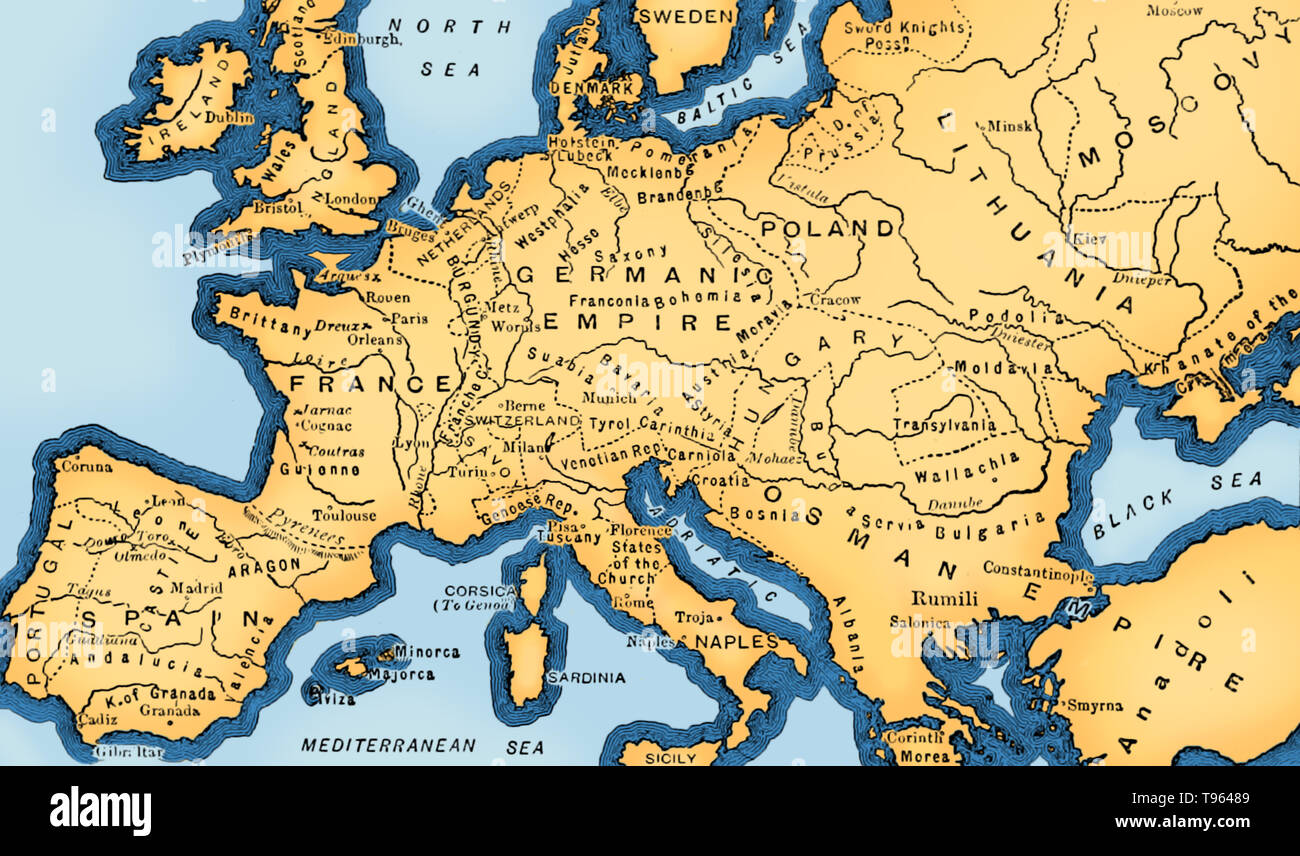 In Europe, the 15th century is seen as the bridge between the Late Middle Ages, the Early Renaissance, and the Early modern period. In the Age of Exploration, from the 15th century to the 17th century, European cartographers both copied earlier maps (some of which had been passed down for centuries) and drew their own based on explorers' observations and new surveying techniques. The invention of the magnetic compass, telescope and sextant enabled increasing accuracy. Image taken from page 52 of 'Cassell's Illustrated Universal History', 1893. This image has been color enhanced. Stock Photohttps://www.alamy.com/image-license-details/?v=1https://www.alamy.com/in-europe-the-15th-century-is-seen-as-the-bridge-between-the-late-middle-ages-the-early-renaissance-and-the-early-modern-period-in-the-age-of-exploration-from-the-15th-century-to-the-17th-century-european-cartographers-both-copied-earlier-maps-some-of-which-had-been-passed-down-for-centuries-and-drew-their-own-based-on-explorers-observations-and-new-surveying-techniques-the-invention-of-the-magnetic-compass-telescope-and-sextant-enabled-increasing-accuracy-image-taken-from-page-52-of-cassells-illustrated-universal-history-1893-this-image-has-been-color-enhanced-image246612137.html
In Europe, the 15th century is seen as the bridge between the Late Middle Ages, the Early Renaissance, and the Early modern period. In the Age of Exploration, from the 15th century to the 17th century, European cartographers both copied earlier maps (some of which had been passed down for centuries) and drew their own based on explorers' observations and new surveying techniques. The invention of the magnetic compass, telescope and sextant enabled increasing accuracy. Image taken from page 52 of 'Cassell's Illustrated Universal History', 1893. This image has been color enhanced. Stock Photohttps://www.alamy.com/image-license-details/?v=1https://www.alamy.com/in-europe-the-15th-century-is-seen-as-the-bridge-between-the-late-middle-ages-the-early-renaissance-and-the-early-modern-period-in-the-age-of-exploration-from-the-15th-century-to-the-17th-century-european-cartographers-both-copied-earlier-maps-some-of-which-had-been-passed-down-for-centuries-and-drew-their-own-based-on-explorers-observations-and-new-surveying-techniques-the-invention-of-the-magnetic-compass-telescope-and-sextant-enabled-increasing-accuracy-image-taken-from-page-52-of-cassells-illustrated-universal-history-1893-this-image-has-been-color-enhanced-image246612137.htmlRMT96489–In Europe, the 15th century is seen as the bridge between the Late Middle Ages, the Early Renaissance, and the Early modern period. In the Age of Exploration, from the 15th century to the 17th century, European cartographers both copied earlier maps (some of which had been passed down for centuries) and drew their own based on explorers' observations and new surveying techniques. The invention of the magnetic compass, telescope and sextant enabled increasing accuracy. Image taken from page 52 of 'Cassell's Illustrated Universal History', 1893. This image has been color enhanced.
 bucket, situla, lotus, with modern handle, temple ware, bronze, 13 cm, Late Period, Egypt Stock Photohttps://www.alamy.com/image-license-details/?v=1https://www.alamy.com/bucket-situla-lotus-with-modern-handle-temple-ware-bronze-13-cm-late-period-egypt-image344551599.html
bucket, situla, lotus, with modern handle, temple ware, bronze, 13 cm, Late Period, Egypt Stock Photohttps://www.alamy.com/image-license-details/?v=1https://www.alamy.com/bucket-situla-lotus-with-modern-handle-temple-ware-bronze-13-cm-late-period-egypt-image344551599.htmlRM2B0FK27–bucket, situla, lotus, with modern handle, temple ware, bronze, 13 cm, Late Period, Egypt
 An ancient Egyptian bronze statuette of Osiris, Late Period, mid- to end of the 1st millennium BC The god depicted as upright standing mummy with Atef crown, holding crook and flail against his chest. On a modern wooden base. Length 16 cm. Provenance: 1970s private collection from the Munich area. historic, historical, ancient world, Additional-Rights-Clearance-Info-Not-Available Stock Photohttps://www.alamy.com/image-license-details/?v=1https://www.alamy.com/an-ancient-egyptian-bronze-statuette-of-osiris-late-period-mid-to-end-of-the-1st-millennium-bc-the-god-depicted-as-upright-standing-mummy-with-atef-crown-holding-crook-and-flail-against-his-chest-on-a-modern-wooden-base-length-16-cm-provenance-1970s-private-collection-from-the-munich-area-historic-historical-ancient-world-additional-rights-clearance-info-not-available-image246352913.html
An ancient Egyptian bronze statuette of Osiris, Late Period, mid- to end of the 1st millennium BC The god depicted as upright standing mummy with Atef crown, holding crook and flail against his chest. On a modern wooden base. Length 16 cm. Provenance: 1970s private collection from the Munich area. historic, historical, ancient world, Additional-Rights-Clearance-Info-Not-Available Stock Photohttps://www.alamy.com/image-license-details/?v=1https://www.alamy.com/an-ancient-egyptian-bronze-statuette-of-osiris-late-period-mid-to-end-of-the-1st-millennium-bc-the-god-depicted-as-upright-standing-mummy-with-atef-crown-holding-crook-and-flail-against-his-chest-on-a-modern-wooden-base-length-16-cm-provenance-1970s-private-collection-from-the-munich-area-historic-historical-ancient-world-additional-rights-clearance-info-not-available-image246352913.htmlRMT8P9J9–An ancient Egyptian bronze statuette of Osiris, Late Period, mid- to end of the 1st millennium BC The god depicted as upright standing mummy with Atef crown, holding crook and flail against his chest. On a modern wooden base. Length 16 cm. Provenance: 1970s private collection from the Munich area. historic, historical, ancient world, Additional-Rights-Clearance-Info-Not-Available
 Art inspired by Mask of a man with short curly hair and long sideburns, Roman Period, A.D. late 1st century probably, From Egypt, Plaster, largely modern paint, h. 19 cm (7 1/2 in, Classic works modernized by Artotop with a splash of modernity. Shapes, color and value, eye-catching visual impact on art. Emotions through freedom of artworks in a contemporary way. A timeless message pursuing a wildly creative new direction. Artists turning to the digital medium and creating the Artotop NFT Stock Photohttps://www.alamy.com/image-license-details/?v=1https://www.alamy.com/art-inspired-by-mask-of-a-man-with-short-curly-hair-and-long-sideburns-roman-period-ad-late-1st-century-probably-from-egypt-plaster-largely-modern-paint-h-19-cm-7-12-in-classic-works-modernized-by-artotop-with-a-splash-of-modernity-shapes-color-and-value-eye-catching-visual-impact-on-art-emotions-through-freedom-of-artworks-in-a-contemporary-way-a-timeless-message-pursuing-a-wildly-creative-new-direction-artists-turning-to-the-digital-medium-and-creating-the-artotop-nft-image463037331.html
Art inspired by Mask of a man with short curly hair and long sideburns, Roman Period, A.D. late 1st century probably, From Egypt, Plaster, largely modern paint, h. 19 cm (7 1/2 in, Classic works modernized by Artotop with a splash of modernity. Shapes, color and value, eye-catching visual impact on art. Emotions through freedom of artworks in a contemporary way. A timeless message pursuing a wildly creative new direction. Artists turning to the digital medium and creating the Artotop NFT Stock Photohttps://www.alamy.com/image-license-details/?v=1https://www.alamy.com/art-inspired-by-mask-of-a-man-with-short-curly-hair-and-long-sideburns-roman-period-ad-late-1st-century-probably-from-egypt-plaster-largely-modern-paint-h-19-cm-7-12-in-classic-works-modernized-by-artotop-with-a-splash-of-modernity-shapes-color-and-value-eye-catching-visual-impact-on-art-emotions-through-freedom-of-artworks-in-a-contemporary-way-a-timeless-message-pursuing-a-wildly-creative-new-direction-artists-turning-to-the-digital-medium-and-creating-the-artotop-nft-image463037331.htmlRF2HW94RF–Art inspired by Mask of a man with short curly hair and long sideburns, Roman Period, A.D. late 1st century probably, From Egypt, Plaster, largely modern paint, h. 19 cm (7 1/2 in, Classic works modernized by Artotop with a splash of modernity. Shapes, color and value, eye-catching visual impact on art. Emotions through freedom of artworks in a contemporary way. A timeless message pursuing a wildly creative new direction. Artists turning to the digital medium and creating the Artotop NFT
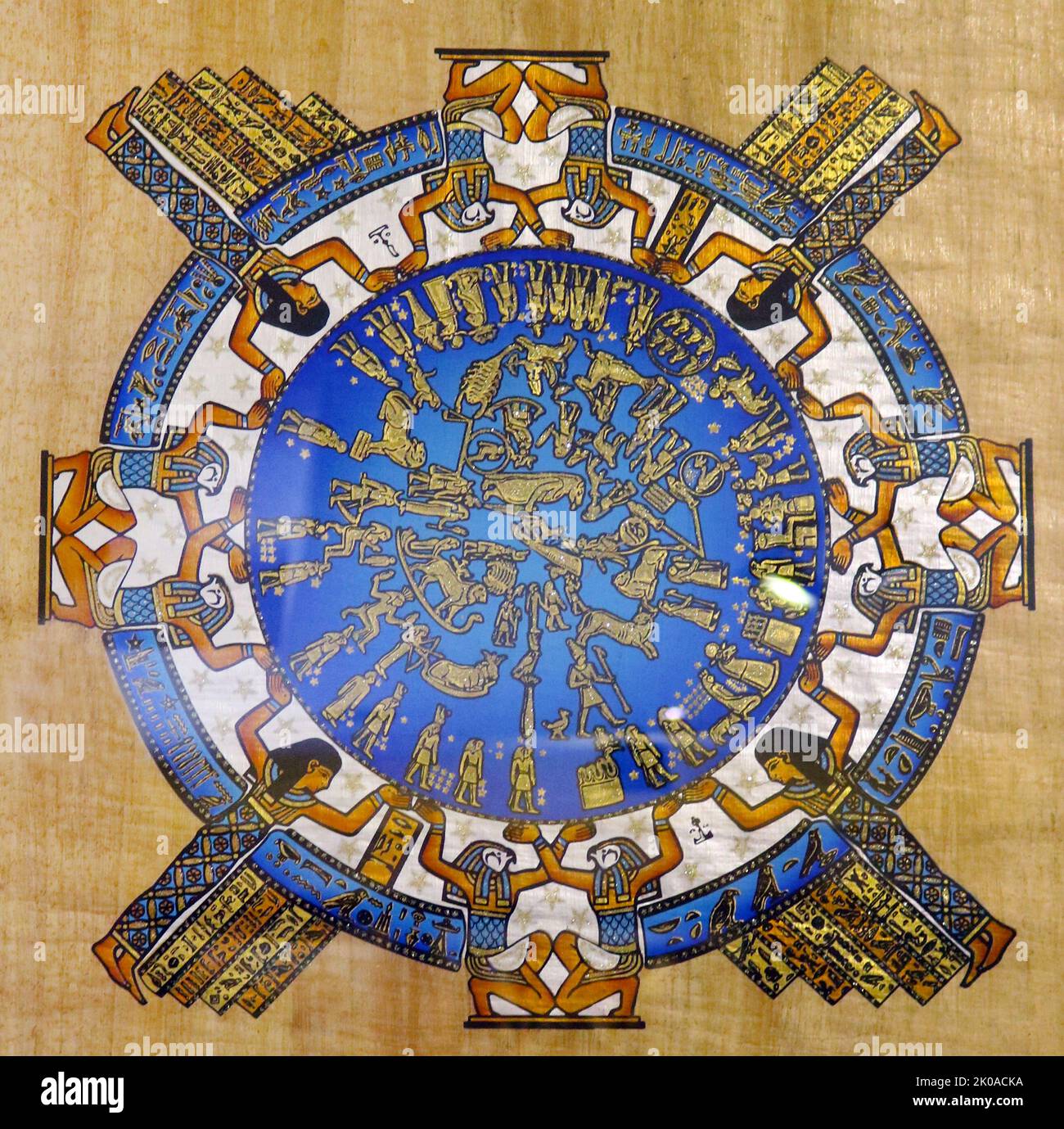 Modern payrus depicting the Dendera zodiac (or Denderah zodiac), an Egyptian bas-relief from the ceiling of the pronaos (or portico) of a chapel dedicated to Osiris in the Hathor temple at Dendera, containing images of Taurus (the bull) and Libra (the scales). This chapel was begun in the late Ptolemaic period; its pronaos was added by the emperor Tiberius. 2nd century AD Stock Photohttps://www.alamy.com/image-license-details/?v=1https://www.alamy.com/modern-payrus-depicting-the-dendera-zodiac-or-denderah-zodiac-an-egyptian-bas-relief-from-the-ceiling-of-the-pronaos-or-portico-of-a-chapel-dedicated-to-osiris-in-the-hathor-temple-at-dendera-containing-images-of-taurus-the-bull-and-libra-the-scales-this-chapel-was-begun-in-the-late-ptolemaic-period-its-pronaos-was-added-by-the-emperor-tiberius-2nd-century-ad-image482119774.html
Modern payrus depicting the Dendera zodiac (or Denderah zodiac), an Egyptian bas-relief from the ceiling of the pronaos (or portico) of a chapel dedicated to Osiris in the Hathor temple at Dendera, containing images of Taurus (the bull) and Libra (the scales). This chapel was begun in the late Ptolemaic period; its pronaos was added by the emperor Tiberius. 2nd century AD Stock Photohttps://www.alamy.com/image-license-details/?v=1https://www.alamy.com/modern-payrus-depicting-the-dendera-zodiac-or-denderah-zodiac-an-egyptian-bas-relief-from-the-ceiling-of-the-pronaos-or-portico-of-a-chapel-dedicated-to-osiris-in-the-hathor-temple-at-dendera-containing-images-of-taurus-the-bull-and-libra-the-scales-this-chapel-was-begun-in-the-late-ptolemaic-period-its-pronaos-was-added-by-the-emperor-tiberius-2nd-century-ad-image482119774.htmlRM2K0ACKA–Modern payrus depicting the Dendera zodiac (or Denderah zodiac), an Egyptian bas-relief from the ceiling of the pronaos (or portico) of a chapel dedicated to Osiris in the Hathor temple at Dendera, containing images of Taurus (the bull) and Libra (the scales). This chapel was begun in the late Ptolemaic period; its pronaos was added by the emperor Tiberius. 2nd century AD
 The Modern Musick-Master or The Universal Musician by Peter Prelleur Opening page of the book, published in London, 1731. Stock Photohttps://www.alamy.com/image-license-details/?v=1https://www.alamy.com/stock-image-the-modern-musick-master-or-the-universal-musician-by-peter-prelleur-163609416.html
The Modern Musick-Master or The Universal Musician by Peter Prelleur Opening page of the book, published in London, 1731. Stock Photohttps://www.alamy.com/image-license-details/?v=1https://www.alamy.com/stock-image-the-modern-musick-master-or-the-universal-musician-by-peter-prelleur-163609416.htmlRMKE51DC–The Modern Musick-Master or The Universal Musician by Peter Prelleur Opening page of the book, published in London, 1731.
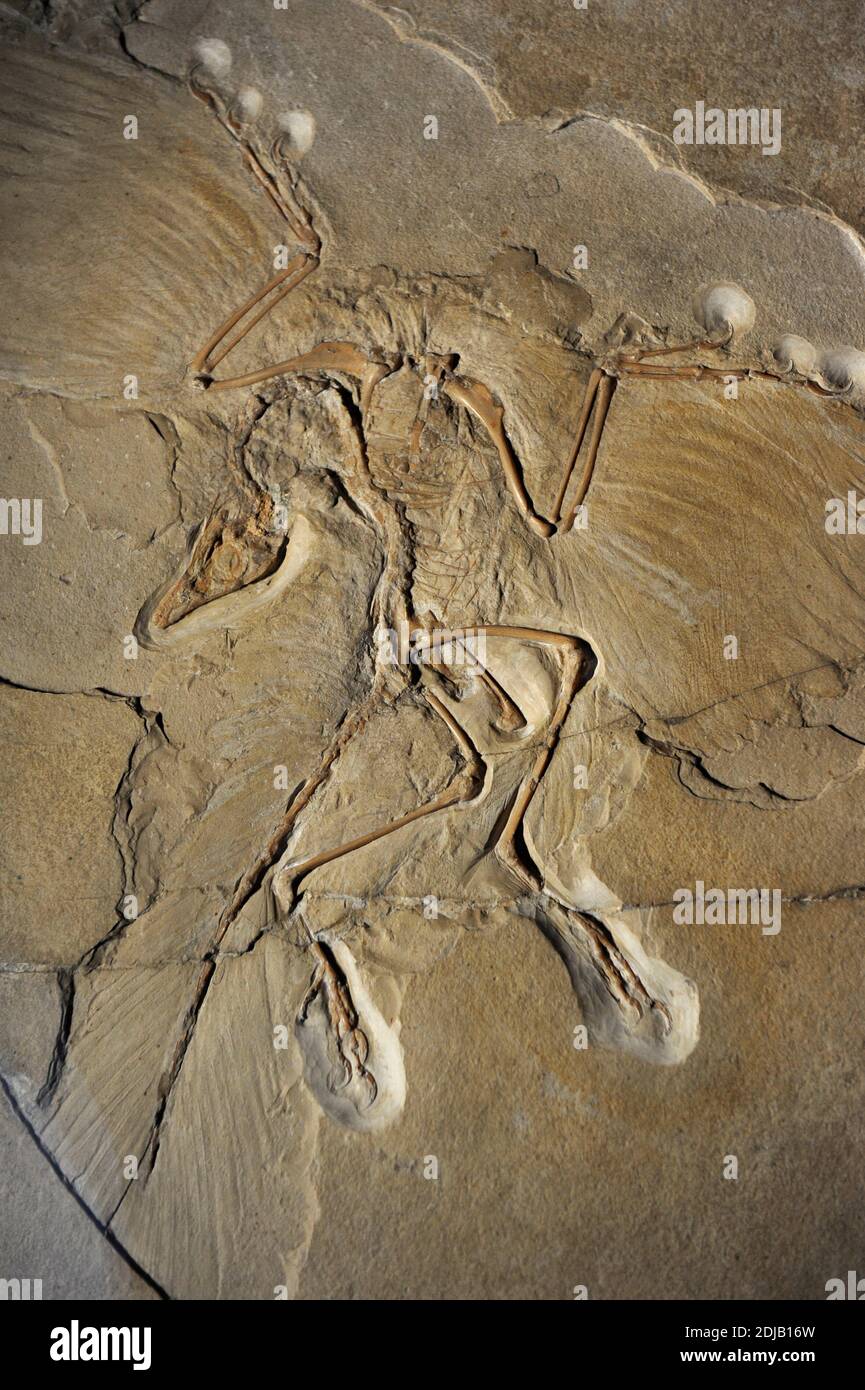 Archaeopteryx, sometimes referred to by its German name, Urvogel. Genus of bird-like dinosaurs that is transitional between non-avian feathered dinosaurs and modern birds. Jurassic period. 150 -145 million years ago. Fossil from Eichstatt, Germany. Natural History Museum, Berlin, Germany. Stock Photohttps://www.alamy.com/image-license-details/?v=1https://www.alamy.com/archaeopteryx-sometimes-referred-to-by-its-german-name-urvogel-genus-of-bird-like-dinosaurs-that-is-transitional-between-non-avian-feathered-dinosaurs-and-modern-birds-jurassic-period-150-145-million-years-ago-fossil-from-eichstatt-germany-natural-history-museum-berlin-germany-image389934353.html
Archaeopteryx, sometimes referred to by its German name, Urvogel. Genus of bird-like dinosaurs that is transitional between non-avian feathered dinosaurs and modern birds. Jurassic period. 150 -145 million years ago. Fossil from Eichstatt, Germany. Natural History Museum, Berlin, Germany. Stock Photohttps://www.alamy.com/image-license-details/?v=1https://www.alamy.com/archaeopteryx-sometimes-referred-to-by-its-german-name-urvogel-genus-of-bird-like-dinosaurs-that-is-transitional-between-non-avian-feathered-dinosaurs-and-modern-birds-jurassic-period-150-145-million-years-ago-fossil-from-eichstatt-germany-natural-history-museum-berlin-germany-image389934353.htmlRM2DJB16W–Archaeopteryx, sometimes referred to by its German name, Urvogel. Genus of bird-like dinosaurs that is transitional between non-avian feathered dinosaurs and modern birds. Jurassic period. 150 -145 million years ago. Fossil from Eichstatt, Germany. Natural History Museum, Berlin, Germany.
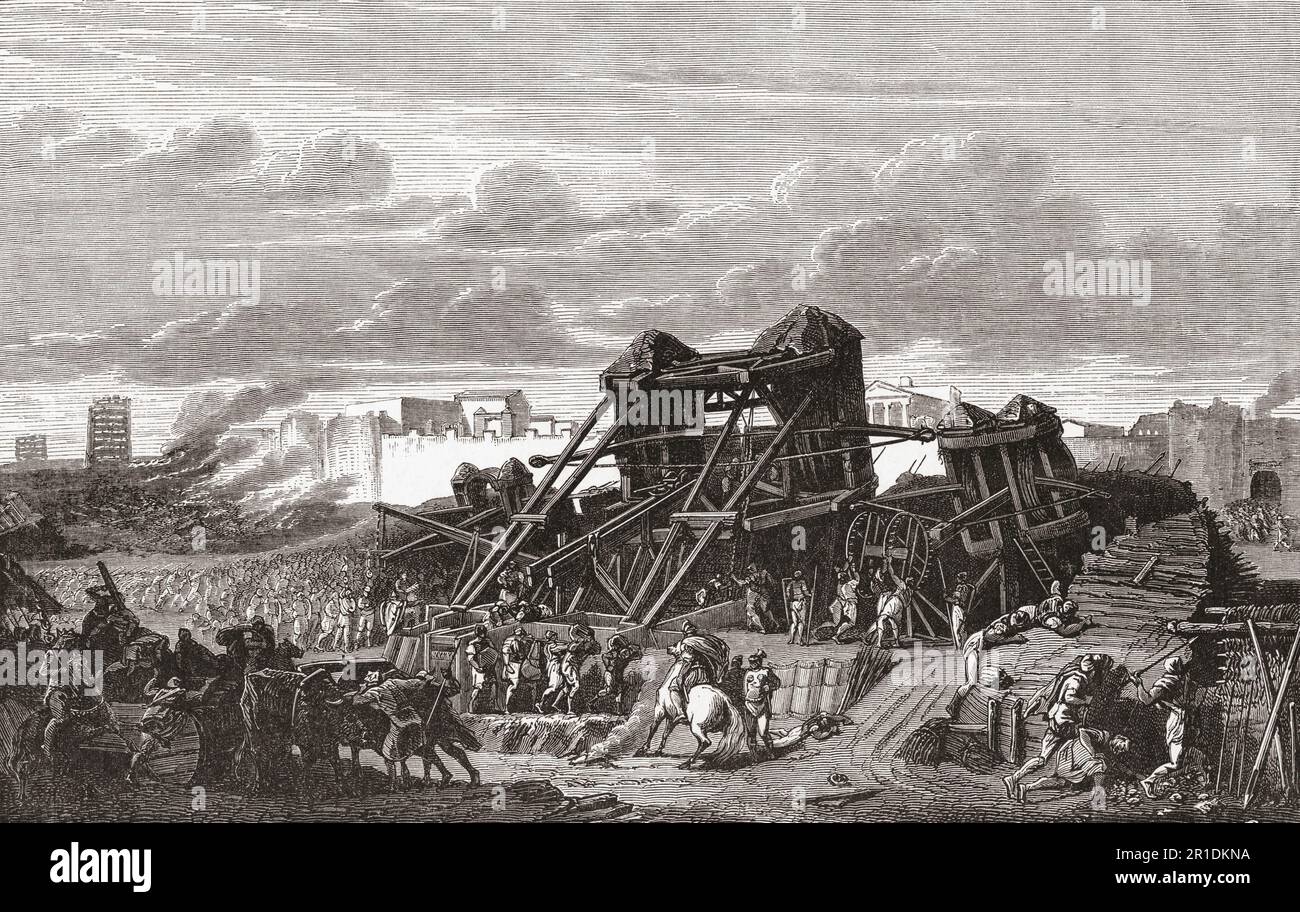 An imaginary reconstruction of the 49 BC Roman siege of Massilia - modern day Marseille - during Caesar's civil war. After a late 19th century work. Stock Photohttps://www.alamy.com/image-license-details/?v=1https://www.alamy.com/an-imaginary-reconstruction-of-the-49-bc-roman-siege-of-massilia-modern-day-marseille-during-caesars-civil-war-after-a-late-19th-century-work-image551647302.html
An imaginary reconstruction of the 49 BC Roman siege of Massilia - modern day Marseille - during Caesar's civil war. After a late 19th century work. Stock Photohttps://www.alamy.com/image-license-details/?v=1https://www.alamy.com/an-imaginary-reconstruction-of-the-49-bc-roman-siege-of-massilia-modern-day-marseille-during-caesars-civil-war-after-a-late-19th-century-work-image551647302.htmlRM2R1DKNA–An imaginary reconstruction of the 49 BC Roman siege of Massilia - modern day Marseille - during Caesar's civil war. After a late 19th century work.
 Bronze hydria (water jar). Culture: Greek. Dimensions: h: 17 in. (43.2 cm). Date: late 7th-early 6th century B.C.. This is one of the earliest of this kind of Archaic Greek bronze hydriae to have survived. The handles are cast. Portions of the hammered bronze body are a modern restoration. The three handles are particularly decorative, especially for this early period. The vertical handle has a pair of lion heads at the top whose features are rendered with a combination of volumetric modeling and chasing. A woman's head, shown from the neck up, appears at the bottom. Six long, hatched braids Stock Photohttps://www.alamy.com/image-license-details/?v=1https://www.alamy.com/bronze-hydria-water-jar-culture-greek-dimensions-h-17-in-432-cm-date-late-7th-early-6th-century-bc-this-is-one-of-the-earliest-of-this-kind-of-archaic-greek-bronze-hydriae-to-have-survived-the-handles-are-cast-portions-of-the-hammered-bronze-body-are-a-modern-restoration-the-three-handles-are-particularly-decorative-especially-for-this-early-period-the-vertical-handle-has-a-pair-of-lion-heads-at-the-top-whose-features-are-rendered-with-a-combination-of-volumetric-modeling-and-chasing-a-womans-head-shown-from-the-neck-up-appears-at-the-bottom-six-long-hatched-braids-image212909338.html
Bronze hydria (water jar). Culture: Greek. Dimensions: h: 17 in. (43.2 cm). Date: late 7th-early 6th century B.C.. This is one of the earliest of this kind of Archaic Greek bronze hydriae to have survived. The handles are cast. Portions of the hammered bronze body are a modern restoration. The three handles are particularly decorative, especially for this early period. The vertical handle has a pair of lion heads at the top whose features are rendered with a combination of volumetric modeling and chasing. A woman's head, shown from the neck up, appears at the bottom. Six long, hatched braids Stock Photohttps://www.alamy.com/image-license-details/?v=1https://www.alamy.com/bronze-hydria-water-jar-culture-greek-dimensions-h-17-in-432-cm-date-late-7th-early-6th-century-bc-this-is-one-of-the-earliest-of-this-kind-of-archaic-greek-bronze-hydriae-to-have-survived-the-handles-are-cast-portions-of-the-hammered-bronze-body-are-a-modern-restoration-the-three-handles-are-particularly-decorative-especially-for-this-early-period-the-vertical-handle-has-a-pair-of-lion-heads-at-the-top-whose-features-are-rendered-with-a-combination-of-volumetric-modeling-and-chasing-a-womans-head-shown-from-the-neck-up-appears-at-the-bottom-six-long-hatched-braids-image212909338.htmlRMPAAT0X–Bronze hydria (water jar). Culture: Greek. Dimensions: h: 17 in. (43.2 cm). Date: late 7th-early 6th century B.C.. This is one of the earliest of this kind of Archaic Greek bronze hydriae to have survived. The handles are cast. Portions of the hammered bronze body are a modern restoration. The three handles are particularly decorative, especially for this early period. The vertical handle has a pair of lion heads at the top whose features are rendered with a combination of volumetric modeling and chasing. A woman's head, shown from the neck up, appears at the bottom. Six long, hatched braids
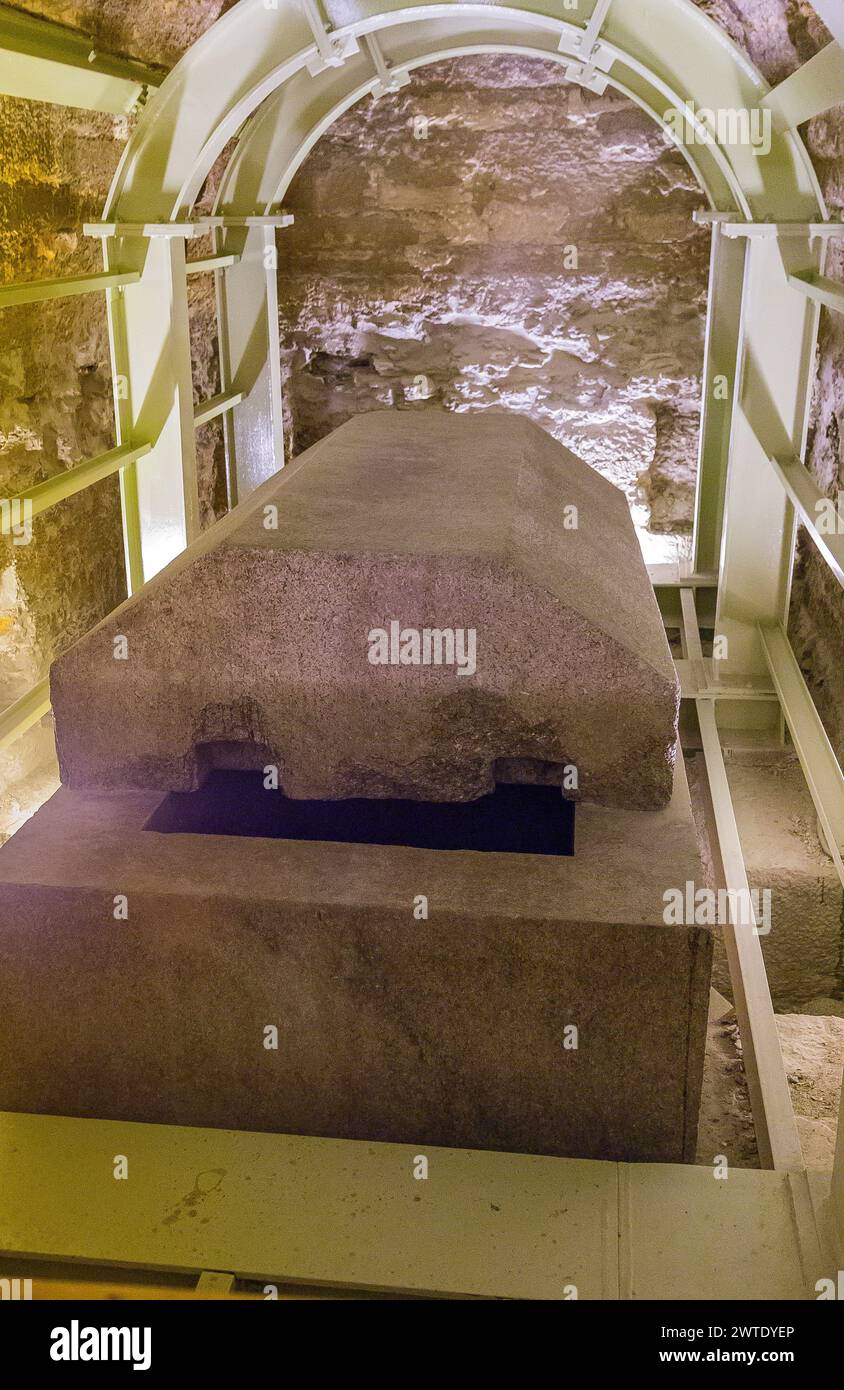 Egypt, Saqqara, Serapeum necropolis : An Apis bull sarcophagus, surrounded by modern iron consolidations. Stock Photohttps://www.alamy.com/image-license-details/?v=1https://www.alamy.com/egypt-saqqara-serapeum-necropolis-an-apis-bull-sarcophagus-surrounded-by-modern-iron-consolidations-image600211214.html
Egypt, Saqqara, Serapeum necropolis : An Apis bull sarcophagus, surrounded by modern iron consolidations. Stock Photohttps://www.alamy.com/image-license-details/?v=1https://www.alamy.com/egypt-saqqara-serapeum-necropolis-an-apis-bull-sarcophagus-surrounded-by-modern-iron-consolidations-image600211214.htmlRM2WTDYEP–Egypt, Saqqara, Serapeum necropolis : An Apis bull sarcophagus, surrounded by modern iron consolidations.
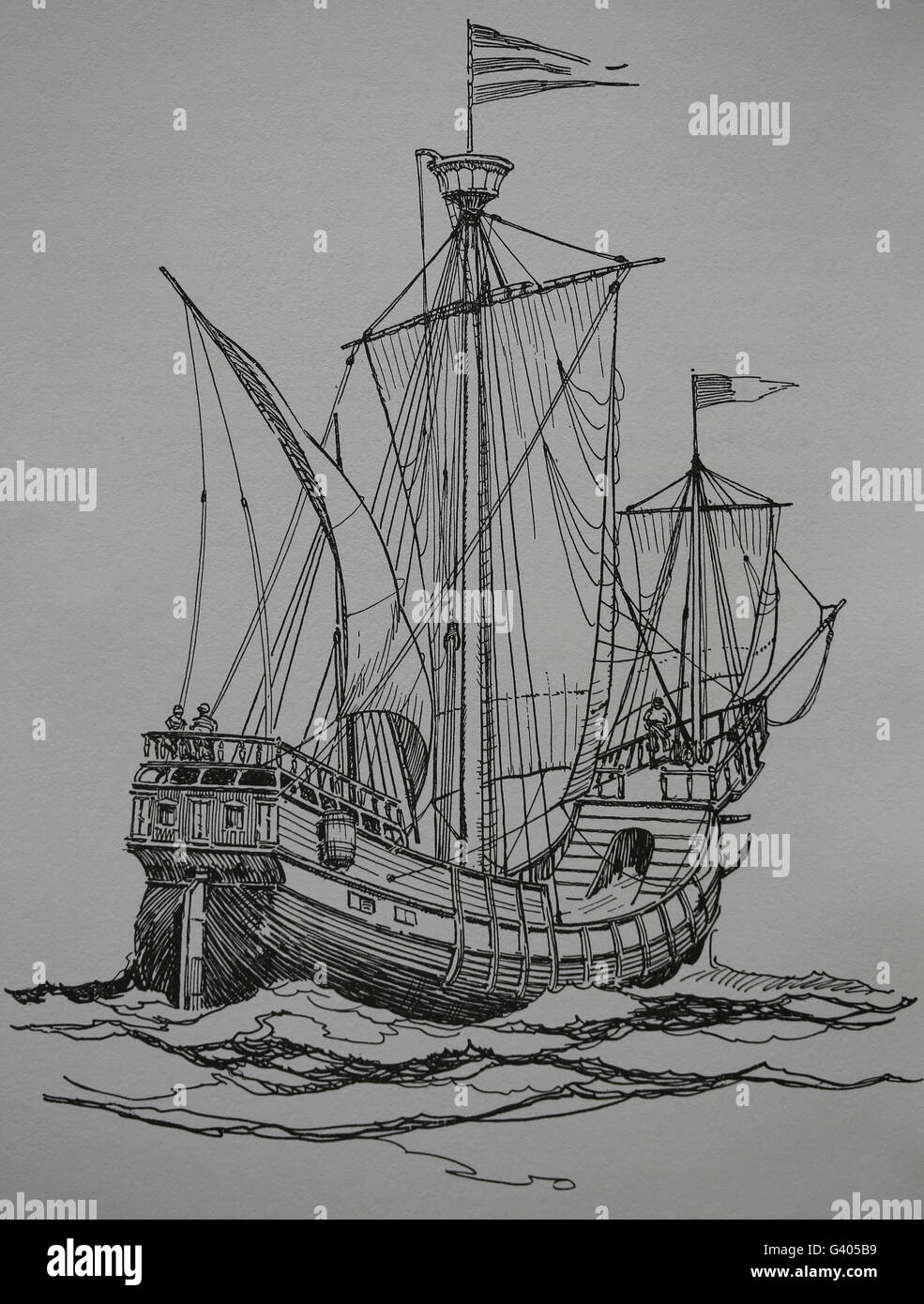 Modern Age. Late 16th century ship. Engraving, 19th century. Stock Photohttps://www.alamy.com/image-license-details/?v=1https://www.alamy.com/stock-photo-modern-age-late-16th-century-ship-engraving-19th-century-105725069.html
Modern Age. Late 16th century ship. Engraving, 19th century. Stock Photohttps://www.alamy.com/image-license-details/?v=1https://www.alamy.com/stock-photo-modern-age-late-16th-century-ship-engraving-19th-century-105725069.htmlRMG405B9–Modern Age. Late 16th century ship. Engraving, 19th century.
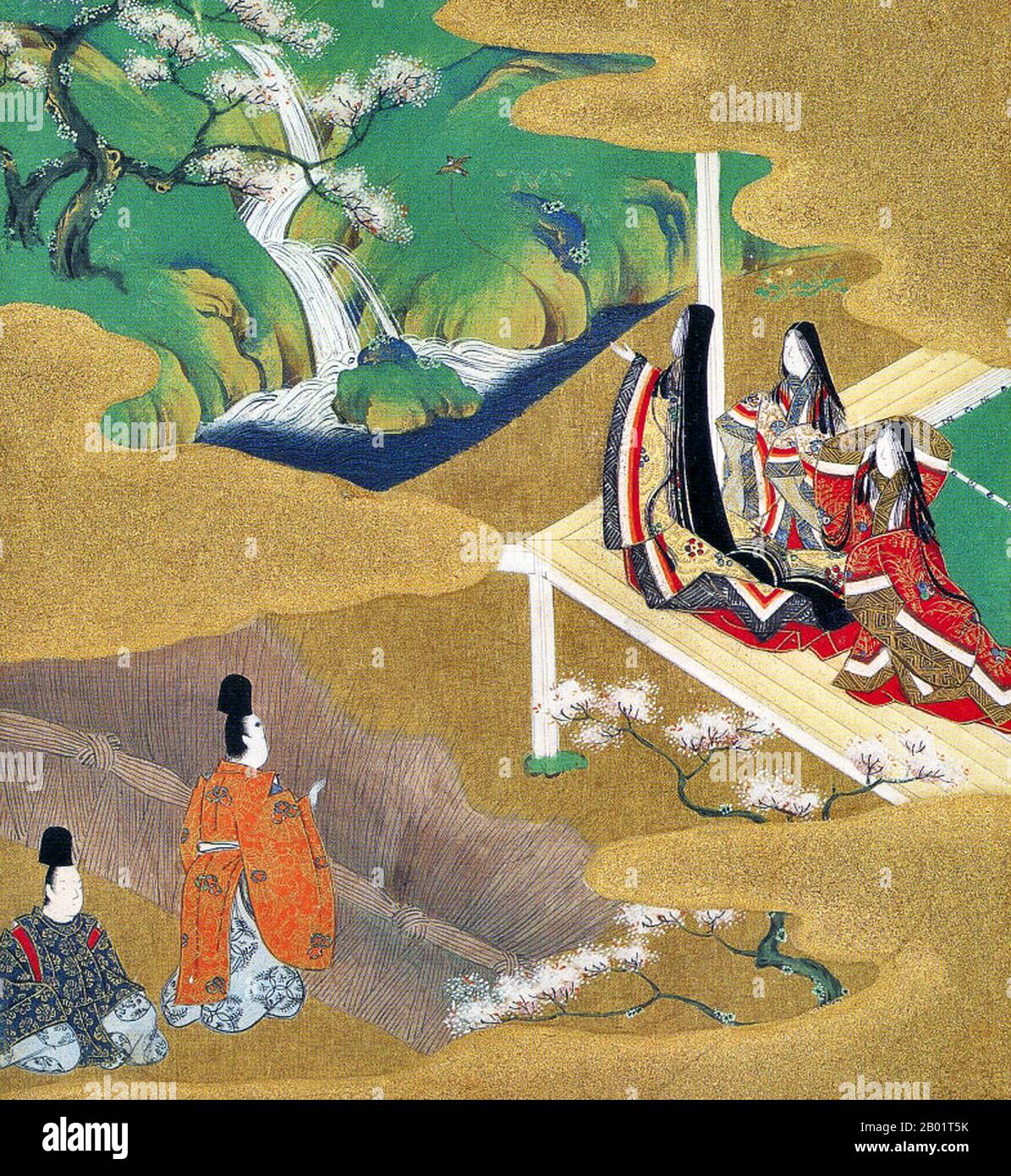 Japan: 'Chapter 5 - Wakamurasaki' from the 'Tale of Genji'. Painting by Tosa Mitsuoki (23 October 1617 - 25 September 1691), late 17th century. The Tale of Genji (Genji Monogatari) is a classic work of Japanese literature attributed to the Japanese noblewoman Murasaki Shikibu in the early 11th century, around the peak of the Heian period. It is sometimes called the world's first novel, the first modern novel, the first psychological novel or the first novel still to be considered a classic. Notably, the novel also illustrates a unique depiction of the livelihoods of Heian Era high courtiers. Stock Photohttps://www.alamy.com/image-license-details/?v=1https://www.alamy.com/japan-chapter-5-wakamurasaki-from-the-tale-of-genji-painting-by-tosa-mitsuoki-23-october-1617-25-september-1691-late-17th-century-the-tale-of-genji-genji-monogatari-is-a-classic-work-of-japanese-literature-attributed-to-the-japanese-noblewoman-murasaki-shikibu-in-the-early-11th-century-around-the-peak-of-the-heian-period-it-is-sometimes-called-the-worlds-first-novel-the-first-modern-novel-the-first-psychological-novel-or-the-first-novel-still-to-be-considered-a-classic-notably-the-novel-also-illustrates-a-unique-depiction-of-the-livelihoods-of-heian-era-high-courtiers-image344248287.html
Japan: 'Chapter 5 - Wakamurasaki' from the 'Tale of Genji'. Painting by Tosa Mitsuoki (23 October 1617 - 25 September 1691), late 17th century. The Tale of Genji (Genji Monogatari) is a classic work of Japanese literature attributed to the Japanese noblewoman Murasaki Shikibu in the early 11th century, around the peak of the Heian period. It is sometimes called the world's first novel, the first modern novel, the first psychological novel or the first novel still to be considered a classic. Notably, the novel also illustrates a unique depiction of the livelihoods of Heian Era high courtiers. Stock Photohttps://www.alamy.com/image-license-details/?v=1https://www.alamy.com/japan-chapter-5-wakamurasaki-from-the-tale-of-genji-painting-by-tosa-mitsuoki-23-october-1617-25-september-1691-late-17th-century-the-tale-of-genji-genji-monogatari-is-a-classic-work-of-japanese-literature-attributed-to-the-japanese-noblewoman-murasaki-shikibu-in-the-early-11th-century-around-the-peak-of-the-heian-period-it-is-sometimes-called-the-worlds-first-novel-the-first-modern-novel-the-first-psychological-novel-or-the-first-novel-still-to-be-considered-a-classic-notably-the-novel-also-illustrates-a-unique-depiction-of-the-livelihoods-of-heian-era-high-courtiers-image344248287.htmlRM2B01T5K–Japan: 'Chapter 5 - Wakamurasaki' from the 'Tale of Genji'. Painting by Tosa Mitsuoki (23 October 1617 - 25 September 1691), late 17th century. The Tale of Genji (Genji Monogatari) is a classic work of Japanese literature attributed to the Japanese noblewoman Murasaki Shikibu in the early 11th century, around the peak of the Heian period. It is sometimes called the world's first novel, the first modern novel, the first psychological novel or the first novel still to be considered a classic. Notably, the novel also illustrates a unique depiction of the livelihoods of Heian Era high courtiers.
 Log house, Marshal Zhukov Street #95 (around 1900), foreground, and in the background is a typical modern apartment building of the post Soviet period (late 1990s), Omsk, Russia 1999. Stock Photohttps://www.alamy.com/image-license-details/?v=1https://www.alamy.com/log-house-marshal-zhukov-street-95-around-1900-foreground-and-in-the-background-is-a-typical-modern-apartment-building-of-the-post-soviet-period-late-1990s-omsk-russia-1999-image438319579.html
Log house, Marshal Zhukov Street #95 (around 1900), foreground, and in the background is a typical modern apartment building of the post Soviet period (late 1990s), Omsk, Russia 1999. Stock Photohttps://www.alamy.com/image-license-details/?v=1https://www.alamy.com/log-house-marshal-zhukov-street-95-around-1900-foreground-and-in-the-background-is-a-typical-modern-apartment-building-of-the-post-soviet-period-late-1990s-omsk-russia-1999-image438319579.htmlRM2GD352K–Log house, Marshal Zhukov Street #95 (around 1900), foreground, and in the background is a typical modern apartment building of the post Soviet period (late 1990s), Omsk, Russia 1999.
RF2G1K9WH–Clock, period, hours icon. Vector illustration. Flat.
 . English: Uesugi Kenshin with Two Retainers, Niigata Prefectural Museum of Modern Art, Nagaoka, Niigata, Japan 日本語: 紙本著色上杉謙信並二臣像 . late Muromachi period (C16). Muromachi-period artist 25 Uesugi Kenshin with Two Retainers (Niigata Prefectural Museum of Modern Art) Stock Photohttps://www.alamy.com/image-license-details/?v=1https://www.alamy.com/english-uesugi-kenshin-with-two-retainers-niigata-prefectural-museum-of-modern-art-nagaoka-niigata-japan-late-muromachi-period-c16-muromachi-period-artist-25-uesugi-kenshin-with-two-retainers-niigata-prefectural-museum-of-modern-art-image206574998.html
. English: Uesugi Kenshin with Two Retainers, Niigata Prefectural Museum of Modern Art, Nagaoka, Niigata, Japan 日本語: 紙本著色上杉謙信並二臣像 . late Muromachi period (C16). Muromachi-period artist 25 Uesugi Kenshin with Two Retainers (Niigata Prefectural Museum of Modern Art) Stock Photohttps://www.alamy.com/image-license-details/?v=1https://www.alamy.com/english-uesugi-kenshin-with-two-retainers-niigata-prefectural-museum-of-modern-art-nagaoka-niigata-japan-late-muromachi-period-c16-muromachi-period-artist-25-uesugi-kenshin-with-two-retainers-niigata-prefectural-museum-of-modern-art-image206574998.htmlRMP028EE–. English: Uesugi Kenshin with Two Retainers, Niigata Prefectural Museum of Modern Art, Nagaoka, Niigata, Japan 日本語: 紙本著色上杉謙信並二臣像 . late Muromachi period (C16). Muromachi-period artist 25 Uesugi Kenshin with Two Retainers (Niigata Prefectural Museum of Modern Art)
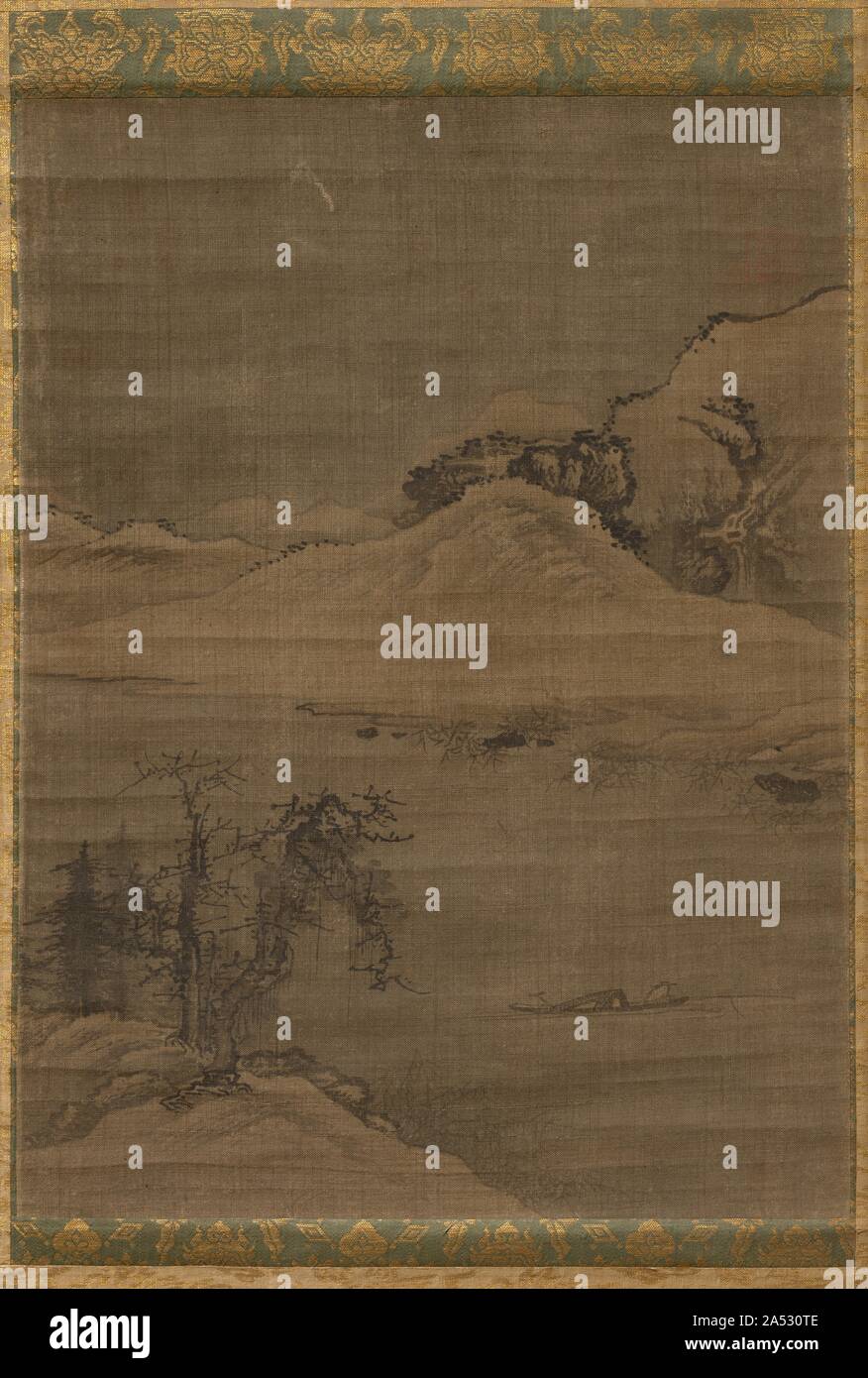 Landscape with Fishermen, 1600s. Surviving paintings of the early Choson period in Korea, while not numerous, provide modern viewers with a consistent ensemble of subject matter, painting formats, and stylistic approaches. Along with landscape painting, animal, bird, and flower paintings, a few portraits, grapes, bamboo, figural compositions, and kyehoe-do (commem-orative rites scenes) make up the basic repertoire of subjects. The late 15th- and 16th-century landscapes that have survived, however, are modest in format. Korean painters preferred to work in a restricted compositional arena. The Stock Photohttps://www.alamy.com/image-license-details/?v=1https://www.alamy.com/landscape-with-fishermen-1600s-surviving-paintings-of-the-early-choson-period-in-korea-while-not-numerous-provide-modern-viewers-with-a-consistent-ensemble-of-subject-matter-painting-formats-and-stylistic-approaches-along-with-landscape-painting-animal-bird-and-flower-paintings-a-few-portraits-grapes-bamboo-figural-compositions-and-kyehoe-do-commem-orative-rites-scenes-make-up-the-basic-repertoire-of-subjects-the-late-15th-and-16th-century-landscapes-that-have-survived-however-are-modest-in-format-korean-painters-preferred-to-work-in-a-restricted-compositional-arena-the-image330136814.html
Landscape with Fishermen, 1600s. Surviving paintings of the early Choson period in Korea, while not numerous, provide modern viewers with a consistent ensemble of subject matter, painting formats, and stylistic approaches. Along with landscape painting, animal, bird, and flower paintings, a few portraits, grapes, bamboo, figural compositions, and kyehoe-do (commem-orative rites scenes) make up the basic repertoire of subjects. The late 15th- and 16th-century landscapes that have survived, however, are modest in format. Korean painters preferred to work in a restricted compositional arena. The Stock Photohttps://www.alamy.com/image-license-details/?v=1https://www.alamy.com/landscape-with-fishermen-1600s-surviving-paintings-of-the-early-choson-period-in-korea-while-not-numerous-provide-modern-viewers-with-a-consistent-ensemble-of-subject-matter-painting-formats-and-stylistic-approaches-along-with-landscape-painting-animal-bird-and-flower-paintings-a-few-portraits-grapes-bamboo-figural-compositions-and-kyehoe-do-commem-orative-rites-scenes-make-up-the-basic-repertoire-of-subjects-the-late-15th-and-16th-century-landscapes-that-have-survived-however-are-modest-in-format-korean-painters-preferred-to-work-in-a-restricted-compositional-arena-the-image330136814.htmlRM2A530TE–Landscape with Fishermen, 1600s. Surviving paintings of the early Choson period in Korea, while not numerous, provide modern viewers with a consistent ensemble of subject matter, painting formats, and stylistic approaches. Along with landscape painting, animal, bird, and flower paintings, a few portraits, grapes, bamboo, figural compositions, and kyehoe-do (commem-orative rites scenes) make up the basic repertoire of subjects. The late 15th- and 16th-century landscapes that have survived, however, are modest in format. Korean painters preferred to work in a restricted compositional arena. The
 2,000 people will dance to three jazz bands on the Old Pier, Birnbeck Island, Weston-super-Mare when 'Weston Rock' is held as part of the Bath Festival Although dancers in modern dress will be admitted, the aim is to continue the late 19th century theme started by the main festival fringe vent 'Paris Soir 1890' the week before. The organisers hope that as many people as possible will turn up in bathing costumes and beach suits of that period. Jean Richardson, aged 23 from Bath, wears an 1890 bathing costume as she leaps high in the air. March 1963 P018123 Stock Photohttps://www.alamy.com/image-license-details/?v=1https://www.alamy.com/stock-photo-2000-people-will-dance-to-three-jazz-bands-on-the-old-pier-birnbeck-20360542.html
2,000 people will dance to three jazz bands on the Old Pier, Birnbeck Island, Weston-super-Mare when 'Weston Rock' is held as part of the Bath Festival Although dancers in modern dress will be admitted, the aim is to continue the late 19th century theme started by the main festival fringe vent 'Paris Soir 1890' the week before. The organisers hope that as many people as possible will turn up in bathing costumes and beach suits of that period. Jean Richardson, aged 23 from Bath, wears an 1890 bathing costume as she leaps high in the air. March 1963 P018123 Stock Photohttps://www.alamy.com/image-license-details/?v=1https://www.alamy.com/stock-photo-2000-people-will-dance-to-three-jazz-bands-on-the-old-pier-birnbeck-20360542.htmlRMB53E26–2,000 people will dance to three jazz bands on the Old Pier, Birnbeck Island, Weston-super-Mare when 'Weston Rock' is held as part of the Bath Festival Although dancers in modern dress will be admitted, the aim is to continue the late 19th century theme started by the main festival fringe vent 'Paris Soir 1890' the week before. The organisers hope that as many people as possible will turn up in bathing costumes and beach suits of that period. Jean Richardson, aged 23 from Bath, wears an 1890 bathing costume as she leaps high in the air. March 1963 P018123
 Romford Essex England. Photographed July 1970 but scans made in 2017 Small market town to the east of London embraces modern architecture from the late 1960's to 1970. Stock Photohttps://www.alamy.com/image-license-details/?v=1https://www.alamy.com/stock-image-romford-essex-england-photographed-july-1970-but-scans-made-in-2017-168547289.html
Romford Essex England. Photographed July 1970 but scans made in 2017 Small market town to the east of London embraces modern architecture from the late 1960's to 1970. Stock Photohttps://www.alamy.com/image-license-details/?v=1https://www.alamy.com/stock-image-romford-essex-england-photographed-july-1970-but-scans-made-in-2017-168547289.htmlRMKP5YP1–Romford Essex England. Photographed July 1970 but scans made in 2017 Small market town to the east of London embraces modern architecture from the late 1960's to 1970.
 A rare old French Latin Manuscript illustration from Roman de Renart showing -The leopard and several other beasts assailing Renart's (Reynard the fox) Castle in a scene from the medieval allegorical Dutch, English, French and German fables which occur throughot history from the 12th century, throughout the Late Middle Ages, and in chapbooks etc throughout the Early Modern period. Stock Photohttps://www.alamy.com/image-license-details/?v=1https://www.alamy.com/a-rare-old-french-latin-manuscript-illustration-from-roman-de-renart-showing-the-leopard-and-several-other-beasts-assailing-renarts-reynard-the-fox-castle-in-a-scene-from-the-medieval-allegorical-dutch-english-french-and-german-fables-which-occur-throughot-history-from-the-12th-century-throughout-the-late-middle-ages-and-in-chapbooks-etc-throughout-the-early-modern-period-image336007377.html
A rare old French Latin Manuscript illustration from Roman de Renart showing -The leopard and several other beasts assailing Renart's (Reynard the fox) Castle in a scene from the medieval allegorical Dutch, English, French and German fables which occur throughot history from the 12th century, throughout the Late Middle Ages, and in chapbooks etc throughout the Early Modern period. Stock Photohttps://www.alamy.com/image-license-details/?v=1https://www.alamy.com/a-rare-old-french-latin-manuscript-illustration-from-roman-de-renart-showing-the-leopard-and-several-other-beasts-assailing-renarts-reynard-the-fox-castle-in-a-scene-from-the-medieval-allegorical-dutch-english-french-and-german-fables-which-occur-throughot-history-from-the-12th-century-throughout-the-late-middle-ages-and-in-chapbooks-etc-throughout-the-early-modern-period-image336007377.htmlRM2AEJCRD–A rare old French Latin Manuscript illustration from Roman de Renart showing -The leopard and several other beasts assailing Renart's (Reynard the fox) Castle in a scene from the medieval allegorical Dutch, English, French and German fables which occur throughot history from the 12th century, throughout the Late Middle Ages, and in chapbooks etc throughout the Early Modern period.
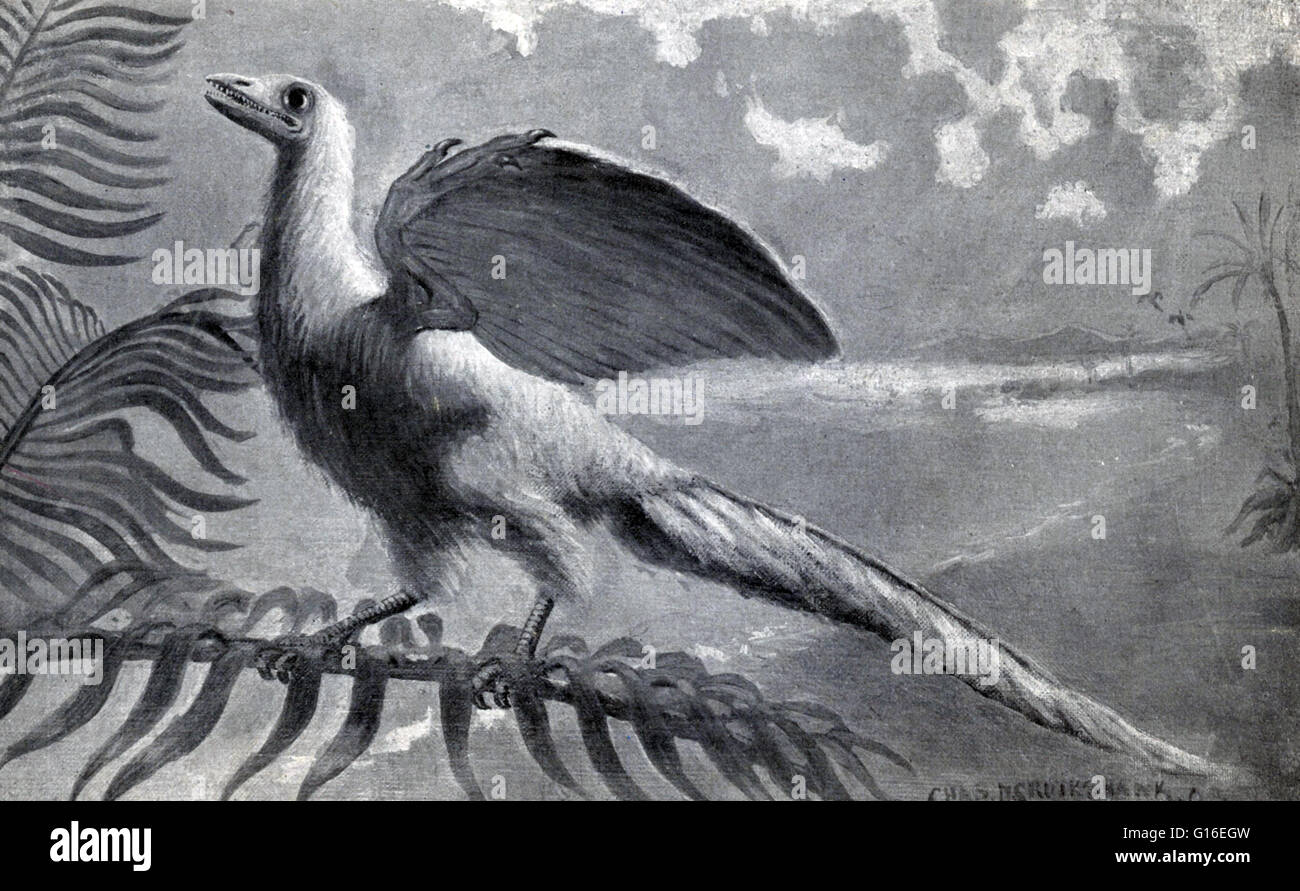 Archaeopteryx, sometimes referred to by its German name Urvogel (original bird or first bird), is a genus of early bird that is transitional between feathered dinosaurs and modern birds. It lived in the Late Jurassic period around 150 million years ago ha Stock Photohttps://www.alamy.com/image-license-details/?v=1https://www.alamy.com/stock-photo-archaeopteryx-sometimes-referred-to-by-its-german-name-urvogel-original-104020025.html
Archaeopteryx, sometimes referred to by its German name Urvogel (original bird or first bird), is a genus of early bird that is transitional between feathered dinosaurs and modern birds. It lived in the Late Jurassic period around 150 million years ago ha Stock Photohttps://www.alamy.com/image-license-details/?v=1https://www.alamy.com/stock-photo-archaeopteryx-sometimes-referred-to-by-its-german-name-urvogel-original-104020025.htmlRMG16EGW–Archaeopteryx, sometimes referred to by its German name Urvogel (original bird or first bird), is a genus of early bird that is transitional between feathered dinosaurs and modern birds. It lived in the Late Jurassic period around 150 million years ago ha
 ichneumon, standing on modern pedestal, bronze, animal, bronze, height: 2.5 cm, depth: 12 cm, Late Period (?), Egypt Stock Photohttps://www.alamy.com/image-license-details/?v=1https://www.alamy.com/ichneumon-standing-on-modern-pedestal-bronze-animal-bronze-height-25-cm-depth-12-cm-late-period-egypt-image344554003.html
ichneumon, standing on modern pedestal, bronze, animal, bronze, height: 2.5 cm, depth: 12 cm, Late Period (?), Egypt Stock Photohttps://www.alamy.com/image-license-details/?v=1https://www.alamy.com/ichneumon-standing-on-modern-pedestal-bronze-animal-bronze-height-25-cm-depth-12-cm-late-period-egypt-image344554003.htmlRM2B0FP43–ichneumon, standing on modern pedestal, bronze, animal, bronze, height: 2.5 cm, depth: 12 cm, Late Period (?), Egypt
 An ancient Egyptian bronze statuette of Osiris, Late Period, mid- to end of the 1st millennium BC The god depicted as upright standing mummy with Atef crown, holding crook and flail against his chest. On a modern wooden base. Length 16 cm. Provenance: 1970s private collection from the Munich area. historic, historical, ancient world, Additional-Rights-Clearance-Info-Not-Available Stock Photohttps://www.alamy.com/image-license-details/?v=1https://www.alamy.com/an-ancient-egyptian-bronze-statuette-of-osiris-late-period-mid-to-end-of-the-1st-millennium-bc-the-god-depicted-as-upright-standing-mummy-with-atef-crown-holding-crook-and-flail-against-his-chest-on-a-modern-wooden-base-length-16-cm-provenance-1970s-private-collection-from-the-munich-area-historic-historical-ancient-world-additional-rights-clearance-info-not-available-image246352910.html
An ancient Egyptian bronze statuette of Osiris, Late Period, mid- to end of the 1st millennium BC The god depicted as upright standing mummy with Atef crown, holding crook and flail against his chest. On a modern wooden base. Length 16 cm. Provenance: 1970s private collection from the Munich area. historic, historical, ancient world, Additional-Rights-Clearance-Info-Not-Available Stock Photohttps://www.alamy.com/image-license-details/?v=1https://www.alamy.com/an-ancient-egyptian-bronze-statuette-of-osiris-late-period-mid-to-end-of-the-1st-millennium-bc-the-god-depicted-as-upright-standing-mummy-with-atef-crown-holding-crook-and-flail-against-his-chest-on-a-modern-wooden-base-length-16-cm-provenance-1970s-private-collection-from-the-munich-area-historic-historical-ancient-world-additional-rights-clearance-info-not-available-image246352910.htmlRMT8P9J6–An ancient Egyptian bronze statuette of Osiris, Late Period, mid- to end of the 1st millennium BC The god depicted as upright standing mummy with Atef crown, holding crook and flail against his chest. On a modern wooden base. Length 16 cm. Provenance: 1970s private collection from the Munich area. historic, historical, ancient world, Additional-Rights-Clearance-Info-Not-Available
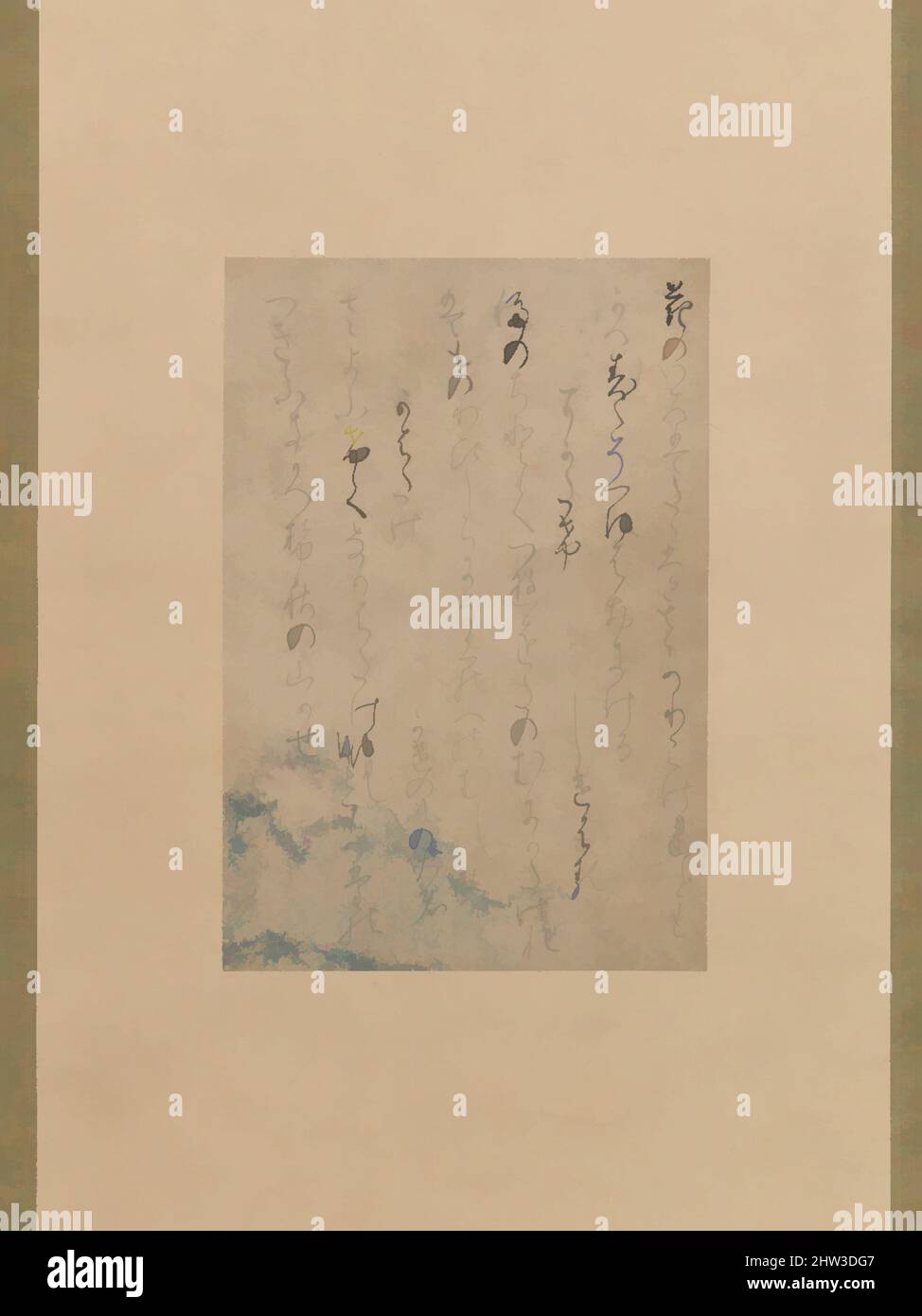 Art inspired by Three Poems from the “Collection of Poems Ancient and Modern” (Kokin wakashū), known as the “Araki Fragment”, (Araki-gire), late Heian period (ca. 900–1185), 2nd half of the 11th century, Japan, Album leaf mounted as a hanging scroll; ink on paper, Image: 8 in. × 5 3/8, Classic works modernized by Artotop with a splash of modernity. Shapes, color and value, eye-catching visual impact on art. Emotions through freedom of artworks in a contemporary way. A timeless message pursuing a wildly creative new direction. Artists turning to the digital medium and creating the Artotop NFT Stock Photohttps://www.alamy.com/image-license-details/?v=1https://www.alamy.com/art-inspired-by-three-poems-from-the-collection-of-poems-ancient-and-modern-kokin-wakash-known-as-the-araki-fragment-araki-gire-late-heian-period-ca-9001185-2nd-half-of-the-11th-century-japan-album-leaf-mounted-as-a-hanging-scroll-ink-on-paper-image-8-in-5-38-classic-works-modernized-by-artotop-with-a-splash-of-modernity-shapes-color-and-value-eye-catching-visual-impact-on-art-emotions-through-freedom-of-artworks-in-a-contemporary-way-a-timeless-message-pursuing-a-wildly-creative-new-direction-artists-turning-to-the-digital-medium-and-creating-the-artotop-nft-image462912471.html
Art inspired by Three Poems from the “Collection of Poems Ancient and Modern” (Kokin wakashū), known as the “Araki Fragment”, (Araki-gire), late Heian period (ca. 900–1185), 2nd half of the 11th century, Japan, Album leaf mounted as a hanging scroll; ink on paper, Image: 8 in. × 5 3/8, Classic works modernized by Artotop with a splash of modernity. Shapes, color and value, eye-catching visual impact on art. Emotions through freedom of artworks in a contemporary way. A timeless message pursuing a wildly creative new direction. Artists turning to the digital medium and creating the Artotop NFT Stock Photohttps://www.alamy.com/image-license-details/?v=1https://www.alamy.com/art-inspired-by-three-poems-from-the-collection-of-poems-ancient-and-modern-kokin-wakash-known-as-the-araki-fragment-araki-gire-late-heian-period-ca-9001185-2nd-half-of-the-11th-century-japan-album-leaf-mounted-as-a-hanging-scroll-ink-on-paper-image-8-in-5-38-classic-works-modernized-by-artotop-with-a-splash-of-modernity-shapes-color-and-value-eye-catching-visual-impact-on-art-emotions-through-freedom-of-artworks-in-a-contemporary-way-a-timeless-message-pursuing-a-wildly-creative-new-direction-artists-turning-to-the-digital-medium-and-creating-the-artotop-nft-image462912471.htmlRF2HW3DG7–Art inspired by Three Poems from the “Collection of Poems Ancient and Modern” (Kokin wakashū), known as the “Araki Fragment”, (Araki-gire), late Heian period (ca. 900–1185), 2nd half of the 11th century, Japan, Album leaf mounted as a hanging scroll; ink on paper, Image: 8 in. × 5 3/8, Classic works modernized by Artotop with a splash of modernity. Shapes, color and value, eye-catching visual impact on art. Emotions through freedom of artworks in a contemporary way. A timeless message pursuing a wildly creative new direction. Artists turning to the digital medium and creating the Artotop NFT
 Photograph of Jean Sibelius (1865-1957) a Finnish composer and violinist of the late-Romantic and early-modern period. Dated 20th Century Stock Photohttps://www.alamy.com/image-license-details/?v=1https://www.alamy.com/stock-image-photograph-of-jean-sibelius-1865-1957-a-finnish-composer-and-violinist-162593302.html
Photograph of Jean Sibelius (1865-1957) a Finnish composer and violinist of the late-Romantic and early-modern period. Dated 20th Century Stock Photohttps://www.alamy.com/image-license-details/?v=1https://www.alamy.com/stock-image-photograph-of-jean-sibelius-1865-1957-a-finnish-composer-and-violinist-162593302.htmlRMKCENBJ–Photograph of Jean Sibelius (1865-1957) a Finnish composer and violinist of the late-Romantic and early-modern period. Dated 20th Century
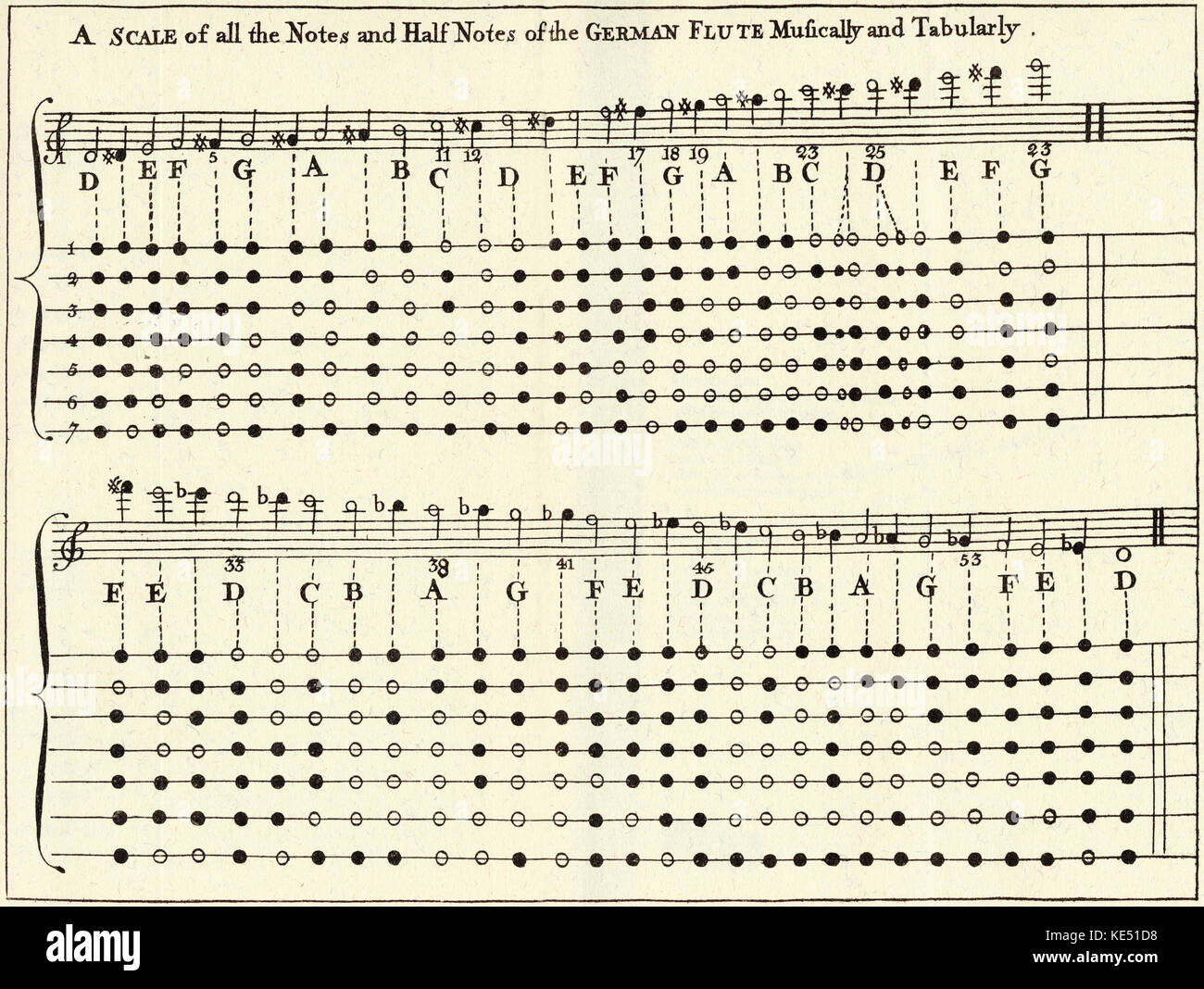 Musical scale for flute, caption reads - A scale of all the notes and half notes of the German flute musically and tabularly. Folding page from the book The Modern Musick-Master or The Universal Musician, published in London, 1731. Stock Photohttps://www.alamy.com/image-license-details/?v=1https://www.alamy.com/stock-image-musical-scale-for-flute-caption-reads-a-scale-of-all-the-notes-and-163609412.html
Musical scale for flute, caption reads - A scale of all the notes and half notes of the German flute musically and tabularly. Folding page from the book The Modern Musick-Master or The Universal Musician, published in London, 1731. Stock Photohttps://www.alamy.com/image-license-details/?v=1https://www.alamy.com/stock-image-musical-scale-for-flute-caption-reads-a-scale-of-all-the-notes-and-163609412.htmlRMKE51D8–Musical scale for flute, caption reads - A scale of all the notes and half notes of the German flute musically and tabularly. Folding page from the book The Modern Musick-Master or The Universal Musician, published in London, 1731.
 Watch Stock Photohttps://www.alamy.com/image-license-details/?v=1https://www.alamy.com/stock-photo-watch-91552075.html
Watch Stock Photohttps://www.alamy.com/image-license-details/?v=1https://www.alamy.com/stock-photo-watch-91552075.htmlRFF8XFGY–Watch
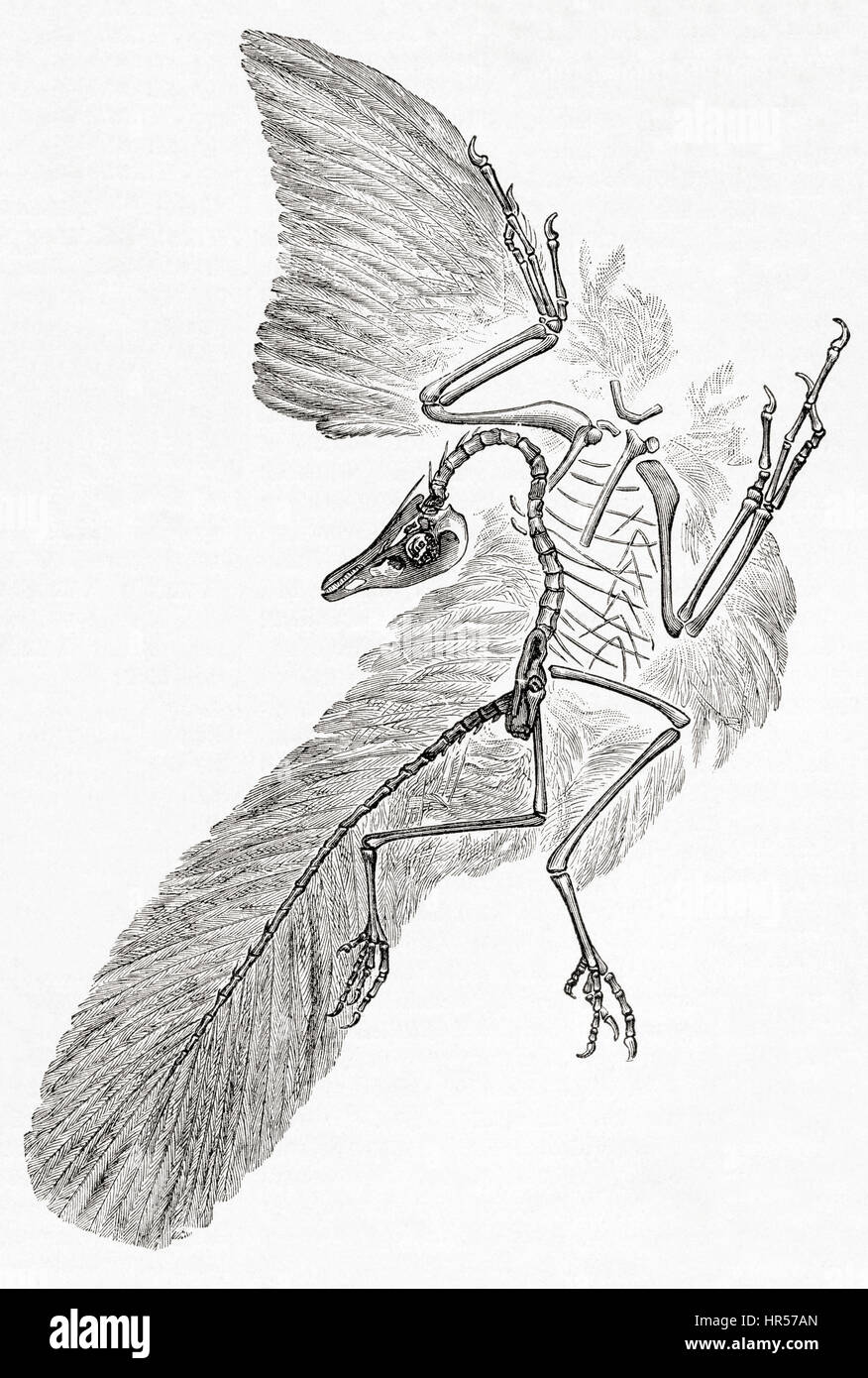 An Archaeopteryx, genus of bird-like dinosaurs that is transitional between non-avian feathered dinosaurs and modern birds. From Meyers Lexicon, published 1927. Stock Photohttps://www.alamy.com/image-license-details/?v=1https://www.alamy.com/stock-photo-an-archaeopteryx-genus-of-bird-like-dinosaurs-that-is-transitional-134725213.html
An Archaeopteryx, genus of bird-like dinosaurs that is transitional between non-avian feathered dinosaurs and modern birds. From Meyers Lexicon, published 1927. Stock Photohttps://www.alamy.com/image-license-details/?v=1https://www.alamy.com/stock-photo-an-archaeopteryx-genus-of-bird-like-dinosaurs-that-is-transitional-134725213.htmlRMHR57AN–An Archaeopteryx, genus of bird-like dinosaurs that is transitional between non-avian feathered dinosaurs and modern birds. From Meyers Lexicon, published 1927.
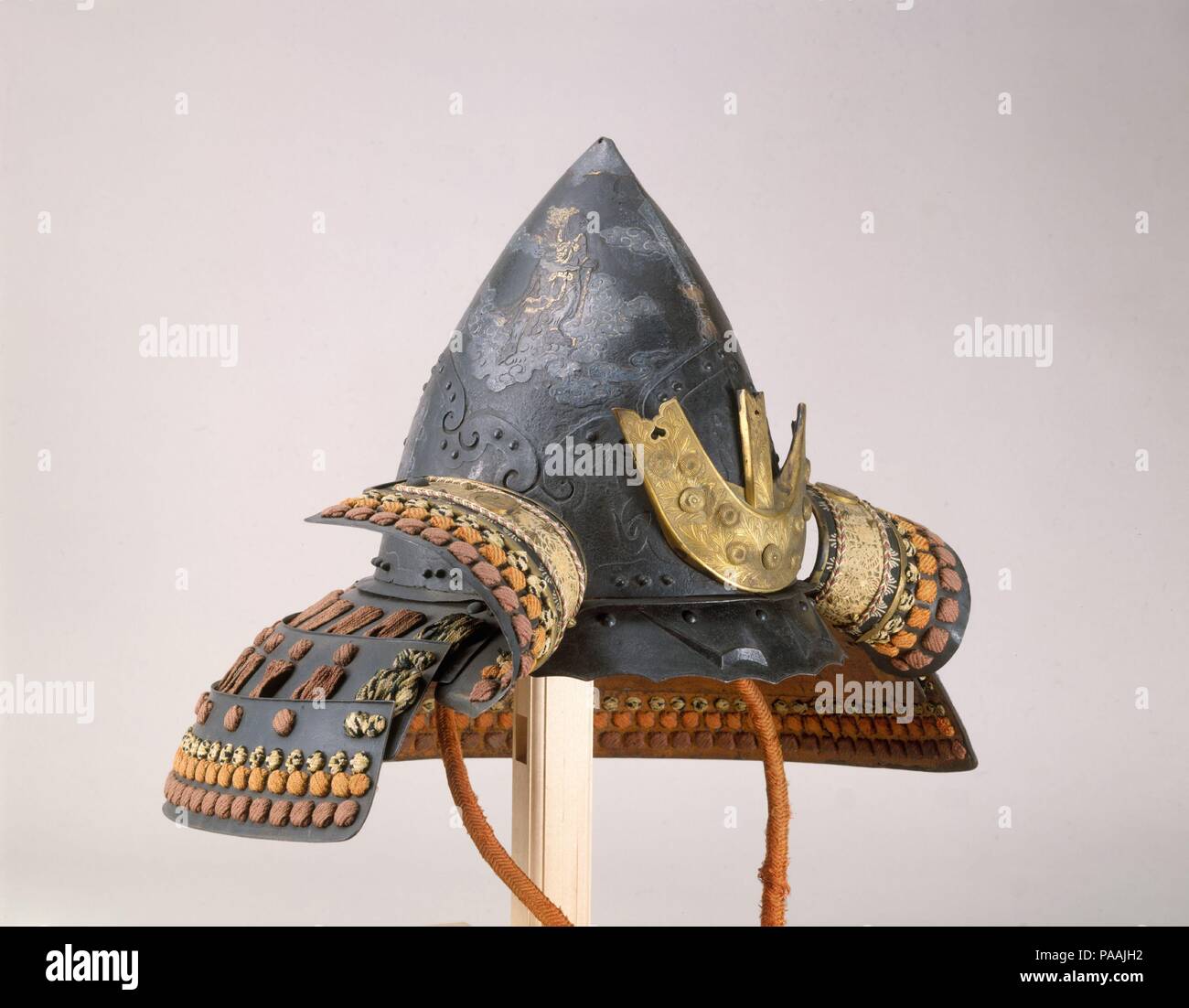 Armor (Gusoku). Armorer: Helmet signed by Saotome Iyetada (Japanese, Edo period, active early-mid-19th century). Culture: Japanese and European. Date: early-mid-19th century. This armor reflects several waves of Western influence in Japan. The helmet, modeled on a late sixteenth-century Dutch cabasset, is by the Japanese armorer Saotome Iyetada, whose signature is found inside the bowl. The cuirass appears to be of early nineteenth-century European manufacture. These older elements, completed by more modern ones, were decorated with Buddhist divinities and literary figures by a Japanese craft Stock Photohttps://www.alamy.com/image-license-details/?v=1https://www.alamy.com/armor-gusoku-armorer-helmet-signed-by-saotome-iyetada-japanese-edo-period-active-early-mid-19th-century-culture-japanese-and-european-date-early-mid-19th-century-this-armor-reflects-several-waves-of-western-influence-in-japan-the-helmet-modeled-on-a-late-sixteenth-century-dutch-cabasset-is-by-the-japanese-armorer-saotome-iyetada-whose-signature-is-found-inside-the-bowl-the-cuirass-appears-to-be-of-early-nineteenth-century-european-manufacture-these-older-elements-completed-by-more-modern-ones-were-decorated-with-buddhist-divinities-and-literary-figures-by-a-japanese-craft-image212905086.html
Armor (Gusoku). Armorer: Helmet signed by Saotome Iyetada (Japanese, Edo period, active early-mid-19th century). Culture: Japanese and European. Date: early-mid-19th century. This armor reflects several waves of Western influence in Japan. The helmet, modeled on a late sixteenth-century Dutch cabasset, is by the Japanese armorer Saotome Iyetada, whose signature is found inside the bowl. The cuirass appears to be of early nineteenth-century European manufacture. These older elements, completed by more modern ones, were decorated with Buddhist divinities and literary figures by a Japanese craft Stock Photohttps://www.alamy.com/image-license-details/?v=1https://www.alamy.com/armor-gusoku-armorer-helmet-signed-by-saotome-iyetada-japanese-edo-period-active-early-mid-19th-century-culture-japanese-and-european-date-early-mid-19th-century-this-armor-reflects-several-waves-of-western-influence-in-japan-the-helmet-modeled-on-a-late-sixteenth-century-dutch-cabasset-is-by-the-japanese-armorer-saotome-iyetada-whose-signature-is-found-inside-the-bowl-the-cuirass-appears-to-be-of-early-nineteenth-century-european-manufacture-these-older-elements-completed-by-more-modern-ones-were-decorated-with-buddhist-divinities-and-literary-figures-by-a-japanese-craft-image212905086.htmlRMPAAJH2–Armor (Gusoku). Armorer: Helmet signed by Saotome Iyetada (Japanese, Edo period, active early-mid-19th century). Culture: Japanese and European. Date: early-mid-19th century. This armor reflects several waves of Western influence in Japan. The helmet, modeled on a late sixteenth-century Dutch cabasset, is by the Japanese armorer Saotome Iyetada, whose signature is found inside the bowl. The cuirass appears to be of early nineteenth-century European manufacture. These older elements, completed by more modern ones, were decorated with Buddhist divinities and literary figures by a Japanese craft
 Lincoln Cathedral or the Cathedral Church of the Blessed Virgin Mary of Lincoln, and sometimes St. Mary's Cathedral in Lincoln, England with the walls of Lincoln Castle in the foreground. Building commenced in 1088 and continued in several phases throughout the medieval period. It was the tallest building in the world for a while. The castle is a major Norman castle constructed during the late 11th century by William the Conqueror on the site of a pre-existing Roman fortress. It is one of two castles in England that remained in use as a prison and law court into modern times. Stock Photohttps://www.alamy.com/image-license-details/?v=1https://www.alamy.com/lincoln-cathedral-or-the-cathedral-church-of-the-blessed-virgin-mary-of-lincoln-and-sometimes-st-marys-cathedral-in-lincoln-england-with-the-walls-of-lincoln-castle-in-the-foreground-building-commenced-in-1088-and-continued-in-several-phases-throughout-the-medieval-period-it-was-the-tallest-building-in-the-world-for-a-while-the-castle-is-a-major-norman-castle-constructed-during-the-late-11th-century-by-william-the-conqueror-on-the-site-of-a-pre-existing-roman-fortress-it-is-one-of-two-castles-in-england-that-remained-in-use-as-a-prison-and-law-court-into-modern-times-image185844589.html
Lincoln Cathedral or the Cathedral Church of the Blessed Virgin Mary of Lincoln, and sometimes St. Mary's Cathedral in Lincoln, England with the walls of Lincoln Castle in the foreground. Building commenced in 1088 and continued in several phases throughout the medieval period. It was the tallest building in the world for a while. The castle is a major Norman castle constructed during the late 11th century by William the Conqueror on the site of a pre-existing Roman fortress. It is one of two castles in England that remained in use as a prison and law court into modern times. Stock Photohttps://www.alamy.com/image-license-details/?v=1https://www.alamy.com/lincoln-cathedral-or-the-cathedral-church-of-the-blessed-virgin-mary-of-lincoln-and-sometimes-st-marys-cathedral-in-lincoln-england-with-the-walls-of-lincoln-castle-in-the-foreground-building-commenced-in-1088-and-continued-in-several-phases-throughout-the-medieval-period-it-was-the-tallest-building-in-the-world-for-a-while-the-castle-is-a-major-norman-castle-constructed-during-the-late-11th-century-by-william-the-conqueror-on-the-site-of-a-pre-existing-roman-fortress-it-is-one-of-two-castles-in-england-that-remained-in-use-as-a-prison-and-law-court-into-modern-times-image185844589.htmlRMMP9XJN–Lincoln Cathedral or the Cathedral Church of the Blessed Virgin Mary of Lincoln, and sometimes St. Mary's Cathedral in Lincoln, England with the walls of Lincoln Castle in the foreground. Building commenced in 1088 and continued in several phases throughout the medieval period. It was the tallest building in the world for a while. The castle is a major Norman castle constructed during the late 11th century by William the Conqueror on the site of a pre-existing Roman fortress. It is one of two castles in England that remained in use as a prison and law court into modern times.
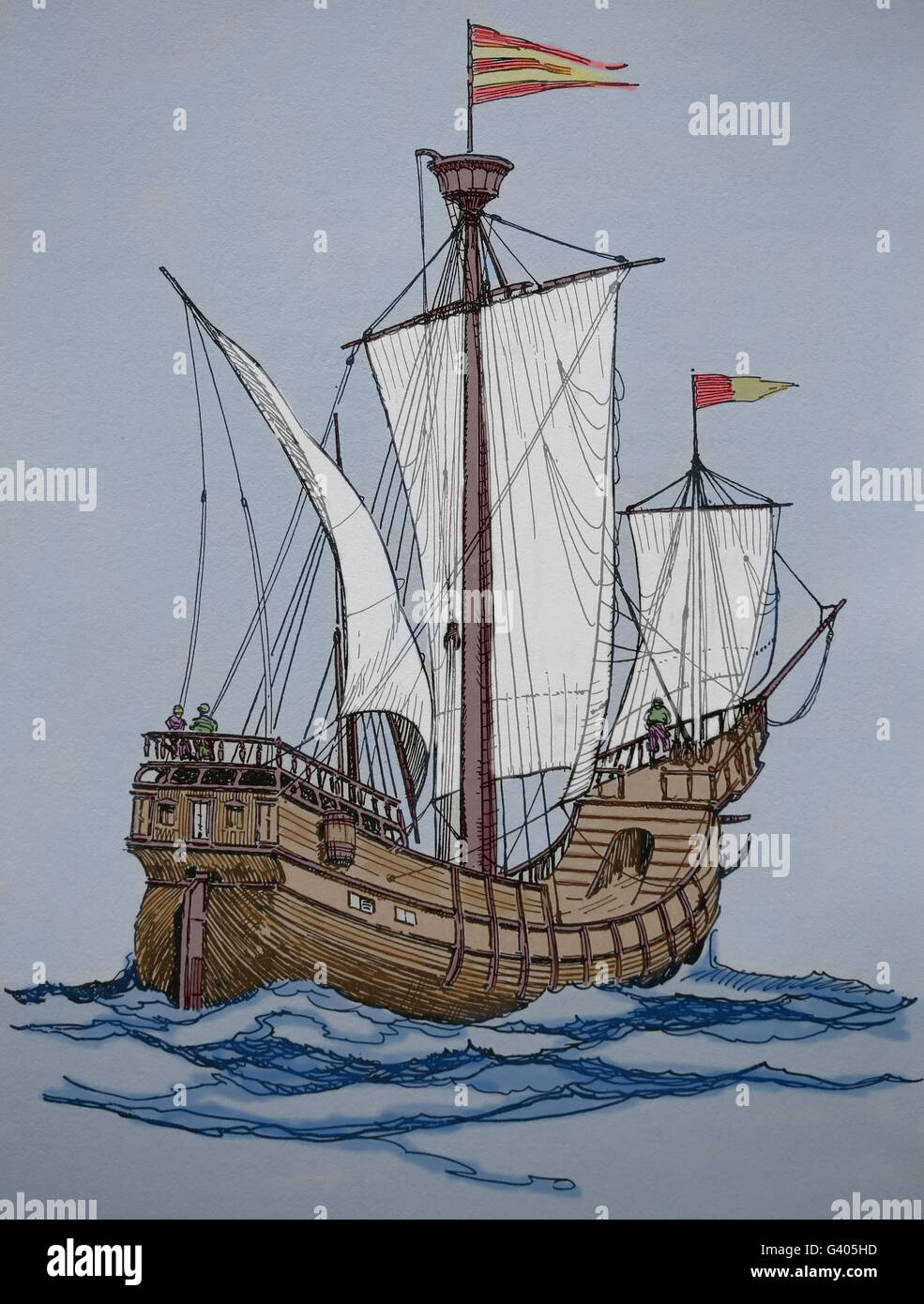 Modern Age. Late 16th century ship. Engraving, 19th century. Color. Stock Photohttps://www.alamy.com/image-license-details/?v=1https://www.alamy.com/stock-photo-modern-age-late-16th-century-ship-engraving-19th-century-color-105725241.html
Modern Age. Late 16th century ship. Engraving, 19th century. Color. Stock Photohttps://www.alamy.com/image-license-details/?v=1https://www.alamy.com/stock-photo-modern-age-late-16th-century-ship-engraving-19th-century-color-105725241.htmlRMG405HD–Modern Age. Late 16th century ship. Engraving, 19th century. Color.
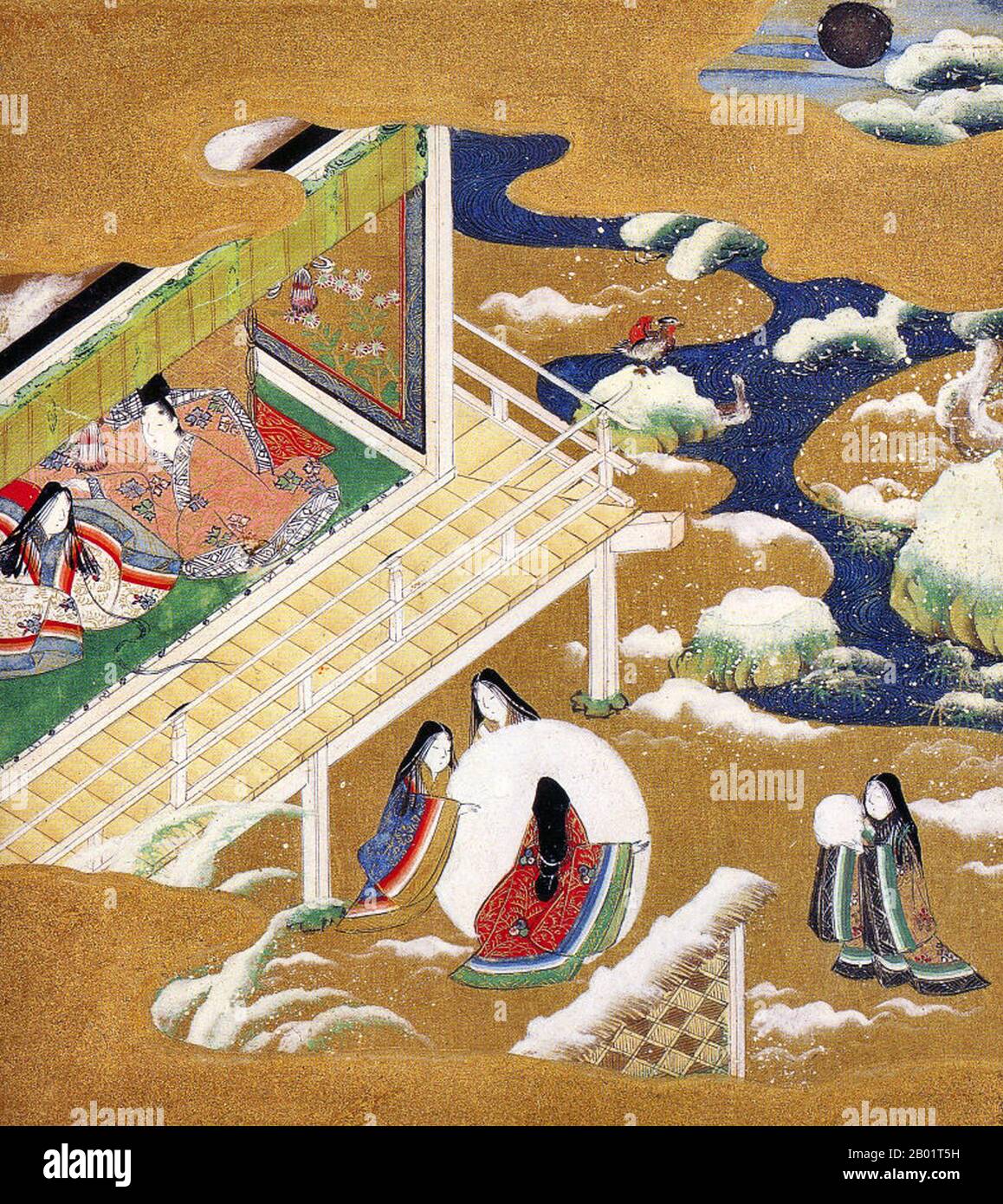 Japan: 'Chapter 20 - Asagao' from the 'Tale of Genji'. Painting by Tosa Mitsuoki (23 October 1617 - 25 September 1691), late 17th century. The Tale of Genji (Genji Monogatari) is a classic work of Japanese literature attributed to the Japanese noblewoman Murasaki Shikibu in the early 11th century, around the peak of the Heian period. It is sometimes called the world's first novel, the first modern novel, the first psychological novel or the first novel still to be considered a classic. Notably, the novel also illustrates a unique depiction of the livelihoods of Heian period high courtiers. Stock Photohttps://www.alamy.com/image-license-details/?v=1https://www.alamy.com/japan-chapter-20-asagao-from-the-tale-of-genji-painting-by-tosa-mitsuoki-23-october-1617-25-september-1691-late-17th-century-the-tale-of-genji-genji-monogatari-is-a-classic-work-of-japanese-literature-attributed-to-the-japanese-noblewoman-murasaki-shikibu-in-the-early-11th-century-around-the-peak-of-the-heian-period-it-is-sometimes-called-the-worlds-first-novel-the-first-modern-novel-the-first-psychological-novel-or-the-first-novel-still-to-be-considered-a-classic-notably-the-novel-also-illustrates-a-unique-depiction-of-the-livelihoods-of-heian-period-high-courtiers-image344248285.html
Japan: 'Chapter 20 - Asagao' from the 'Tale of Genji'. Painting by Tosa Mitsuoki (23 October 1617 - 25 September 1691), late 17th century. The Tale of Genji (Genji Monogatari) is a classic work of Japanese literature attributed to the Japanese noblewoman Murasaki Shikibu in the early 11th century, around the peak of the Heian period. It is sometimes called the world's first novel, the first modern novel, the first psychological novel or the first novel still to be considered a classic. Notably, the novel also illustrates a unique depiction of the livelihoods of Heian period high courtiers. Stock Photohttps://www.alamy.com/image-license-details/?v=1https://www.alamy.com/japan-chapter-20-asagao-from-the-tale-of-genji-painting-by-tosa-mitsuoki-23-october-1617-25-september-1691-late-17th-century-the-tale-of-genji-genji-monogatari-is-a-classic-work-of-japanese-literature-attributed-to-the-japanese-noblewoman-murasaki-shikibu-in-the-early-11th-century-around-the-peak-of-the-heian-period-it-is-sometimes-called-the-worlds-first-novel-the-first-modern-novel-the-first-psychological-novel-or-the-first-novel-still-to-be-considered-a-classic-notably-the-novel-also-illustrates-a-unique-depiction-of-the-livelihoods-of-heian-period-high-courtiers-image344248285.htmlRM2B01T5H–Japan: 'Chapter 20 - Asagao' from the 'Tale of Genji'. Painting by Tosa Mitsuoki (23 October 1617 - 25 September 1691), late 17th century. The Tale of Genji (Genji Monogatari) is a classic work of Japanese literature attributed to the Japanese noblewoman Murasaki Shikibu in the early 11th century, around the peak of the Heian period. It is sometimes called the world's first novel, the first modern novel, the first psychological novel or the first novel still to be considered a classic. Notably, the novel also illustrates a unique depiction of the livelihoods of Heian period high courtiers.
 Archaeopteryx, species that is transitional between non-avian dinosaurs and modern birds from the Late Jurassic period isolated on white background Stock Photohttps://www.alamy.com/image-license-details/?v=1https://www.alamy.com/archaeopteryx-species-that-is-transitional-between-non-avian-dinosaurs-and-modern-birds-from-the-late-jurassic-period-isolated-on-white-background-image354074955.html
Archaeopteryx, species that is transitional between non-avian dinosaurs and modern birds from the Late Jurassic period isolated on white background Stock Photohttps://www.alamy.com/image-license-details/?v=1https://www.alamy.com/archaeopteryx-species-that-is-transitional-between-non-avian-dinosaurs-and-modern-birds-from-the-late-jurassic-period-isolated-on-white-background-image354074955.htmlRF2BG1E63–Archaeopteryx, species that is transitional between non-avian dinosaurs and modern birds from the Late Jurassic period isolated on white background
 modern ships of war steam sail engined sea water port navy royal marine merchant battle ocean harbour gun guns mast old ship boa Stock Photohttps://www.alamy.com/image-license-details/?v=1https://www.alamy.com/stock-photo-modern-ships-of-war-steam-sail-engined-sea-water-port-navy-royal-marine-23002604.html
modern ships of war steam sail engined sea water port navy royal marine merchant battle ocean harbour gun guns mast old ship boa Stock Photohttps://www.alamy.com/image-license-details/?v=1https://www.alamy.com/stock-photo-modern-ships-of-war-steam-sail-engined-sea-water-port-navy-royal-marine-23002604.htmlRFB9BT1G–modern ships of war steam sail engined sea water port navy royal marine merchant battle ocean harbour gun guns mast old ship boa
 Portrait of activist Harriet Tubman late in life, Auburn, New York, 1911. Courtesy Library of Congress. Note: Image has been digitally colorized using a modern process. Colors may not be period-accurate. () Stock Photohttps://www.alamy.com/image-license-details/?v=1https://www.alamy.com/portrait-of-activist-harriet-tubman-late-in-life-auburn-new-york-1911-courtesy-library-of-congress-note-image-has-been-digitally-colorized-using-a-modern-process-colors-may-not-be-period-accurate-image349202261.html
Portrait of activist Harriet Tubman late in life, Auburn, New York, 1911. Courtesy Library of Congress. Note: Image has been digitally colorized using a modern process. Colors may not be period-accurate. () Stock Photohttps://www.alamy.com/image-license-details/?v=1https://www.alamy.com/portrait-of-activist-harriet-tubman-late-in-life-auburn-new-york-1911-courtesy-library-of-congress-note-image-has-been-digitally-colorized-using-a-modern-process-colors-may-not-be-period-accurate-image349202261.htmlRM2B83F19–Portrait of activist Harriet Tubman late in life, Auburn, New York, 1911. Courtesy Library of Congress. Note: Image has been digitally colorized using a modern process. Colors may not be period-accurate. ()
 Tracht, Bekleidung, Leib-Laquaijen am Kaiserlichen Hof, Lakei, bezahlter Diener in Livree, 1703, Kupferstich von Caspar Luyken von 1703, digital restaurierte Reproduktion von einer Vorlage aus dem 18. Jahrhundert / Tracht, clothing, an imperial trotter, especially in the late Middle Ages and early modern period serving companions or bodyguards on foot, 1703, copperplate engraving by Caspar Luyken from 1703, digitally restored reproduction from an 18th century original Stock Photohttps://www.alamy.com/image-license-details/?v=1https://www.alamy.com/tracht-bekleidung-leib-laquaijen-am-kaiserlichen-hof-lakei-bezahlter-diener-in-livree-1703-kupferstich-von-caspar-luyken-von-1703-digital-restaurierte-reproduktion-von-einer-vorlage-aus-dem-18-jahrhundert-tracht-clothing-an-imperial-trotter-especially-in-the-late-middle-ages-and-early-modern-period-serving-companions-or-bodyguards-on-foot-1703-copperplate-engraving-by-caspar-luyken-from-1703-digitally-restored-reproduction-from-an-18th-century-original-image573425889.html
Tracht, Bekleidung, Leib-Laquaijen am Kaiserlichen Hof, Lakei, bezahlter Diener in Livree, 1703, Kupferstich von Caspar Luyken von 1703, digital restaurierte Reproduktion von einer Vorlage aus dem 18. Jahrhundert / Tracht, clothing, an imperial trotter, especially in the late Middle Ages and early modern period serving companions or bodyguards on foot, 1703, copperplate engraving by Caspar Luyken from 1703, digitally restored reproduction from an 18th century original Stock Photohttps://www.alamy.com/image-license-details/?v=1https://www.alamy.com/tracht-bekleidung-leib-laquaijen-am-kaiserlichen-hof-lakei-bezahlter-diener-in-livree-1703-kupferstich-von-caspar-luyken-von-1703-digital-restaurierte-reproduktion-von-einer-vorlage-aus-dem-18-jahrhundert-tracht-clothing-an-imperial-trotter-especially-in-the-late-middle-ages-and-early-modern-period-serving-companions-or-bodyguards-on-foot-1703-copperplate-engraving-by-caspar-luyken-from-1703-digitally-restored-reproduction-from-an-18th-century-original-image573425889.htmlRF2T8WPG1–Tracht, Bekleidung, Leib-Laquaijen am Kaiserlichen Hof, Lakei, bezahlter Diener in Livree, 1703, Kupferstich von Caspar Luyken von 1703, digital restaurierte Reproduktion von einer Vorlage aus dem 18. Jahrhundert / Tracht, clothing, an imperial trotter, especially in the late Middle Ages and early modern period serving companions or bodyguards on foot, 1703, copperplate engraving by Caspar Luyken from 1703, digitally restored reproduction from an 18th century original
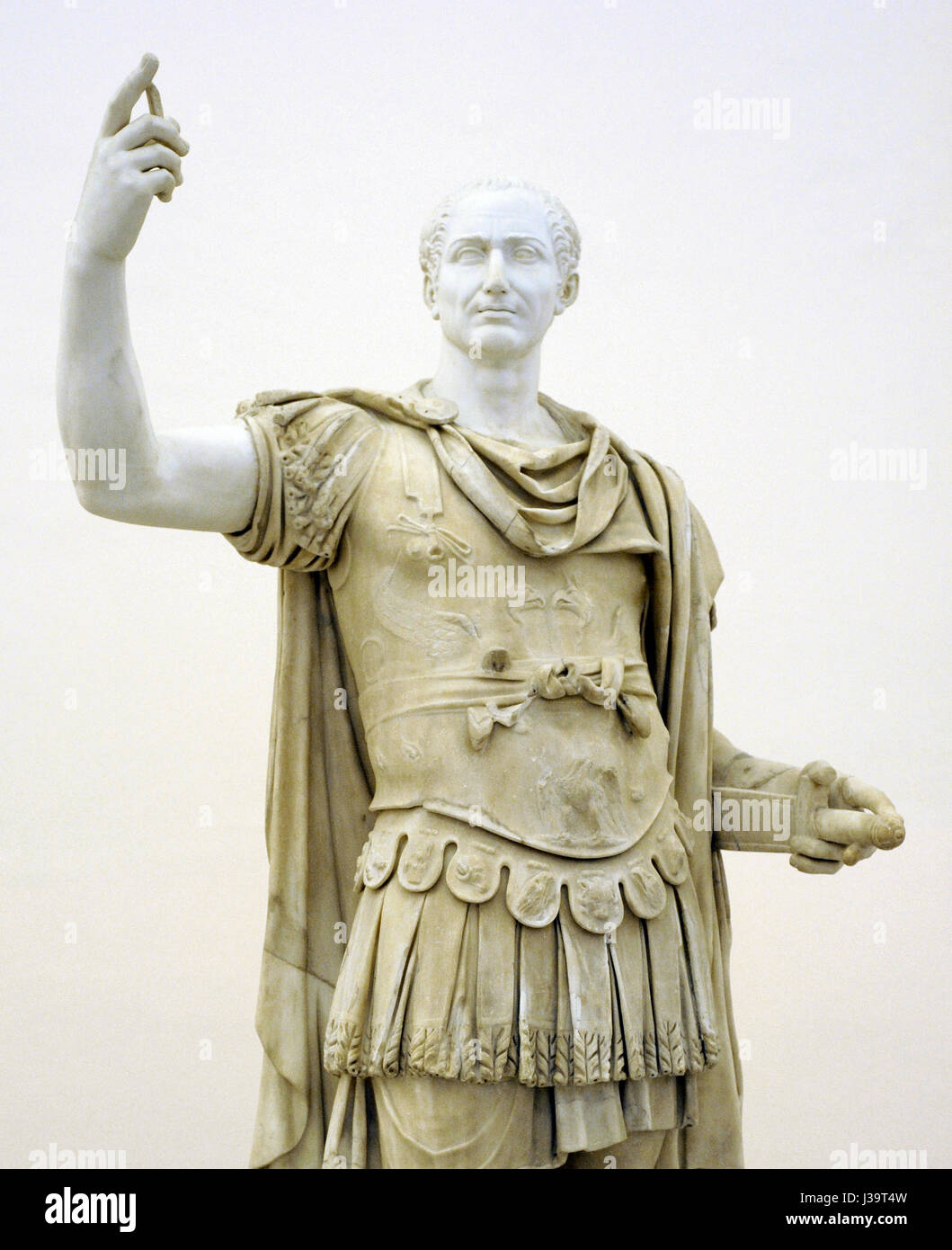 Figure in miliary uniform, with a modern head of Julius Caesar. Antonine-Severan (late 2nd-early 3rd century AD). National Arhaeological Museum. Naples. Italy. Stock Photohttps://www.alamy.com/image-license-details/?v=1https://www.alamy.com/stock-photo-figure-in-miliary-uniform-with-a-modern-head-of-julius-caesar-antonine-139743433.html
Figure in miliary uniform, with a modern head of Julius Caesar. Antonine-Severan (late 2nd-early 3rd century AD). National Arhaeological Museum. Naples. Italy. Stock Photohttps://www.alamy.com/image-license-details/?v=1https://www.alamy.com/stock-photo-figure-in-miliary-uniform-with-a-modern-head-of-julius-caesar-antonine-139743433.htmlRMJ39T4W–Figure in miliary uniform, with a modern head of Julius Caesar. Antonine-Severan (late 2nd-early 3rd century AD). National Arhaeological Museum. Naples. Italy.
 Romford Essex England. Photographed July 1970 but scans made in 2017 Small market town to the east of London embraces modern architecture from the late 1960's to 1970. Stock Photohttps://www.alamy.com/image-license-details/?v=1https://www.alamy.com/stock-image-romford-essex-england-photographed-july-1970-but-scans-made-in-2017-168547259.html
Romford Essex England. Photographed July 1970 but scans made in 2017 Small market town to the east of London embraces modern architecture from the late 1960's to 1970. Stock Photohttps://www.alamy.com/image-license-details/?v=1https://www.alamy.com/stock-image-romford-essex-england-photographed-july-1970-but-scans-made-in-2017-168547259.htmlRMKP5YMY–Romford Essex England. Photographed July 1970 but scans made in 2017 Small market town to the east of London embraces modern architecture from the late 1960's to 1970.
 Stone work in structure 313 with original stucco covering dated from the Late Pre Classic Period of the central acropolis at El Mirador a large pre-Columbian Maya settlement, located in a remote site deep in the jungle in the north of the modern department of El Peten, Guatemala Stock Photohttps://www.alamy.com/image-license-details/?v=1https://www.alamy.com/stock-photo-stone-work-in-structure-313-with-original-stucco-covering-dated-from-140318964.html
Stone work in structure 313 with original stucco covering dated from the Late Pre Classic Period of the central acropolis at El Mirador a large pre-Columbian Maya settlement, located in a remote site deep in the jungle in the north of the modern department of El Peten, Guatemala Stock Photohttps://www.alamy.com/image-license-details/?v=1https://www.alamy.com/stock-photo-stone-work-in-structure-313-with-original-stucco-covering-dated-from-140318964.htmlRMJ4827G–Stone work in structure 313 with original stucco covering dated from the Late Pre Classic Period of the central acropolis at El Mirador a large pre-Columbian Maya settlement, located in a remote site deep in the jungle in the north of the modern department of El Peten, Guatemala
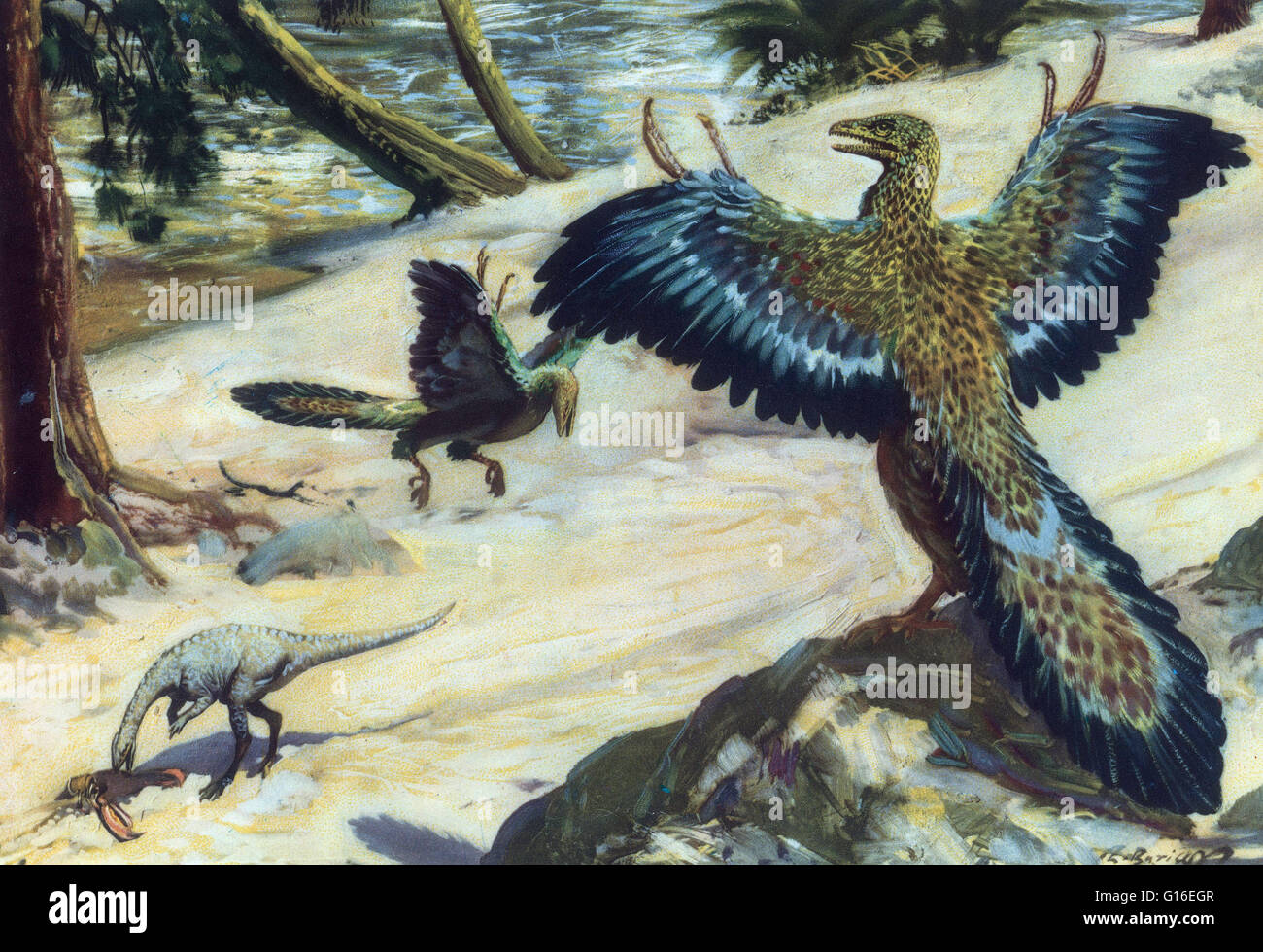 Archaeopteryx, sometimes referred to by its German name Urvogel (original bird or first bird), is a genus of early bird that is transitional between feathered dinosaurs and modern birds. It lived in the Late Jurassic period around 150 million years ago ha Stock Photohttps://www.alamy.com/image-license-details/?v=1https://www.alamy.com/stock-photo-archaeopteryx-sometimes-referred-to-by-its-german-name-urvogel-original-104020023.html
Archaeopteryx, sometimes referred to by its German name Urvogel (original bird or first bird), is a genus of early bird that is transitional between feathered dinosaurs and modern birds. It lived in the Late Jurassic period around 150 million years ago ha Stock Photohttps://www.alamy.com/image-license-details/?v=1https://www.alamy.com/stock-photo-archaeopteryx-sometimes-referred-to-by-its-german-name-urvogel-original-104020023.htmlRMG16EGR–Archaeopteryx, sometimes referred to by its German name Urvogel (original bird or first bird), is a genus of early bird that is transitional between feathered dinosaurs and modern birds. It lived in the Late Jurassic period around 150 million years ago ha
 Table Cover, late Edo period (1789–1868)/ Meiji period (1868–1912), 19th century, Japan, Uncut length of brocaded fabric, modern, deep blue, gold and green, design of dragons, flaming jewels and chrysanthemums, 138.2 x 69.2 cm (54 3/8 x 27 1/4 in Stock Photohttps://www.alamy.com/image-license-details/?v=1https://www.alamy.com/table-cover-late-edo-period-17891868-meiji-period-18681912-19th-century-japan-uncut-length-of-brocaded-fabric-modern-deep-blue-gold-and-green-design-of-dragons-flaming-jewels-and-chrysanthemums-1382-x-692-cm-54-38-x-27-14-in-image328644836.html
Table Cover, late Edo period (1789–1868)/ Meiji period (1868–1912), 19th century, Japan, Uncut length of brocaded fabric, modern, deep blue, gold and green, design of dragons, flaming jewels and chrysanthemums, 138.2 x 69.2 cm (54 3/8 x 27 1/4 in Stock Photohttps://www.alamy.com/image-license-details/?v=1https://www.alamy.com/table-cover-late-edo-period-17891868-meiji-period-18681912-19th-century-japan-uncut-length-of-brocaded-fabric-modern-deep-blue-gold-and-green-design-of-dragons-flaming-jewels-and-chrysanthemums-1382-x-692-cm-54-38-x-27-14-in-image328644836.htmlRM2A2K1RG–Table Cover, late Edo period (1789–1868)/ Meiji period (1868–1912), 19th century, Japan, Uncut length of brocaded fabric, modern, deep blue, gold and green, design of dragons, flaming jewels and chrysanthemums, 138.2 x 69.2 cm (54 3/8 x 27 1/4 in
 An ancient Egyptian bronze statuette of Ptah, Late Period, mid to end of the 1st millennium BC Upright standing depiction of the god as mummy with beard and cap, holding the Ankh-Djed-Was-sceptre in his hands. On a modern wooden base. Length without base 9.7 cm. Provenance: 1970s private collection from the Munich area. historic, historical, ancient world, Additional-Rights-Clearance-Info-Not-Available Stock Photohttps://www.alamy.com/image-license-details/?v=1https://www.alamy.com/an-ancient-egyptian-bronze-statuette-of-ptah-late-period-mid-to-end-of-the-1st-millennium-bc-upright-standing-depiction-of-the-god-as-mummy-with-beard-and-cap-holding-the-ankh-djed-was-sceptre-in-his-hands-on-a-modern-wooden-base-length-without-base-97-cm-provenance-1970s-private-collection-from-the-munich-area-historic-historical-ancient-world-additional-rights-clearance-info-not-available-image246352987.html
An ancient Egyptian bronze statuette of Ptah, Late Period, mid to end of the 1st millennium BC Upright standing depiction of the god as mummy with beard and cap, holding the Ankh-Djed-Was-sceptre in his hands. On a modern wooden base. Length without base 9.7 cm. Provenance: 1970s private collection from the Munich area. historic, historical, ancient world, Additional-Rights-Clearance-Info-Not-Available Stock Photohttps://www.alamy.com/image-license-details/?v=1https://www.alamy.com/an-ancient-egyptian-bronze-statuette-of-ptah-late-period-mid-to-end-of-the-1st-millennium-bc-upright-standing-depiction-of-the-god-as-mummy-with-beard-and-cap-holding-the-ankh-djed-was-sceptre-in-his-hands-on-a-modern-wooden-base-length-without-base-97-cm-provenance-1970s-private-collection-from-the-munich-area-historic-historical-ancient-world-additional-rights-clearance-info-not-available-image246352987.htmlRMT8P9MY–An ancient Egyptian bronze statuette of Ptah, Late Period, mid to end of the 1st millennium BC Upright standing depiction of the god as mummy with beard and cap, holding the Ankh-Djed-Was-sceptre in his hands. On a modern wooden base. Length without base 9.7 cm. Provenance: 1970s private collection from the Munich area. historic, historical, ancient world, Additional-Rights-Clearance-Info-Not-Available
 Art inspired by Three poems from the “Collection of Poems Ancient and Modern” (Kokin wakashū), known as the “Imaki Fragment” (Imaki-gire), late Heian period (794–1185), mid-to late 12th century, Japan, Page from book, mounted as hanging scroll; ink on paper, Image: 9 15/16 × 6 1/4 in, Classic works modernized by Artotop with a splash of modernity. Shapes, color and value, eye-catching visual impact on art. Emotions through freedom of artworks in a contemporary way. A timeless message pursuing a wildly creative new direction. Artists turning to the digital medium and creating the Artotop NFT Stock Photohttps://www.alamy.com/image-license-details/?v=1https://www.alamy.com/art-inspired-by-three-poems-from-the-collection-of-poems-ancient-and-modern-kokin-wakash-known-as-the-imaki-fragment-imaki-gire-late-heian-period-7941185-mid-to-late-12th-century-japan-page-from-book-mounted-as-hanging-scroll-ink-on-paper-image-9-1516-6-14-in-classic-works-modernized-by-artotop-with-a-splash-of-modernity-shapes-color-and-value-eye-catching-visual-impact-on-art-emotions-through-freedom-of-artworks-in-a-contemporary-way-a-timeless-message-pursuing-a-wildly-creative-new-direction-artists-turning-to-the-digital-medium-and-creating-the-artotop-nft-image463043790.html
Art inspired by Three poems from the “Collection of Poems Ancient and Modern” (Kokin wakashū), known as the “Imaki Fragment” (Imaki-gire), late Heian period (794–1185), mid-to late 12th century, Japan, Page from book, mounted as hanging scroll; ink on paper, Image: 9 15/16 × 6 1/4 in, Classic works modernized by Artotop with a splash of modernity. Shapes, color and value, eye-catching visual impact on art. Emotions through freedom of artworks in a contemporary way. A timeless message pursuing a wildly creative new direction. Artists turning to the digital medium and creating the Artotop NFT Stock Photohttps://www.alamy.com/image-license-details/?v=1https://www.alamy.com/art-inspired-by-three-poems-from-the-collection-of-poems-ancient-and-modern-kokin-wakash-known-as-the-imaki-fragment-imaki-gire-late-heian-period-7941185-mid-to-late-12th-century-japan-page-from-book-mounted-as-hanging-scroll-ink-on-paper-image-9-1516-6-14-in-classic-works-modernized-by-artotop-with-a-splash-of-modernity-shapes-color-and-value-eye-catching-visual-impact-on-art-emotions-through-freedom-of-artworks-in-a-contemporary-way-a-timeless-message-pursuing-a-wildly-creative-new-direction-artists-turning-to-the-digital-medium-and-creating-the-artotop-nft-image463043790.htmlRF2HW9D26–Art inspired by Three poems from the “Collection of Poems Ancient and Modern” (Kokin wakashū), known as the “Imaki Fragment” (Imaki-gire), late Heian period (794–1185), mid-to late 12th century, Japan, Page from book, mounted as hanging scroll; ink on paper, Image: 9 15/16 × 6 1/4 in, Classic works modernized by Artotop with a splash of modernity. Shapes, color and value, eye-catching visual impact on art. Emotions through freedom of artworks in a contemporary way. A timeless message pursuing a wildly creative new direction. Artists turning to the digital medium and creating the Artotop NFT
 Photograph of Jean Sibelius (1865-1957) a Finnish composer and violinist of the late-Romantic and early-modern period. Dated 20th Century Stock Photohttps://www.alamy.com/image-license-details/?v=1https://www.alamy.com/stock-image-photograph-of-jean-sibelius-1865-1957-a-finnish-composer-and-violinist-162593304.html
Photograph of Jean Sibelius (1865-1957) a Finnish composer and violinist of the late-Romantic and early-modern period. Dated 20th Century Stock Photohttps://www.alamy.com/image-license-details/?v=1https://www.alamy.com/stock-image-photograph-of-jean-sibelius-1865-1957-a-finnish-composer-and-violinist-162593304.htmlRMKCENBM–Photograph of Jean Sibelius (1865-1957) a Finnish composer and violinist of the late-Romantic and early-modern period. Dated 20th Century
 Early 18th century harpsichord player, , caption reads - 'The harpsichord illustrated and improved; wherein is shown the Italian manner of fingering. ' From The Modern Musick-Master or The Universal Musician, published in London, 1731. Stock Photohttps://www.alamy.com/image-license-details/?v=1https://www.alamy.com/stock-image-early-18th-century-harpsichord-player-caption-reads-the-harpsichord-163609400.html
Early 18th century harpsichord player, , caption reads - 'The harpsichord illustrated and improved; wherein is shown the Italian manner of fingering. ' From The Modern Musick-Master or The Universal Musician, published in London, 1731. Stock Photohttps://www.alamy.com/image-license-details/?v=1https://www.alamy.com/stock-image-early-18th-century-harpsichord-player-caption-reads-the-harpsichord-163609400.htmlRMKE51CT–Early 18th century harpsichord player, , caption reads - 'The harpsichord illustrated and improved; wherein is shown the Italian manner of fingering. ' From The Modern Musick-Master or The Universal Musician, published in London, 1731.
 The late Dr. Lindley, Professor of Botany, 1865. Engraving from a photograph by Messrs. Maull and Polyblank of Dr. John Lindley, '...one of the most eminent of modern English botanists and the author of the best books we have upon various departments of that science...in 1829...he was appointed Professor of Botany at University College, London. At this period the Linnean system was almost universally followed by English botanists. It is one of the chief merits of Dr. Lindley that he early saw the necessity of superseding the artificial by the natural classification of plants. In an essay on th Stock Photohttps://www.alamy.com/image-license-details/?v=1https://www.alamy.com/the-late-dr-lindley-professor-of-botany-1865-engraving-from-a-photograph-by-messrs-maull-and-polyblank-of-dr-john-lindley-one-of-the-most-eminent-of-modern-english-botanists-and-the-author-of-the-best-books-we-have-upon-various-departments-of-that-sciencein-1829he-was-appointed-professor-of-botany-at-university-college-london-at-this-period-the-linnean-system-was-almost-universally-followed-by-english-botanists-it-is-one-of-the-chief-merits-of-dr-lindley-that-he-early-saw-the-necessity-of-superseding-the-artificial-by-the-natural-classification-of-plants-in-an-essay-on-th-image608998183.html
The late Dr. Lindley, Professor of Botany, 1865. Engraving from a photograph by Messrs. Maull and Polyblank of Dr. John Lindley, '...one of the most eminent of modern English botanists and the author of the best books we have upon various departments of that science...in 1829...he was appointed Professor of Botany at University College, London. At this period the Linnean system was almost universally followed by English botanists. It is one of the chief merits of Dr. Lindley that he early saw the necessity of superseding the artificial by the natural classification of plants. In an essay on th Stock Photohttps://www.alamy.com/image-license-details/?v=1https://www.alamy.com/the-late-dr-lindley-professor-of-botany-1865-engraving-from-a-photograph-by-messrs-maull-and-polyblank-of-dr-john-lindley-one-of-the-most-eminent-of-modern-english-botanists-and-the-author-of-the-best-books-we-have-upon-various-departments-of-that-sciencein-1829he-was-appointed-professor-of-botany-at-university-college-london-at-this-period-the-linnean-system-was-almost-universally-followed-by-english-botanists-it-is-one-of-the-chief-merits-of-dr-lindley-that-he-early-saw-the-necessity-of-superseding-the-artificial-by-the-natural-classification-of-plants-in-an-essay-on-th-image608998183.htmlRM2XAP7B3–The late Dr. Lindley, Professor of Botany, 1865. Engraving from a photograph by Messrs. Maull and Polyblank of Dr. John Lindley, '...one of the most eminent of modern English botanists and the author of the best books we have upon various departments of that science...in 1829...he was appointed Professor of Botany at University College, London. At this period the Linnean system was almost universally followed by English botanists. It is one of the chief merits of Dr. Lindley that he early saw the necessity of superseding the artificial by the natural classification of plants. In an essay on th
 Heart Scarab (image 1 of 2), New Kingdom-Late Period (1569-525 BCE) or modern. Stock Photohttps://www.alamy.com/image-license-details/?v=1https://www.alamy.com/heart-scarab-image-1-of-2-new-kingdom-late-period-1569-525-bce-or-modern-image568865417.html
Heart Scarab (image 1 of 2), New Kingdom-Late Period (1569-525 BCE) or modern. Stock Photohttps://www.alamy.com/image-license-details/?v=1https://www.alamy.com/heart-scarab-image-1-of-2-new-kingdom-late-period-1569-525-bce-or-modern-image568865417.htmlRM2T1E1J1–Heart Scarab (image 1 of 2), New Kingdom-Late Period (1569-525 BCE) or modern.
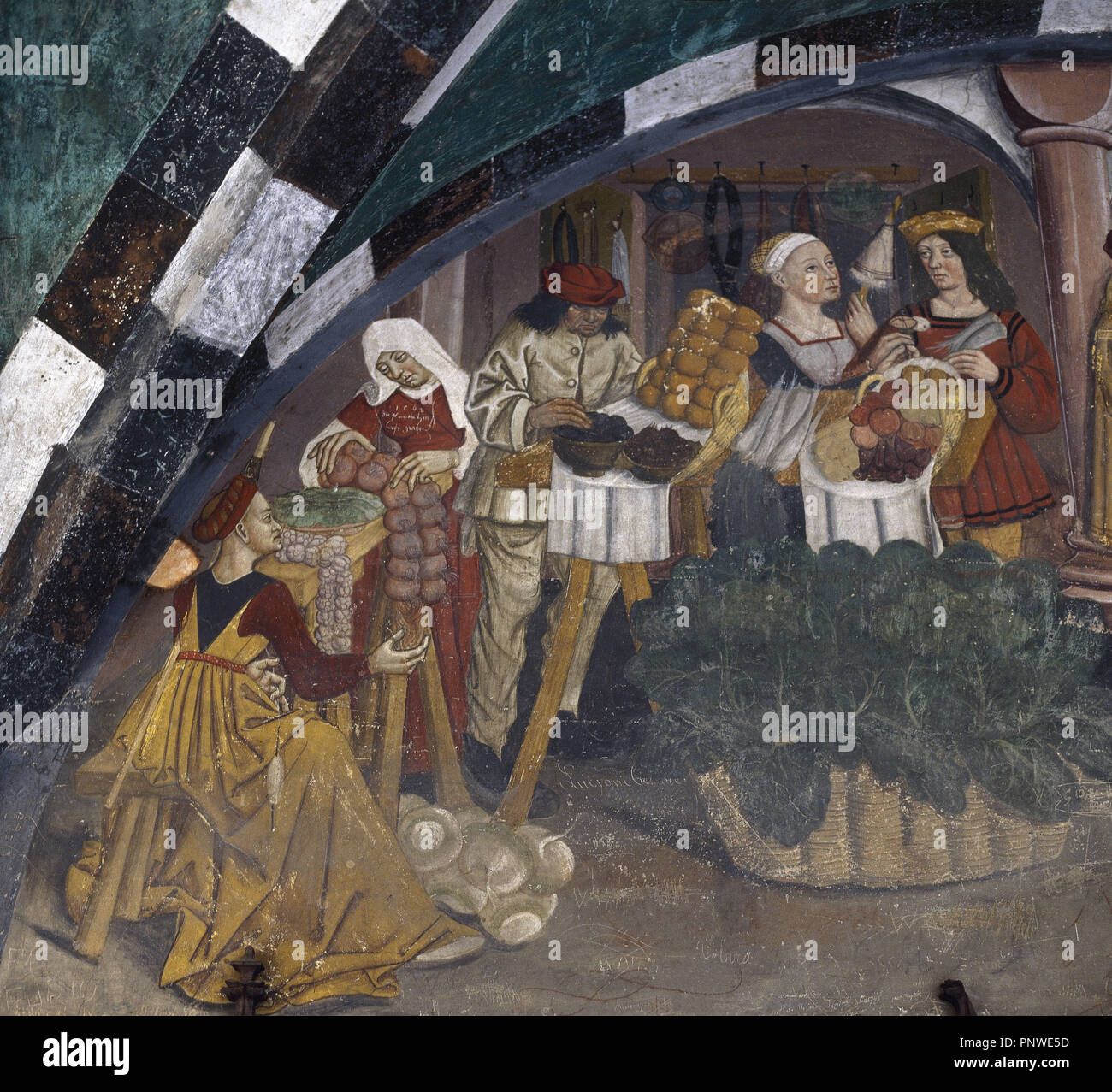 Lunette of the market. It depicts fruits and vegetable market with customers and vendors in costumes of the period. Attributed to Magister Collinus, ca. 1500. Portico. Late 15th -16th century. Issogne Castle. Aosta Valley, Italy. Stock Photohttps://www.alamy.com/image-license-details/?v=1https://www.alamy.com/lunette-of-the-market-it-depicts-fruits-and-vegetable-market-with-customers-and-vendors-in-costumes-of-the-period-attributed-to-magister-collinus-ca-1500-portico-late-15th-16th-century-issogne-castle-aosta-valley-italy-image219992121.html
Lunette of the market. It depicts fruits and vegetable market with customers and vendors in costumes of the period. Attributed to Magister Collinus, ca. 1500. Portico. Late 15th -16th century. Issogne Castle. Aosta Valley, Italy. Stock Photohttps://www.alamy.com/image-license-details/?v=1https://www.alamy.com/lunette-of-the-market-it-depicts-fruits-and-vegetable-market-with-customers-and-vendors-in-costumes-of-the-period-attributed-to-magister-collinus-ca-1500-portico-late-15th-16th-century-issogne-castle-aosta-valley-italy-image219992121.htmlRMPNWE5D–Lunette of the market. It depicts fruits and vegetable market with customers and vendors in costumes of the period. Attributed to Magister Collinus, ca. 1500. Portico. Late 15th -16th century. Issogne Castle. Aosta Valley, Italy.
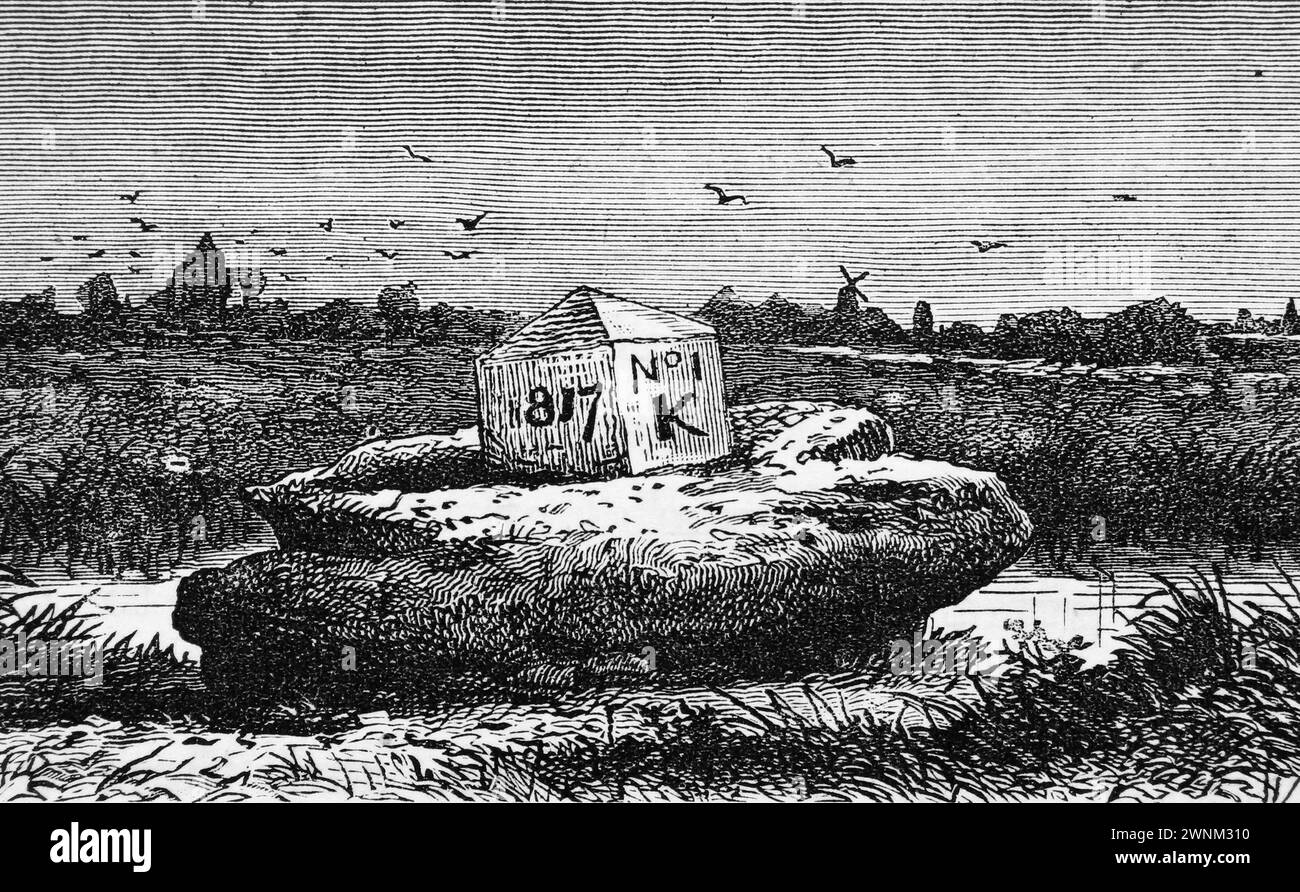 Kenulph's Stone, one of six crosses erected to mark the boundary of Crowland in the 14th century; This was a modern replacement with the date 1817. Black and white illustration from 'Our Own Country' a Descriptive, Historical and Pictorial guide to the UK published in late 1880s by Cassell, Petter, Galpin & Co. Historic pictures of Briatin. Stock Photohttps://www.alamy.com/image-license-details/?v=1https://www.alamy.com/kenulphs-stone-one-of-six-crosses-erected-to-mark-the-boundary-of-crowland-in-the-14th-century-this-was-a-modern-replacement-with-the-date-1817-black-and-white-illustration-from-our-own-country-a-descriptive-historical-and-pictorial-guide-to-the-uk-published-in-late-1880s-by-cassell-petter-galpin-co-historic-pictures-of-briatin-image598501708.html
Kenulph's Stone, one of six crosses erected to mark the boundary of Crowland in the 14th century; This was a modern replacement with the date 1817. Black and white illustration from 'Our Own Country' a Descriptive, Historical and Pictorial guide to the UK published in late 1880s by Cassell, Petter, Galpin & Co. Historic pictures of Briatin. Stock Photohttps://www.alamy.com/image-license-details/?v=1https://www.alamy.com/kenulphs-stone-one-of-six-crosses-erected-to-mark-the-boundary-of-crowland-in-the-14th-century-this-was-a-modern-replacement-with-the-date-1817-black-and-white-illustration-from-our-own-country-a-descriptive-historical-and-pictorial-guide-to-the-uk-published-in-late-1880s-by-cassell-petter-galpin-co-historic-pictures-of-briatin-image598501708.htmlRM2WNM310–Kenulph's Stone, one of six crosses erected to mark the boundary of Crowland in the 14th century; This was a modern replacement with the date 1817. Black and white illustration from 'Our Own Country' a Descriptive, Historical and Pictorial guide to the UK published in late 1880s by Cassell, Petter, Galpin & Co. Historic pictures of Briatin.
 Ocean vessel hull, c. 1500. Engraving, 19th century. Stock Photohttps://www.alamy.com/image-license-details/?v=1https://www.alamy.com/ocean-vessel-hull-c-1500-engraving-19th-century-image614433908.html
Ocean vessel hull, c. 1500. Engraving, 19th century. Stock Photohttps://www.alamy.com/image-license-details/?v=1https://www.alamy.com/ocean-vessel-hull-c-1500-engraving-19th-century-image614433908.htmlRM2XKHTM4–Ocean vessel hull, c. 1500. Engraving, 19th century.
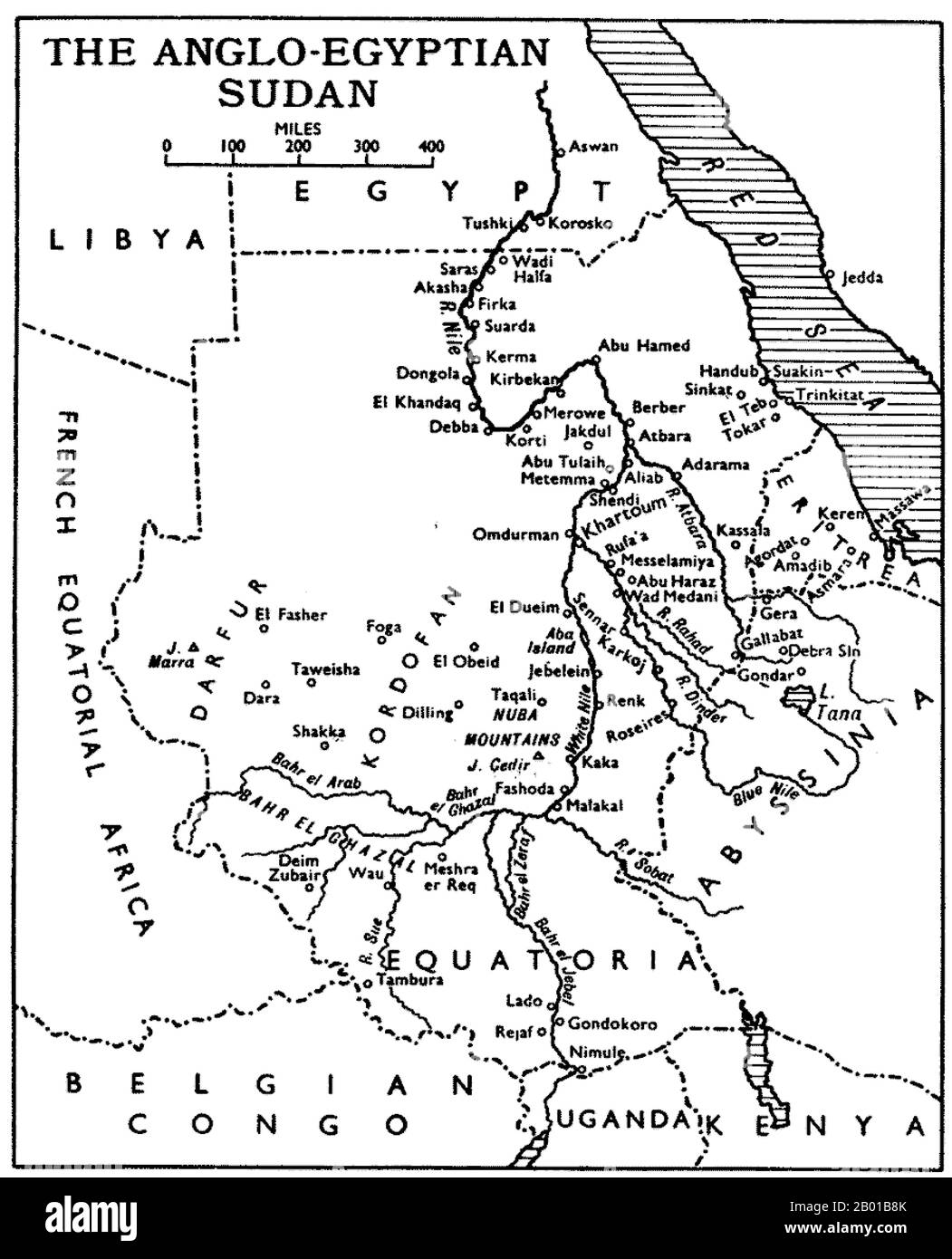 Sudan: Map of the Anglo-Egyptian Sudan showing Equatoria Province - now roughly coterminous with South Sudan, late 19th century. The term Anglo-Egyptian Sudan refers to the period between 1891 and 1956 when Sudan was administered as a condominium of Egypt and the United Kingdom. Sudan (comprising modern-day Sudan and South Sudan) was de jure shared legally between Egypt and the British Empire, but was de facto controlled by the latter, with Egypt only enjoying limited local power in reality as Egypt itself fell under increasing British influence. Stock Photohttps://www.alamy.com/image-license-details/?v=1https://www.alamy.com/sudan-map-of-the-anglo-egyptian-sudan-showing-equatoria-province-now-roughly-coterminous-with-south-sudan-late-19th-century-the-term-anglo-egyptian-sudan-refers-to-the-period-between-1891-and-1956-when-sudan-was-administered-as-a-condominium-of-egypt-and-the-united-kingdom-sudan-comprising-modern-day-sudan-and-south-sudan-was-de-jure-shared-legally-between-egypt-and-the-british-empire-but-was-de-facto-controlled-by-the-latter-with-egypt-only-enjoying-limited-local-power-in-reality-as-egypt-itself-fell-under-increasing-british-influence-image344238179.html
Sudan: Map of the Anglo-Egyptian Sudan showing Equatoria Province - now roughly coterminous with South Sudan, late 19th century. The term Anglo-Egyptian Sudan refers to the period between 1891 and 1956 when Sudan was administered as a condominium of Egypt and the United Kingdom. Sudan (comprising modern-day Sudan and South Sudan) was de jure shared legally between Egypt and the British Empire, but was de facto controlled by the latter, with Egypt only enjoying limited local power in reality as Egypt itself fell under increasing British influence. Stock Photohttps://www.alamy.com/image-license-details/?v=1https://www.alamy.com/sudan-map-of-the-anglo-egyptian-sudan-showing-equatoria-province-now-roughly-coterminous-with-south-sudan-late-19th-century-the-term-anglo-egyptian-sudan-refers-to-the-period-between-1891-and-1956-when-sudan-was-administered-as-a-condominium-of-egypt-and-the-united-kingdom-sudan-comprising-modern-day-sudan-and-south-sudan-was-de-jure-shared-legally-between-egypt-and-the-british-empire-but-was-de-facto-controlled-by-the-latter-with-egypt-only-enjoying-limited-local-power-in-reality-as-egypt-itself-fell-under-increasing-british-influence-image344238179.htmlRM2B01B8K–Sudan: Map of the Anglo-Egyptian Sudan showing Equatoria Province - now roughly coterminous with South Sudan, late 19th century. The term Anglo-Egyptian Sudan refers to the period between 1891 and 1956 when Sudan was administered as a condominium of Egypt and the United Kingdom. Sudan (comprising modern-day Sudan and South Sudan) was de jure shared legally between Egypt and the British Empire, but was de facto controlled by the latter, with Egypt only enjoying limited local power in reality as Egypt itself fell under increasing British influence.
 Archaeopteryx, species that is transitional between non-avian dinosaurs and modern birds from the Late Jurassic period isolated on white background Stock Photohttps://www.alamy.com/image-license-details/?v=1https://www.alamy.com/archaeopteryx-species-that-is-transitional-between-non-avian-dinosaurs-and-modern-birds-from-the-late-jurassic-period-isolated-on-white-background-image354074922.html
Archaeopteryx, species that is transitional between non-avian dinosaurs and modern birds from the Late Jurassic period isolated on white background Stock Photohttps://www.alamy.com/image-license-details/?v=1https://www.alamy.com/archaeopteryx-species-that-is-transitional-between-non-avian-dinosaurs-and-modern-birds-from-the-late-jurassic-period-isolated-on-white-background-image354074922.htmlRF2BG1E4X–Archaeopteryx, species that is transitional between non-avian dinosaurs and modern birds from the Late Jurassic period isolated on white background
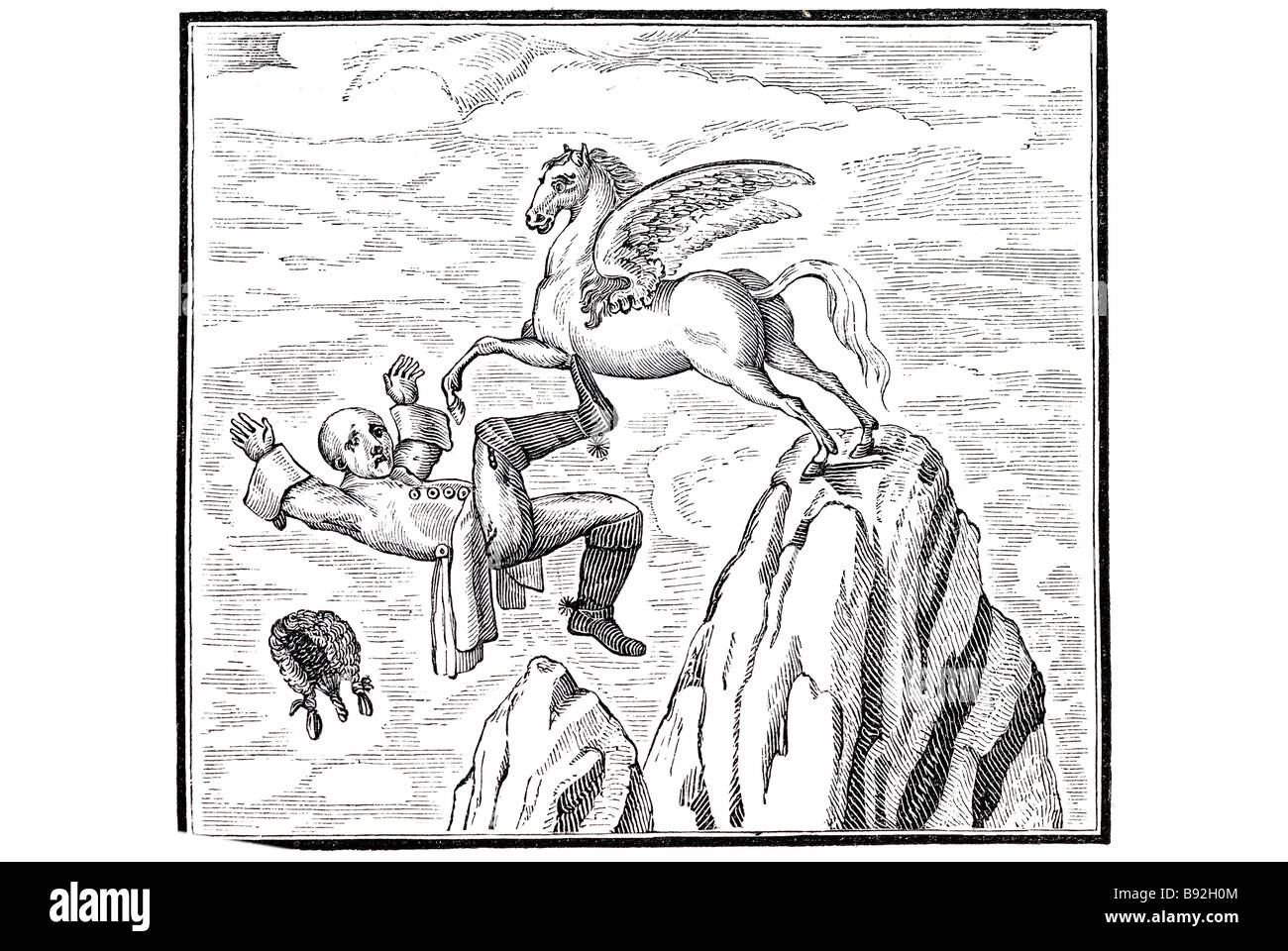 modern poet huge boots flung mountain top pegasus horse winged sea losing tie-wig fall poets fall winged steed equine Robert Llo Stock Photohttps://www.alamy.com/image-license-details/?v=1https://www.alamy.com/stock-photo-modern-poet-huge-boots-flung-mountain-top-pegasus-horse-winged-sea-22799524.html
modern poet huge boots flung mountain top pegasus horse winged sea losing tie-wig fall poets fall winged steed equine Robert Llo Stock Photohttps://www.alamy.com/image-license-details/?v=1https://www.alamy.com/stock-photo-modern-poet-huge-boots-flung-mountain-top-pegasus-horse-winged-sea-22799524.htmlRFB92H0M–modern poet huge boots flung mountain top pegasus horse winged sea losing tie-wig fall poets fall winged steed equine Robert Llo
 Picturesque and historic buildings including some of the colleges, line the streets of Oxford, England. Oxford has a compact city centre with an outstanding collection of world famous buildings. Its origins lie in the late Saxon period and its original street pattern still survives along with some of its earliest monuments. It contains one of the best preserved groups of medieval and later university buildings in the world and a wealth of architectural gems from the classical to the modern and many of them owe their existence to the growth of the University of Oxford over 800 years. United Kin Stock Photohttps://www.alamy.com/image-license-details/?v=1https://www.alamy.com/picturesque-and-historic-buildings-including-some-of-the-colleges-line-the-streets-of-oxford-england-oxford-has-a-compact-city-centre-with-an-outstanding-collection-of-world-famous-buildings-its-origins-lie-in-the-late-saxon-period-and-its-original-street-pattern-still-survives-along-with-some-of-its-earliest-monuments-it-contains-one-of-the-best-preserved-groups-of-medieval-and-later-university-buildings-in-the-world-and-a-wealth-of-architectural-gems-from-the-classical-to-the-modern-and-many-of-them-owe-their-existence-to-the-growth-of-the-university-of-oxford-over-800-years-united-kin-image435475049.html
Picturesque and historic buildings including some of the colleges, line the streets of Oxford, England. Oxford has a compact city centre with an outstanding collection of world famous buildings. Its origins lie in the late Saxon period and its original street pattern still survives along with some of its earliest monuments. It contains one of the best preserved groups of medieval and later university buildings in the world and a wealth of architectural gems from the classical to the modern and many of them owe their existence to the growth of the University of Oxford over 800 years. United Kin Stock Photohttps://www.alamy.com/image-license-details/?v=1https://www.alamy.com/picturesque-and-historic-buildings-including-some-of-the-colleges-line-the-streets-of-oxford-england-oxford-has-a-compact-city-centre-with-an-outstanding-collection-of-world-famous-buildings-its-origins-lie-in-the-late-saxon-period-and-its-original-street-pattern-still-survives-along-with-some-of-its-earliest-monuments-it-contains-one-of-the-best-preserved-groups-of-medieval-and-later-university-buildings-in-the-world-and-a-wealth-of-architectural-gems-from-the-classical-to-the-modern-and-many-of-them-owe-their-existence-to-the-growth-of-the-university-of-oxford-over-800-years-united-kin-image435475049.htmlRM2G8DGT9–Picturesque and historic buildings including some of the colleges, line the streets of Oxford, England. Oxford has a compact city centre with an outstanding collection of world famous buildings. Its origins lie in the late Saxon period and its original street pattern still survives along with some of its earliest monuments. It contains one of the best preserved groups of medieval and later university buildings in the world and a wealth of architectural gems from the classical to the modern and many of them owe their existence to the growth of the University of Oxford over 800 years. United Kin
 Tracht, Bekleidung, ein kaiserlicher Trabant, besonders im Spätmittelalter und der Frühen Neuzeit dienende Begleiter oder Leibwächter zu Fuß, 1703, Kupferstich von Caspar Luyken von 1703, digital restaurierte Reproduktion von einer Vorlage aus dem 18. Jahrhundert / Tracht, clothing, an imperial trotter, especially in the late Middle Ages and early modern period serving companions or bodyguards on foot, 1703, copperplate engraving by Caspar Luyken from 1703, digitally restored reproduction from an 18th century original Stock Photohttps://www.alamy.com/image-license-details/?v=1https://www.alamy.com/tracht-bekleidung-ein-kaiserlicher-trabant-besonders-im-sptmittelalter-und-der-frhen-neuzeit-dienende-begleiter-oder-leibwchter-zu-fu-1703-kupferstich-von-caspar-luyken-von-1703-digital-restaurierte-reproduktion-von-einer-vorlage-aus-dem-18-jahrhundert-tracht-clothing-an-imperial-trotter-especially-in-the-late-middle-ages-and-early-modern-period-serving-companions-or-bodyguards-on-foot-1703-copperplate-engraving-by-caspar-luyken-from-1703-digitally-restored-reproduction-from-an-18th-century-original-image573425885.html
Tracht, Bekleidung, ein kaiserlicher Trabant, besonders im Spätmittelalter und der Frühen Neuzeit dienende Begleiter oder Leibwächter zu Fuß, 1703, Kupferstich von Caspar Luyken von 1703, digital restaurierte Reproduktion von einer Vorlage aus dem 18. Jahrhundert / Tracht, clothing, an imperial trotter, especially in the late Middle Ages and early modern period serving companions or bodyguards on foot, 1703, copperplate engraving by Caspar Luyken from 1703, digitally restored reproduction from an 18th century original Stock Photohttps://www.alamy.com/image-license-details/?v=1https://www.alamy.com/tracht-bekleidung-ein-kaiserlicher-trabant-besonders-im-sptmittelalter-und-der-frhen-neuzeit-dienende-begleiter-oder-leibwchter-zu-fu-1703-kupferstich-von-caspar-luyken-von-1703-digital-restaurierte-reproduktion-von-einer-vorlage-aus-dem-18-jahrhundert-tracht-clothing-an-imperial-trotter-especially-in-the-late-middle-ages-and-early-modern-period-serving-companions-or-bodyguards-on-foot-1703-copperplate-engraving-by-caspar-luyken-from-1703-digitally-restored-reproduction-from-an-18th-century-original-image573425885.htmlRF2T8WPFW–Tracht, Bekleidung, ein kaiserlicher Trabant, besonders im Spätmittelalter und der Frühen Neuzeit dienende Begleiter oder Leibwächter zu Fuß, 1703, Kupferstich von Caspar Luyken von 1703, digital restaurierte Reproduktion von einer Vorlage aus dem 18. Jahrhundert / Tracht, clothing, an imperial trotter, especially in the late Middle Ages and early modern period serving companions or bodyguards on foot, 1703, copperplate engraving by Caspar Luyken from 1703, digitally restored reproduction from an 18th century original
 St Thome Street. A Brief History Of Ancient & Modern India, From Th. London, Edward Orme, 1805. A view of part of St.Thome Street, Fort St.George. Image taken from A Brief History Of Ancient & Modern India, From The Earliest Period In Antiquity To The Termination Of The Late Mahratta War. Originally published/produced in London, Edward Orme, 1805. . Source: X 768, plate 3. Author: Francis Swain Ward. Blagdon, Francis William. Stock Photohttps://www.alamy.com/image-license-details/?v=1https://www.alamy.com/st-thome-street-a-brief-history-of-ancient-modern-india-from-th-london-edward-orme-1805-a-view-of-part-of-stthome-street-fort-stgeorge-image-taken-from-a-brief-history-of-ancient-modern-india-from-the-earliest-period-in-antiquity-to-the-termination-of-the-late-mahratta-war-originally-publishedproduced-in-london-edward-orme-1805-source-x-768-plate-3-author-francis-swain-ward-blagdon-francis-william-image227000339.html
St Thome Street. A Brief History Of Ancient & Modern India, From Th. London, Edward Orme, 1805. A view of part of St.Thome Street, Fort St.George. Image taken from A Brief History Of Ancient & Modern India, From The Earliest Period In Antiquity To The Termination Of The Late Mahratta War. Originally published/produced in London, Edward Orme, 1805. . Source: X 768, plate 3. Author: Francis Swain Ward. Blagdon, Francis William. Stock Photohttps://www.alamy.com/image-license-details/?v=1https://www.alamy.com/st-thome-street-a-brief-history-of-ancient-modern-india-from-th-london-edward-orme-1805-a-view-of-part-of-stthome-street-fort-stgeorge-image-taken-from-a-brief-history-of-ancient-modern-india-from-the-earliest-period-in-antiquity-to-the-termination-of-the-late-mahratta-war-originally-publishedproduced-in-london-edward-orme-1805-source-x-768-plate-3-author-francis-swain-ward-blagdon-francis-william-image227000339.htmlRMR58N6Y–St Thome Street. A Brief History Of Ancient & Modern India, From Th. London, Edward Orme, 1805. A view of part of St.Thome Street, Fort St.George. Image taken from A Brief History Of Ancient & Modern India, From The Earliest Period In Antiquity To The Termination Of The Late Mahratta War. Originally published/produced in London, Edward Orme, 1805. . Source: X 768, plate 3. Author: Francis Swain Ward. Blagdon, Francis William.
 Romford Essex England. Photographed July 1970 but scans made in 2017 Small market town to the east of London embraces modern architecture from the late 1960's to 1970. Stock Photohttps://www.alamy.com/image-license-details/?v=1https://www.alamy.com/stock-image-romford-essex-england-photographed-july-1970-but-scans-made-in-2017-168547274.html
Romford Essex England. Photographed July 1970 but scans made in 2017 Small market town to the east of London embraces modern architecture from the late 1960's to 1970. Stock Photohttps://www.alamy.com/image-license-details/?v=1https://www.alamy.com/stock-image-romford-essex-england-photographed-july-1970-but-scans-made-in-2017-168547274.htmlRMKP5YNE–Romford Essex England. Photographed July 1970 but scans made in 2017 Small market town to the east of London embraces modern architecture from the late 1960's to 1970.
 A large stuccoed stone mask dated from the Late Pre Classic Period decorates the exterior of Structure 313 on the Central Acropolis at El Mirador a large pre-Columbian Maya settlement, located in a remote site deep in the jungle in the north of the modern department of El Peten, Guatemala Stock Photohttps://www.alamy.com/image-license-details/?v=1https://www.alamy.com/stock-photo-a-large-stuccoed-stone-mask-dated-from-the-late-pre-classic-period-140318965.html
A large stuccoed stone mask dated from the Late Pre Classic Period decorates the exterior of Structure 313 on the Central Acropolis at El Mirador a large pre-Columbian Maya settlement, located in a remote site deep in the jungle in the north of the modern department of El Peten, Guatemala Stock Photohttps://www.alamy.com/image-license-details/?v=1https://www.alamy.com/stock-photo-a-large-stuccoed-stone-mask-dated-from-the-late-pre-classic-period-140318965.htmlRMJ4827H–A large stuccoed stone mask dated from the Late Pre Classic Period decorates the exterior of Structure 313 on the Central Acropolis at El Mirador a large pre-Columbian Maya settlement, located in a remote site deep in the jungle in the north of the modern department of El Peten, Guatemala
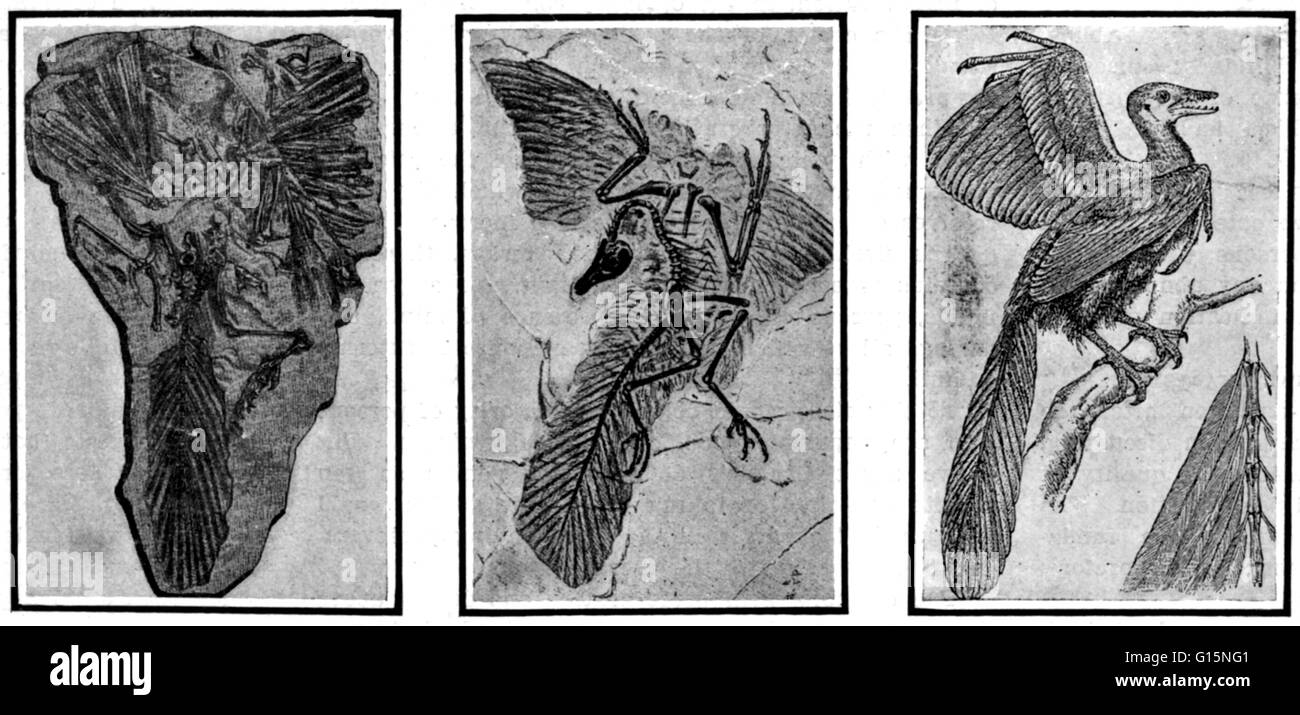 Archaeopteryx, sometimes referred to by its German name Urvogel (original bird or first bird), is a genus of early bird that is transitional between feathered dinosaurs and modern birds. It lived in the Late Jurassic period around 150 million years ago ha Stock Photohttps://www.alamy.com/image-license-details/?v=1https://www.alamy.com/stock-photo-archaeopteryx-sometimes-referred-to-by-its-german-name-urvogel-original-104003537.html
Archaeopteryx, sometimes referred to by its German name Urvogel (original bird or first bird), is a genus of early bird that is transitional between feathered dinosaurs and modern birds. It lived in the Late Jurassic period around 150 million years ago ha Stock Photohttps://www.alamy.com/image-license-details/?v=1https://www.alamy.com/stock-photo-archaeopteryx-sometimes-referred-to-by-its-german-name-urvogel-original-104003537.htmlRMG15NG1–Archaeopteryx, sometimes referred to by its German name Urvogel (original bird or first bird), is a genus of early bird that is transitional between feathered dinosaurs and modern birds. It lived in the Late Jurassic period around 150 million years ago ha
 String of 10 Beads, Late Period–Ptolemaic Period, 400–200 BC, From Egypt, Glass, L. 14 cm (5 1/2 in.), Mosaic glass beads had Stock Photohttps://www.alamy.com/image-license-details/?v=1https://www.alamy.com/stock-image-string-of-10-beads-late-periodptolemaic-period-400200-bc-from-egypt-162326987.html
String of 10 Beads, Late Period–Ptolemaic Period, 400–200 BC, From Egypt, Glass, L. 14 cm (5 1/2 in.), Mosaic glass beads had Stock Photohttps://www.alamy.com/image-license-details/?v=1https://www.alamy.com/stock-image-string-of-10-beads-late-periodptolemaic-period-400200-bc-from-egypt-162326987.htmlRMKC2HMB–String of 10 Beads, Late Period–Ptolemaic Period, 400–200 BC, From Egypt, Glass, L. 14 cm (5 1/2 in.), Mosaic glass beads had
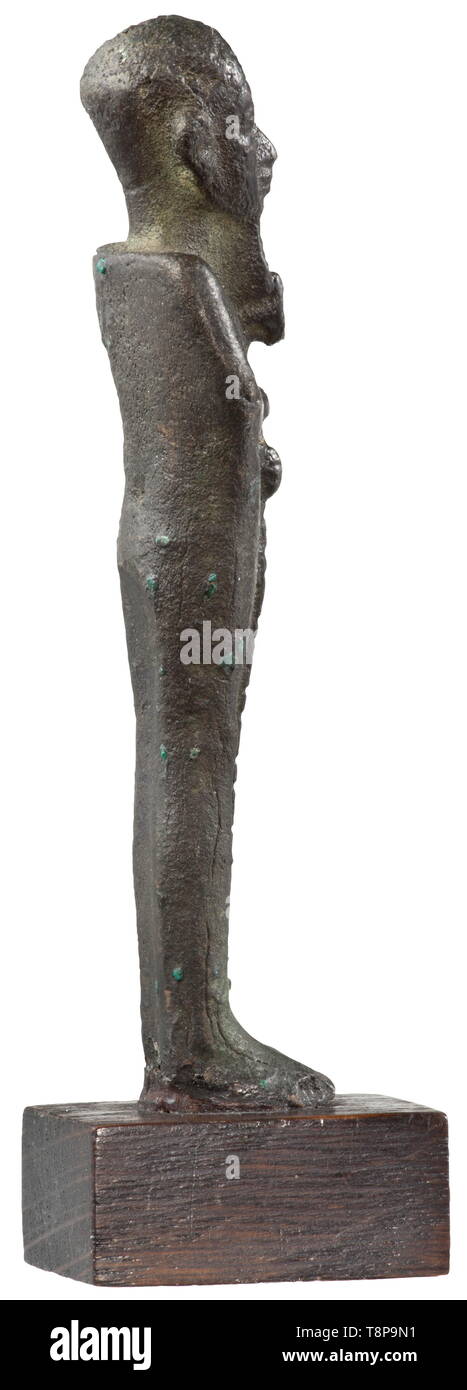 An ancient Egyptian bronze statuette of Ptah, Late Period, mid to end of the 1st millennium BC Upright standing depiction of the god as mummy with beard and cap, holding the Ankh-Djed-Was-sceptre in his hands. On a modern wooden base. Length without base 9.7 cm. Provenance: 1970s private collection from the Munich area. historic, historical, ancient world, Additional-Rights-Clearance-Info-Not-Available Stock Photohttps://www.alamy.com/image-license-details/?v=1https://www.alamy.com/an-ancient-egyptian-bronze-statuette-of-ptah-late-period-mid-to-end-of-the-1st-millennium-bc-upright-standing-depiction-of-the-god-as-mummy-with-beard-and-cap-holding-the-ankh-djed-was-sceptre-in-his-hands-on-a-modern-wooden-base-length-without-base-97-cm-provenance-1970s-private-collection-from-the-munich-area-historic-historical-ancient-world-additional-rights-clearance-info-not-available-image246352989.html
An ancient Egyptian bronze statuette of Ptah, Late Period, mid to end of the 1st millennium BC Upright standing depiction of the god as mummy with beard and cap, holding the Ankh-Djed-Was-sceptre in his hands. On a modern wooden base. Length without base 9.7 cm. Provenance: 1970s private collection from the Munich area. historic, historical, ancient world, Additional-Rights-Clearance-Info-Not-Available Stock Photohttps://www.alamy.com/image-license-details/?v=1https://www.alamy.com/an-ancient-egyptian-bronze-statuette-of-ptah-late-period-mid-to-end-of-the-1st-millennium-bc-upright-standing-depiction-of-the-god-as-mummy-with-beard-and-cap-holding-the-ankh-djed-was-sceptre-in-his-hands-on-a-modern-wooden-base-length-without-base-97-cm-provenance-1970s-private-collection-from-the-munich-area-historic-historical-ancient-world-additional-rights-clearance-info-not-available-image246352989.htmlRMT8P9N1–An ancient Egyptian bronze statuette of Ptah, Late Period, mid to end of the 1st millennium BC Upright standing depiction of the god as mummy with beard and cap, holding the Ankh-Djed-Was-sceptre in his hands. On a modern wooden base. Length without base 9.7 cm. Provenance: 1970s private collection from the Munich area. historic, historical, ancient world, Additional-Rights-Clearance-Info-Not-Available
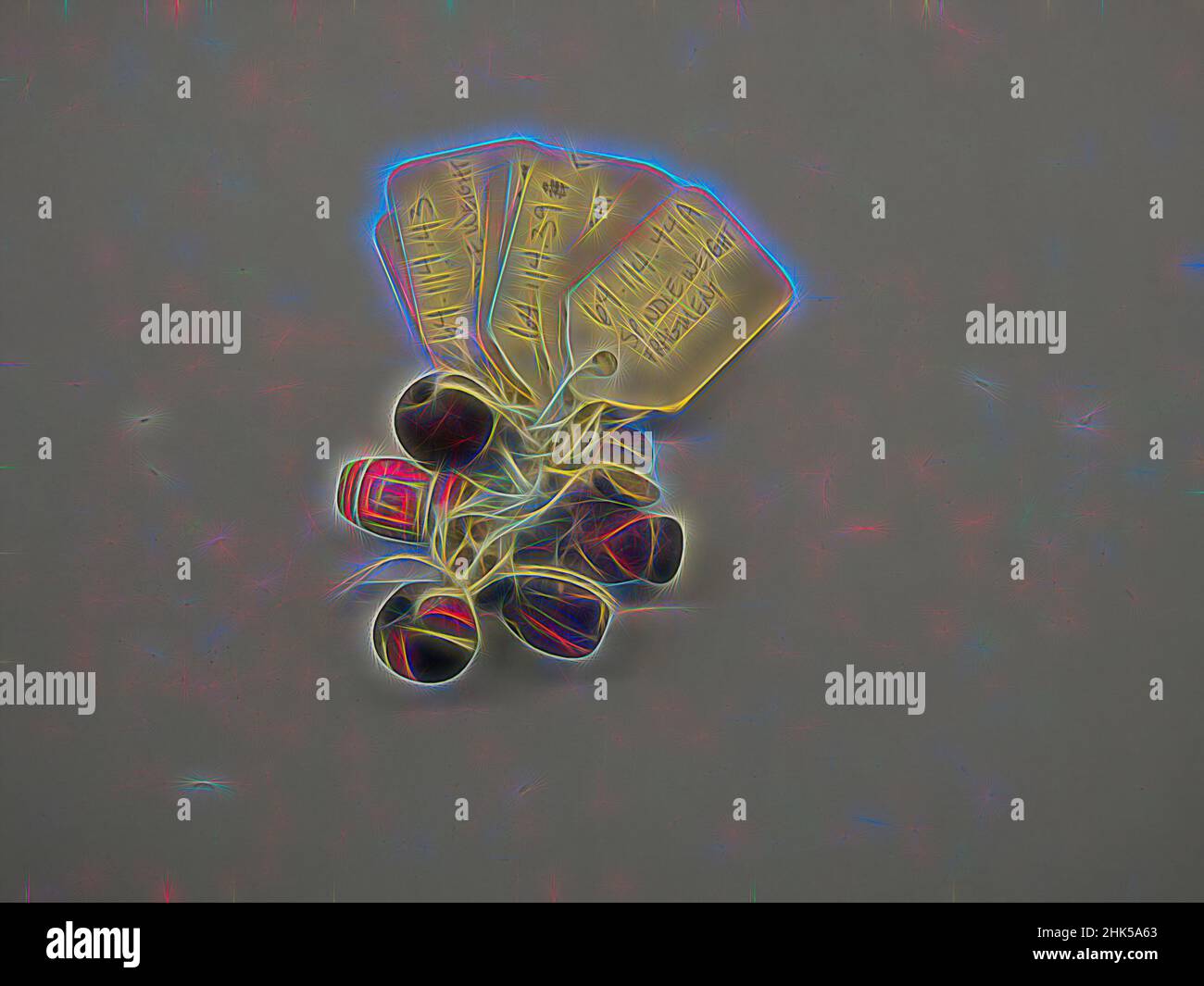 Inspired by Spindle Whorl, Ceramc, 1000-1532, Late Horizon or Late Intermediate Period, Reimagined by Artotop. Classic art reinvented with a modern twist. Design of warm cheerful glowing of brightness and light ray radiance. Photography inspired by surrealism and futurism, embracing dynamic energy of modern technology, movement, speed and revolutionize culture Stock Photohttps://www.alamy.com/image-license-details/?v=1https://www.alamy.com/inspired-by-spindle-whorl-ceramc-1000-1532-late-horizon-or-late-intermediate-period-reimagined-by-artotop-classic-art-reinvented-with-a-modern-twist-design-of-warm-cheerful-glowing-of-brightness-and-light-ray-radiance-photography-inspired-by-surrealism-and-futurism-embracing-dynamic-energy-of-modern-technology-movement-speed-and-revolutionize-culture-image459265803.html
Inspired by Spindle Whorl, Ceramc, 1000-1532, Late Horizon or Late Intermediate Period, Reimagined by Artotop. Classic art reinvented with a modern twist. Design of warm cheerful glowing of brightness and light ray radiance. Photography inspired by surrealism and futurism, embracing dynamic energy of modern technology, movement, speed and revolutionize culture Stock Photohttps://www.alamy.com/image-license-details/?v=1https://www.alamy.com/inspired-by-spindle-whorl-ceramc-1000-1532-late-horizon-or-late-intermediate-period-reimagined-by-artotop-classic-art-reinvented-with-a-modern-twist-design-of-warm-cheerful-glowing-of-brightness-and-light-ray-radiance-photography-inspired-by-surrealism-and-futurism-embracing-dynamic-energy-of-modern-technology-movement-speed-and-revolutionize-culture-image459265803.htmlRF2HK5A63–Inspired by Spindle Whorl, Ceramc, 1000-1532, Late Horizon or Late Intermediate Period, Reimagined by Artotop. Classic art reinvented with a modern twist. Design of warm cheerful glowing of brightness and light ray radiance. Photography inspired by surrealism and futurism, embracing dynamic energy of modern technology, movement, speed and revolutionize culture
 Photograph of Jean Sibelius (1865-1957) a Finnish composer and violinist of the late-Romantic and early-modern period. Dated 20th Century Stock Photohttps://www.alamy.com/image-license-details/?v=1https://www.alamy.com/stock-image-photograph-of-jean-sibelius-1865-1957-a-finnish-composer-and-violinist-162593303.html
Photograph of Jean Sibelius (1865-1957) a Finnish composer and violinist of the late-Romantic and early-modern period. Dated 20th Century Stock Photohttps://www.alamy.com/image-license-details/?v=1https://www.alamy.com/stock-image-photograph-of-jean-sibelius-1865-1957-a-finnish-composer-and-violinist-162593303.htmlRMKCENBK–Photograph of Jean Sibelius (1865-1957) a Finnish composer and violinist of the late-Romantic and early-modern period. Dated 20th Century
 Early 18th century flute player, caption reads: ' Directions for playing on the flute, with a scale for transposing any piece of musick to ... properest keys for that intrument.' From The Modern Musick-Master or The Universal Musician, published in London, 1731. Stock Photohttps://www.alamy.com/image-license-details/?v=1https://www.alamy.com/stock-image-early-18th-century-flute-player-caption-reads-directions-for-playing-163609413.html
Early 18th century flute player, caption reads: ' Directions for playing on the flute, with a scale for transposing any piece of musick to ... properest keys for that intrument.' From The Modern Musick-Master or The Universal Musician, published in London, 1731. Stock Photohttps://www.alamy.com/image-license-details/?v=1https://www.alamy.com/stock-image-early-18th-century-flute-player-caption-reads-directions-for-playing-163609413.htmlRMKE51D9–Early 18th century flute player, caption reads: ' Directions for playing on the flute, with a scale for transposing any piece of musick to ... properest keys for that intrument.' From The Modern Musick-Master or The Universal Musician, published in London, 1731.
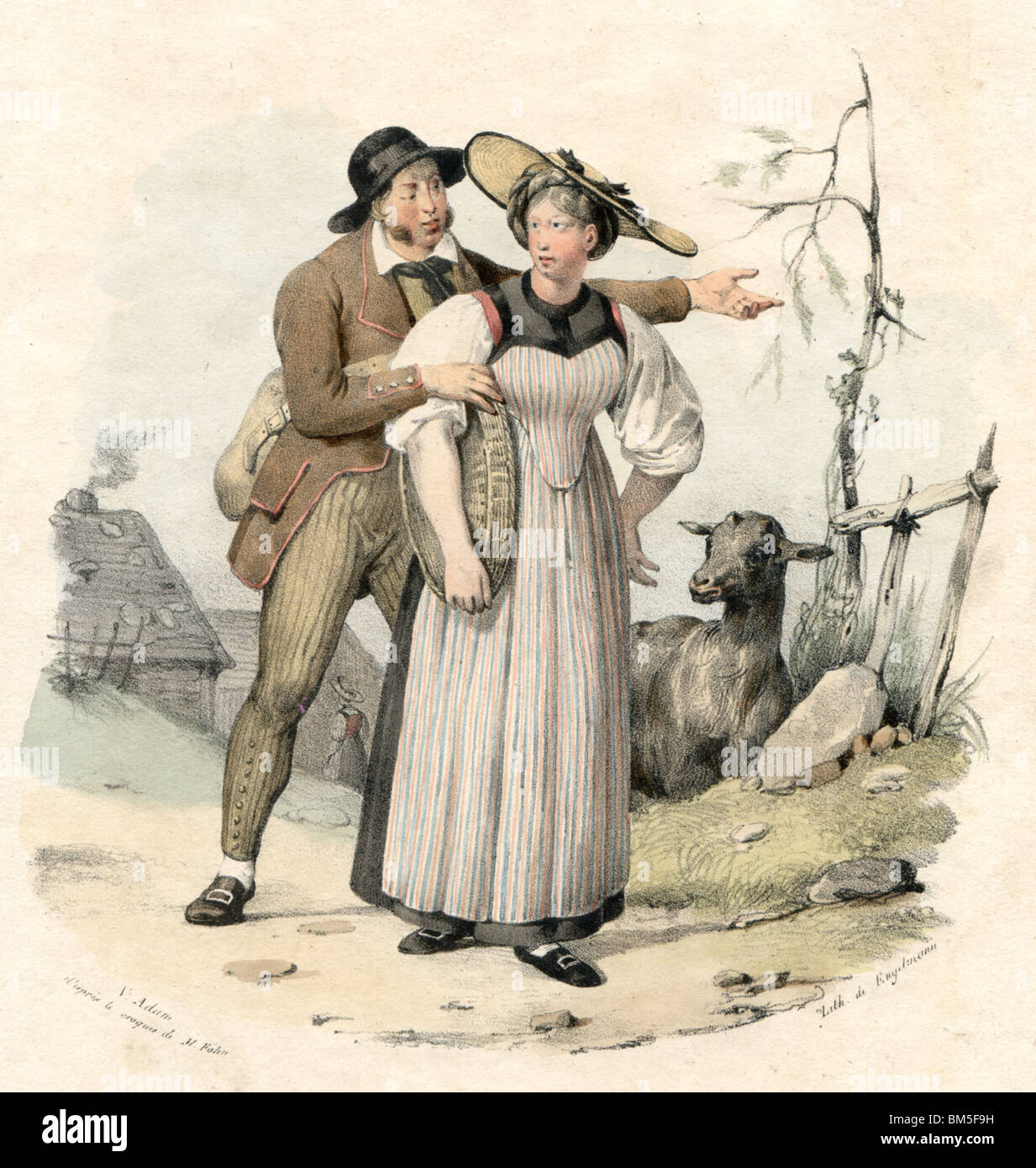 Modern Suisse Costumes, Late 1800's Stock Photohttps://www.alamy.com/image-license-details/?v=1https://www.alamy.com/stock-photo-modern-suisse-costumes-late-1800s-29625277.html
Modern Suisse Costumes, Late 1800's Stock Photohttps://www.alamy.com/image-license-details/?v=1https://www.alamy.com/stock-photo-modern-suisse-costumes-late-1800s-29625277.htmlRMBM5F9H–Modern Suisse Costumes, Late 1800's
 Heart Scarab (image 2 of 2), New Kingdom-Late Period (1569-525 BCE) or modern. Stock Photohttps://www.alamy.com/image-license-details/?v=1https://www.alamy.com/heart-scarab-image-2-of-2-new-kingdom-late-period-1569-525-bce-or-modern-image568865411.html
Heart Scarab (image 2 of 2), New Kingdom-Late Period (1569-525 BCE) or modern. Stock Photohttps://www.alamy.com/image-license-details/?v=1https://www.alamy.com/heart-scarab-image-2-of-2-new-kingdom-late-period-1569-525-bce-or-modern-image568865411.htmlRM2T1E1HR–Heart Scarab (image 2 of 2), New Kingdom-Late Period (1569-525 BCE) or modern.
 String of 8 Beads. Dimensions: L. 27.8 cm (10 15/16 in.). Date: 400-200 BC. Mosaic glass beads had long been popular in Egypt. The period of large intercontinental empires beginning about 500 BC initiated a period of widespread trade of these small items. These are all modern stringings; most ancient stringing patterns are lost as the string decays. Museum: Metropolitan Museum of Art, New York, USA. Stock Photohttps://www.alamy.com/image-license-details/?v=1https://www.alamy.com/string-of-8-beads-dimensions-l-278-cm-10-1516-in-date-400-200-bc-mosaic-glass-beads-had-long-been-popular-in-egypt-the-period-of-large-intercontinental-empires-beginning-about-500-bc-initiated-a-period-of-widespread-trade-of-these-small-items-these-are-all-modern-stringings-most-ancient-stringing-patterns-are-lost-as-the-string-decays-museum-metropolitan-museum-of-art-new-york-usa-image213212134.html
String of 8 Beads. Dimensions: L. 27.8 cm (10 15/16 in.). Date: 400-200 BC. Mosaic glass beads had long been popular in Egypt. The period of large intercontinental empires beginning about 500 BC initiated a period of widespread trade of these small items. These are all modern stringings; most ancient stringing patterns are lost as the string decays. Museum: Metropolitan Museum of Art, New York, USA. Stock Photohttps://www.alamy.com/image-license-details/?v=1https://www.alamy.com/string-of-8-beads-dimensions-l-278-cm-10-1516-in-date-400-200-bc-mosaic-glass-beads-had-long-been-popular-in-egypt-the-period-of-large-intercontinental-empires-beginning-about-500-bc-initiated-a-period-of-widespread-trade-of-these-small-items-these-are-all-modern-stringings-most-ancient-stringing-patterns-are-lost-as-the-string-decays-museum-metropolitan-museum-of-art-new-york-usa-image213212134.htmlRMPATJ72–String of 8 Beads. Dimensions: L. 27.8 cm (10 15/16 in.). Date: 400-200 BC. Mosaic glass beads had long been popular in Egypt. The period of large intercontinental empires beginning about 500 BC initiated a period of widespread trade of these small items. These are all modern stringings; most ancient stringing patterns are lost as the string decays. Museum: Metropolitan Museum of Art, New York, USA.
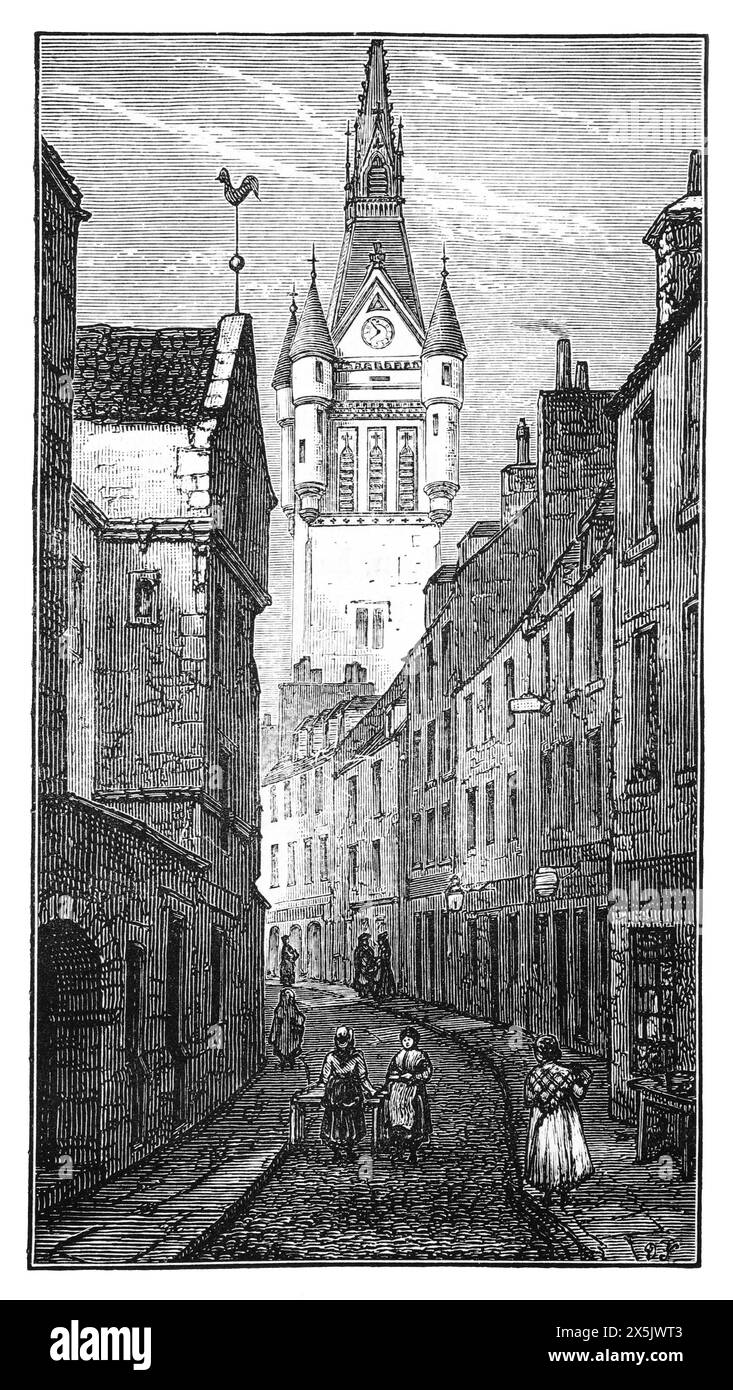 Ship Row, Aberdeen, Scotland in the late 19th century. This view looks north towrds the junction with Union Street. Most of the houses in this images have been replaced with modern buildings, though Provost Ross's house on the immediate left of this image still exists.. Black and White Illustration from Our Own Country Vol III published by Cassell, Petter, Galpin & Co. in the late 19th century. Stock Photohttps://www.alamy.com/image-license-details/?v=1https://www.alamy.com/ship-row-aberdeen-scotland-in-the-late-19th-century-this-view-looks-north-towrds-the-junction-with-union-street-most-of-the-houses-in-this-images-have-been-replaced-with-modern-buildings-though-provost-rosss-house-on-the-immediate-left-of-this-image-still-exists-black-and-white-illustration-from-our-own-country-vol-iii-published-by-cassell-petter-galpin-co-in-the-late-19th-century-image605851571.html
Ship Row, Aberdeen, Scotland in the late 19th century. This view looks north towrds the junction with Union Street. Most of the houses in this images have been replaced with modern buildings, though Provost Ross's house on the immediate left of this image still exists.. Black and White Illustration from Our Own Country Vol III published by Cassell, Petter, Galpin & Co. in the late 19th century. Stock Photohttps://www.alamy.com/image-license-details/?v=1https://www.alamy.com/ship-row-aberdeen-scotland-in-the-late-19th-century-this-view-looks-north-towrds-the-junction-with-union-street-most-of-the-houses-in-this-images-have-been-replaced-with-modern-buildings-though-provost-rosss-house-on-the-immediate-left-of-this-image-still-exists-black-and-white-illustration-from-our-own-country-vol-iii-published-by-cassell-petter-galpin-co-in-the-late-19th-century-image605851571.htmlRM2X5JWT3–Ship Row, Aberdeen, Scotland in the late 19th century. This view looks north towrds the junction with Union Street. Most of the houses in this images have been replaced with modern buildings, though Provost Ross's house on the immediate left of this image still exists.. Black and White Illustration from Our Own Country Vol III published by Cassell, Petter, Galpin & Co. in the late 19th century.
 Ocean vessel hull, c. 1500. Engraving, 19th century. Stock Photohttps://www.alamy.com/image-license-details/?v=1https://www.alamy.com/ocean-vessel-hull-c-1500-engraving-19th-century-image614433907.html
Ocean vessel hull, c. 1500. Engraving, 19th century. Stock Photohttps://www.alamy.com/image-license-details/?v=1https://www.alamy.com/ocean-vessel-hull-c-1500-engraving-19th-century-image614433907.htmlRM2XKHTM3–Ocean vessel hull, c. 1500. Engraving, 19th century.
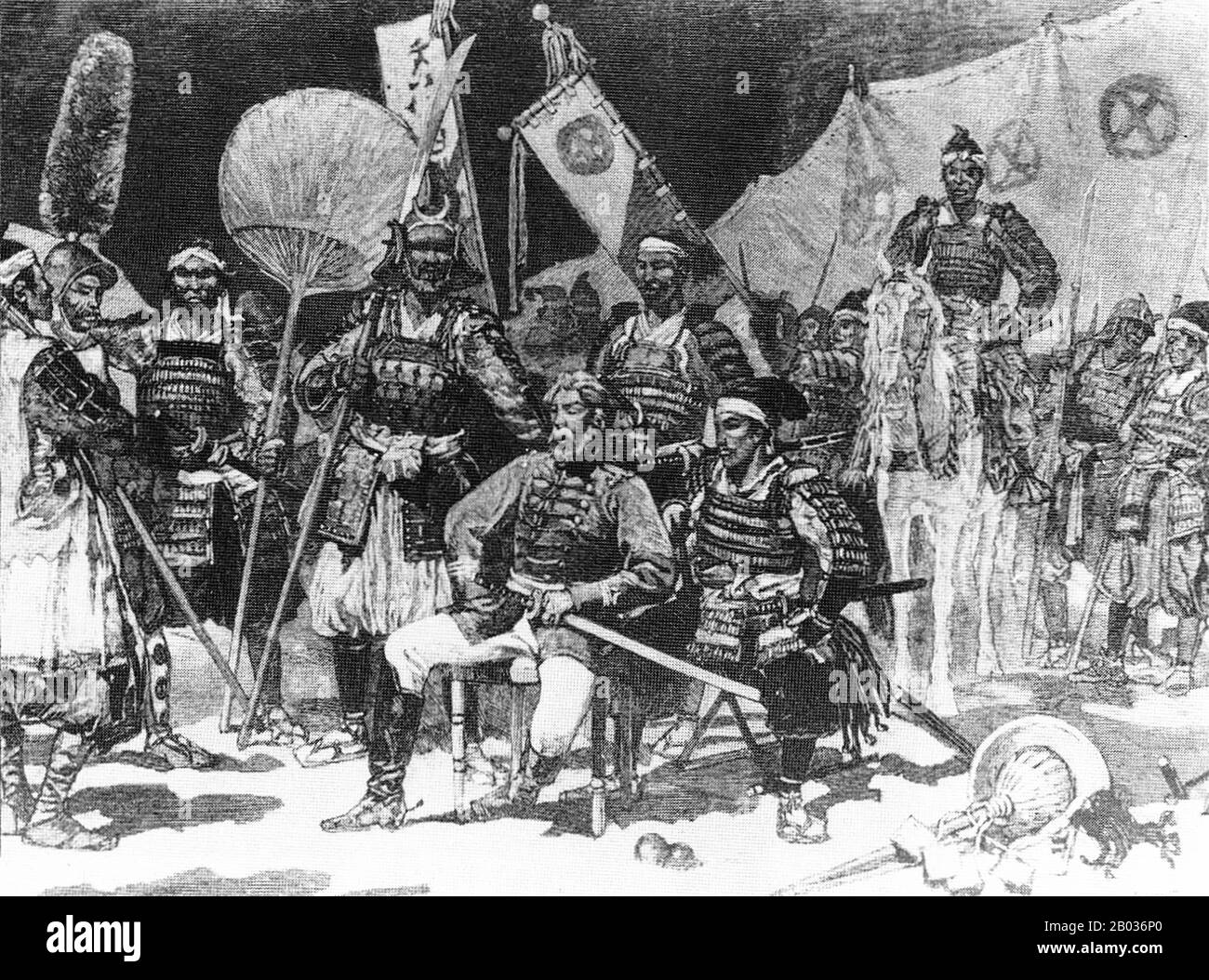 Saigo Takamori (1828-1877) was one of the most influential samurai in history, and seen by many as the last true samurai. Saigo lived during the late Edo and early Meiji Period, and had been born as Saigo Kokichi, taking the given name Takamori when he became an adult. He also wrote poetry under the name Saigo Nanshu. Saigo was from the Satsuma Domain (modern Kagoshima Prefecture, and started life as a low-ranking rural samurai. Saigo slowly rose to power and influence, assuming command over Satsuma and its soldiers, and he was a vocal opponent of the negotiated solution that led to the Meiji Stock Photohttps://www.alamy.com/image-license-details/?v=1https://www.alamy.com/saigo-takamori-1828-1877-was-one-of-the-most-influential-samurai-in-history-and-seen-by-many-as-the-last-true-samurai-saigo-lived-during-the-late-edo-and-early-meiji-period-and-had-been-born-as-saigo-kokichi-taking-the-given-name-takamori-when-he-became-an-adult-he-also-wrote-poetry-under-the-name-saigo-nanshu-saigo-was-from-the-satsuma-domain-modern-kagoshima-prefecture-and-started-life-as-a-low-ranking-rural-samurai-saigo-slowly-rose-to-power-and-influence-assuming-command-over-satsuma-and-its-soldiers-and-he-was-a-vocal-opponent-of-the-negotiated-solution-that-led-to-the-meiji-image344278536.html
Saigo Takamori (1828-1877) was one of the most influential samurai in history, and seen by many as the last true samurai. Saigo lived during the late Edo and early Meiji Period, and had been born as Saigo Kokichi, taking the given name Takamori when he became an adult. He also wrote poetry under the name Saigo Nanshu. Saigo was from the Satsuma Domain (modern Kagoshima Prefecture, and started life as a low-ranking rural samurai. Saigo slowly rose to power and influence, assuming command over Satsuma and its soldiers, and he was a vocal opponent of the negotiated solution that led to the Meiji Stock Photohttps://www.alamy.com/image-license-details/?v=1https://www.alamy.com/saigo-takamori-1828-1877-was-one-of-the-most-influential-samurai-in-history-and-seen-by-many-as-the-last-true-samurai-saigo-lived-during-the-late-edo-and-early-meiji-period-and-had-been-born-as-saigo-kokichi-taking-the-given-name-takamori-when-he-became-an-adult-he-also-wrote-poetry-under-the-name-saigo-nanshu-saigo-was-from-the-satsuma-domain-modern-kagoshima-prefecture-and-started-life-as-a-low-ranking-rural-samurai-saigo-slowly-rose-to-power-and-influence-assuming-command-over-satsuma-and-its-soldiers-and-he-was-a-vocal-opponent-of-the-negotiated-solution-that-led-to-the-meiji-image344278536.htmlRM2B036P0–Saigo Takamori (1828-1877) was one of the most influential samurai in history, and seen by many as the last true samurai. Saigo lived during the late Edo and early Meiji Period, and had been born as Saigo Kokichi, taking the given name Takamori when he became an adult. He also wrote poetry under the name Saigo Nanshu. Saigo was from the Satsuma Domain (modern Kagoshima Prefecture, and started life as a low-ranking rural samurai. Saigo slowly rose to power and influence, assuming command over Satsuma and its soldiers, and he was a vocal opponent of the negotiated solution that led to the Meiji
 Archaeopteryx, species that is transitional between non-avian dinosaurs and modern birds from the Late Jurassic period isolated on white background Stock Photohttps://www.alamy.com/image-license-details/?v=1https://www.alamy.com/archaeopteryx-species-that-is-transitional-between-non-avian-dinosaurs-and-modern-birds-from-the-late-jurassic-period-isolated-on-white-background-image354075764.html
Archaeopteryx, species that is transitional between non-avian dinosaurs and modern birds from the Late Jurassic period isolated on white background Stock Photohttps://www.alamy.com/image-license-details/?v=1https://www.alamy.com/archaeopteryx-species-that-is-transitional-between-non-avian-dinosaurs-and-modern-birds-from-the-late-jurassic-period-isolated-on-white-background-image354075764.htmlRF2BG1F70–Archaeopteryx, species that is transitional between non-avian dinosaurs and modern birds from the Late Jurassic period isolated on white background
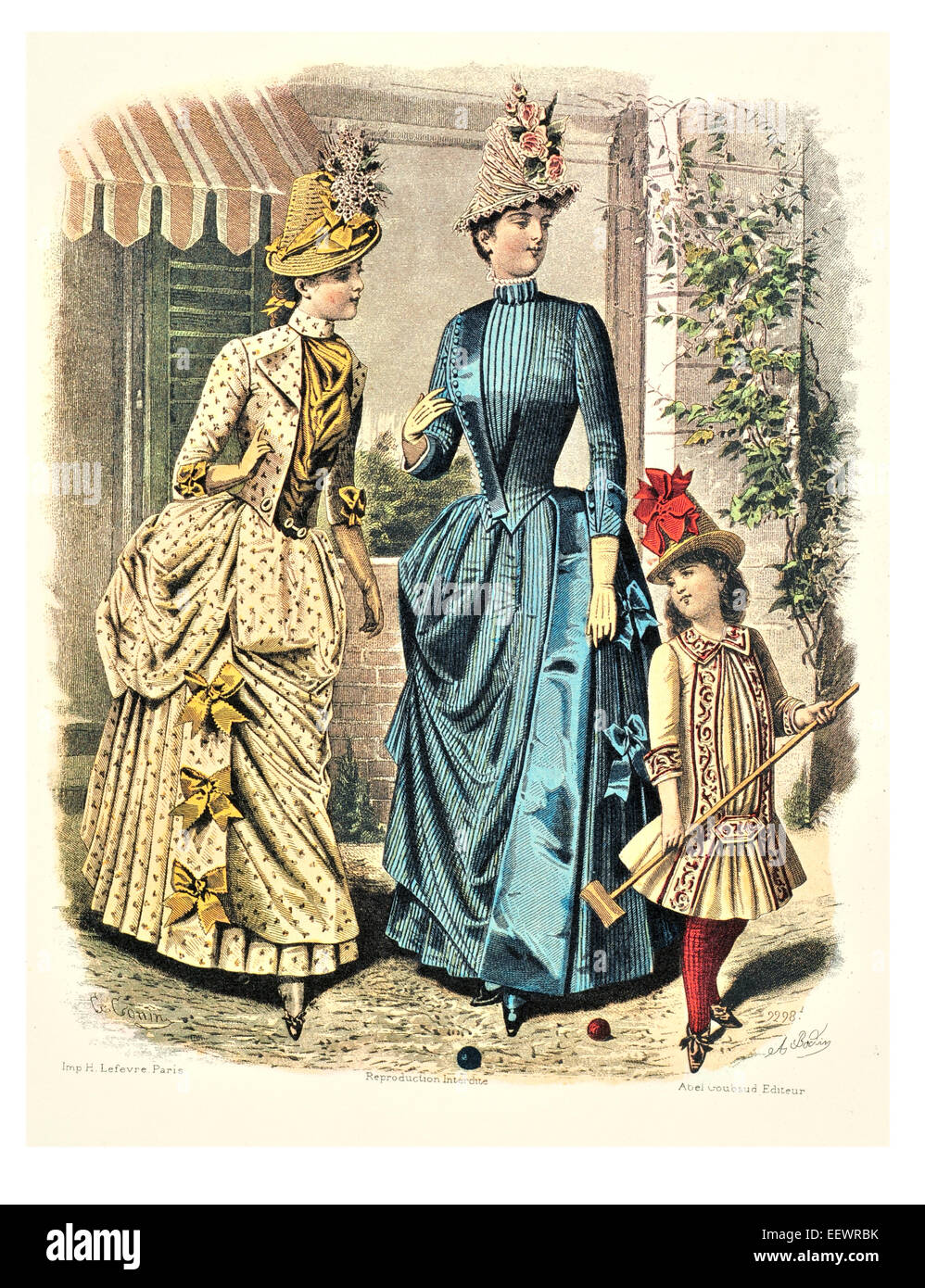 La Mode Illustree Victorian era period costume fashion dress gown gowns skirt veil cuff frills muslin cap embroidery embroidered Stock Photohttps://www.alamy.com/image-license-details/?v=1https://www.alamy.com/stock-photo-la-mode-illustree-victorian-era-period-costume-fashion-dress-gown-78013815.html
La Mode Illustree Victorian era period costume fashion dress gown gowns skirt veil cuff frills muslin cap embroidery embroidered Stock Photohttps://www.alamy.com/image-license-details/?v=1https://www.alamy.com/stock-photo-la-mode-illustree-victorian-era-period-costume-fashion-dress-gown-78013815.htmlRMEEWRBK–La Mode Illustree Victorian era period costume fashion dress gown gowns skirt veil cuff frills muslin cap embroidery embroidered
 Picturesque and historic buildings including some of the colleges, line the streets of Oxford, England. Oxford has a compact city centre with an outstanding collection of world famous buildings. Its origins lie in the late Saxon period and its original street pattern still survives along with some of its earliest monuments. It contains one of the best preserved groups of medieval and later university buildings in the world and a wealth of architectural gems from the classical to the modern and many of them owe their existence to the growth of the University of Oxford over 800 years. United Kin Stock Photohttps://www.alamy.com/image-license-details/?v=1https://www.alamy.com/picturesque-and-historic-buildings-including-some-of-the-colleges-line-the-streets-of-oxford-england-oxford-has-a-compact-city-centre-with-an-outstanding-collection-of-world-famous-buildings-its-origins-lie-in-the-late-saxon-period-and-its-original-street-pattern-still-survives-along-with-some-of-its-earliest-monuments-it-contains-one-of-the-best-preserved-groups-of-medieval-and-later-university-buildings-in-the-world-and-a-wealth-of-architectural-gems-from-the-classical-to-the-modern-and-many-of-them-owe-their-existence-to-the-growth-of-the-university-of-oxford-over-800-years-united-kin-image435475037.html
Picturesque and historic buildings including some of the colleges, line the streets of Oxford, England. Oxford has a compact city centre with an outstanding collection of world famous buildings. Its origins lie in the late Saxon period and its original street pattern still survives along with some of its earliest monuments. It contains one of the best preserved groups of medieval and later university buildings in the world and a wealth of architectural gems from the classical to the modern and many of them owe their existence to the growth of the University of Oxford over 800 years. United Kin Stock Photohttps://www.alamy.com/image-license-details/?v=1https://www.alamy.com/picturesque-and-historic-buildings-including-some-of-the-colleges-line-the-streets-of-oxford-england-oxford-has-a-compact-city-centre-with-an-outstanding-collection-of-world-famous-buildings-its-origins-lie-in-the-late-saxon-period-and-its-original-street-pattern-still-survives-along-with-some-of-its-earliest-monuments-it-contains-one-of-the-best-preserved-groups-of-medieval-and-later-university-buildings-in-the-world-and-a-wealth-of-architectural-gems-from-the-classical-to-the-modern-and-many-of-them-owe-their-existence-to-the-growth-of-the-university-of-oxford-over-800-years-united-kin-image435475037.htmlRM2G8DGRW–Picturesque and historic buildings including some of the colleges, line the streets of Oxford, England. Oxford has a compact city centre with an outstanding collection of world famous buildings. Its origins lie in the late Saxon period and its original street pattern still survives along with some of its earliest monuments. It contains one of the best preserved groups of medieval and later university buildings in the world and a wealth of architectural gems from the classical to the modern and many of them owe their existence to the growth of the University of Oxford over 800 years. United Kin
 Funerary urn with a face, Late Classic period, Pre-Columbian & Modern Glass Museum, Santo Domingo Church and Monastery, a ruined monastery from the 16 Stock Photohttps://www.alamy.com/image-license-details/?v=1https://www.alamy.com/funerary-urn-with-a-face-late-classic-period-pre-columbian-modern-glass-museum-santo-domingo-church-and-monastery-a-ruined-monastery-from-the-16-image607569590.html
Funerary urn with a face, Late Classic period, Pre-Columbian & Modern Glass Museum, Santo Domingo Church and Monastery, a ruined monastery from the 16 Stock Photohttps://www.alamy.com/image-license-details/?v=1https://www.alamy.com/funerary-urn-with-a-face-late-classic-period-pre-columbian-modern-glass-museum-santo-domingo-church-and-monastery-a-ruined-monastery-from-the-16-image607569590.htmlRM2X8D55X–Funerary urn with a face, Late Classic period, Pre-Columbian & Modern Glass Museum, Santo Domingo Church and Monastery, a ruined monastery from the 16
 Figurine of Seated Goddess. Egypt, Late Period (664 - 332 BCE) or modern. Sculpture. Bronze Stock Photohttps://www.alamy.com/image-license-details/?v=1https://www.alamy.com/figurine-of-seated-goddess-egypt-late-period-664-332-bce-or-modern-sculpture-bronze-image464782161.html
Figurine of Seated Goddess. Egypt, Late Period (664 - 332 BCE) or modern. Sculpture. Bronze Stock Photohttps://www.alamy.com/image-license-details/?v=1https://www.alamy.com/figurine-of-seated-goddess-egypt-late-period-664-332-bce-or-modern-sculpture-bronze-image464782161.htmlRM2J04JAW–Figurine of Seated Goddess. Egypt, Late Period (664 - 332 BCE) or modern. Sculpture. Bronze
 Romford Essex England. Photographed July 1970 but scans made in 2017 Small market town to the east of London embraces modern architecture from the late 1960's to 1970. Stock Photohttps://www.alamy.com/image-license-details/?v=1https://www.alamy.com/stock-image-romford-essex-england-photographed-july-1970-but-scans-made-in-2017-168547243.html
Romford Essex England. Photographed July 1970 but scans made in 2017 Small market town to the east of London embraces modern architecture from the late 1960's to 1970. Stock Photohttps://www.alamy.com/image-license-details/?v=1https://www.alamy.com/stock-image-romford-essex-england-photographed-july-1970-but-scans-made-in-2017-168547243.htmlRMKP5YMB–Romford Essex England. Photographed July 1970 but scans made in 2017 Small market town to the east of London embraces modern architecture from the late 1960's to 1970.
 A large stuccoed stone mask dated from the Late Pre Classic Period decorates the exterior of Structure 313 on the Central Acropolis at El Mirador a large pre-Columbian Maya settlement, located in a remote site deep in the jungle in the north of the modern department of El Peten, Guatemala Stock Photohttps://www.alamy.com/image-license-details/?v=1https://www.alamy.com/stock-photo-a-large-stuccoed-stone-mask-dated-from-the-late-pre-classic-period-140318966.html
A large stuccoed stone mask dated from the Late Pre Classic Period decorates the exterior of Structure 313 on the Central Acropolis at El Mirador a large pre-Columbian Maya settlement, located in a remote site deep in the jungle in the north of the modern department of El Peten, Guatemala Stock Photohttps://www.alamy.com/image-license-details/?v=1https://www.alamy.com/stock-photo-a-large-stuccoed-stone-mask-dated-from-the-late-pre-classic-period-140318966.htmlRMJ4827J–A large stuccoed stone mask dated from the Late Pre Classic Period decorates the exterior of Structure 313 on the Central Acropolis at El Mirador a large pre-Columbian Maya settlement, located in a remote site deep in the jungle in the north of the modern department of El Peten, Guatemala
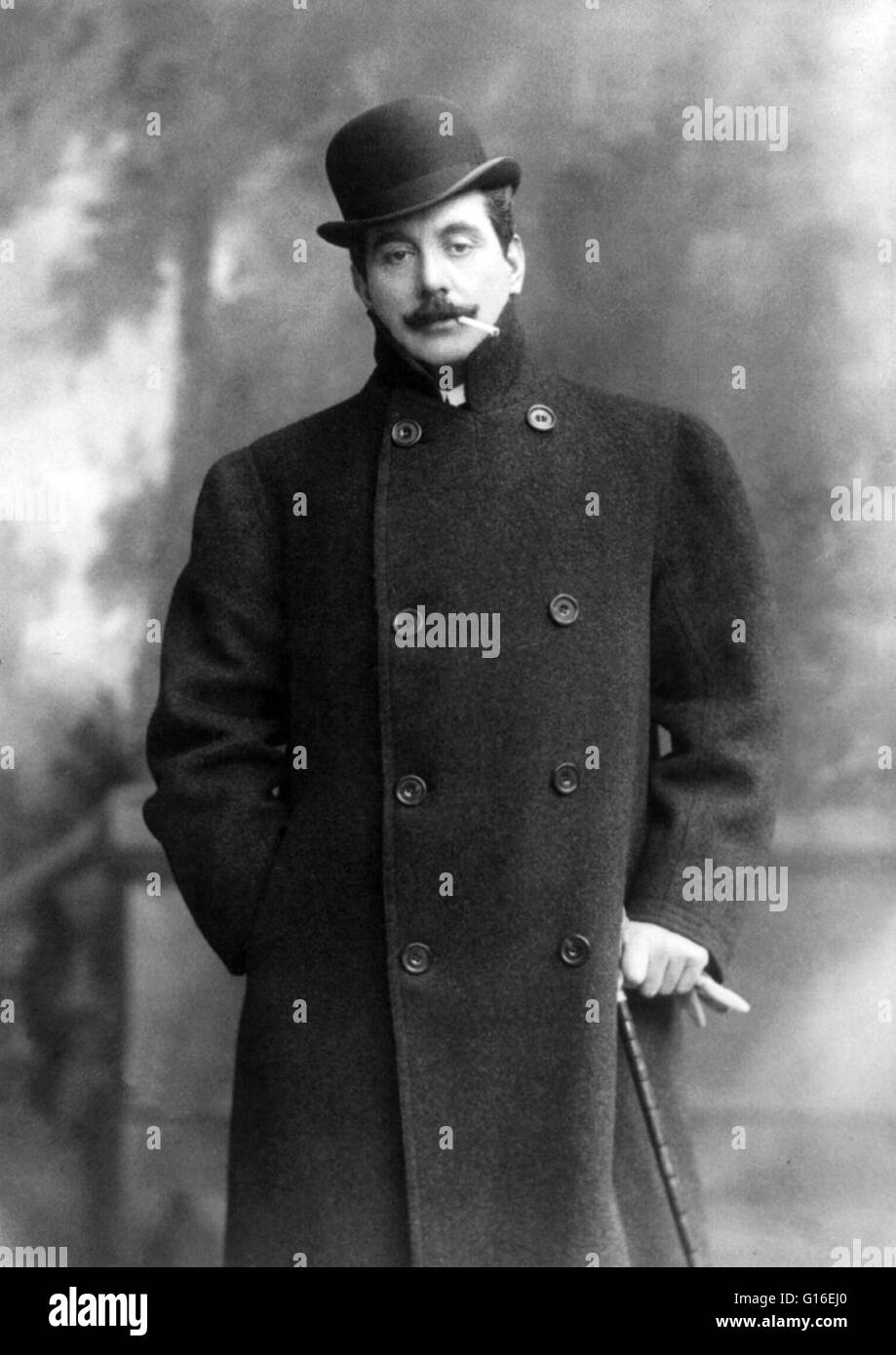 Giacomo Antonio Domenico Michele Secondo Maria Puccini (December 22, 1858 - November 29, 1924) was an Italian composer whose operas are among the important operas played as standards. His career extended from the end of the Romantic period into the modern Stock Photohttps://www.alamy.com/image-license-details/?v=1https://www.alamy.com/stock-photo-giacomo-antonio-domenico-michele-secondo-maria-puccini-december-22-104020056.html
Giacomo Antonio Domenico Michele Secondo Maria Puccini (December 22, 1858 - November 29, 1924) was an Italian composer whose operas are among the important operas played as standards. His career extended from the end of the Romantic period into the modern Stock Photohttps://www.alamy.com/image-license-details/?v=1https://www.alamy.com/stock-photo-giacomo-antonio-domenico-michele-secondo-maria-puccini-december-22-104020056.htmlRMG16EJ0–Giacomo Antonio Domenico Michele Secondo Maria Puccini (December 22, 1858 - November 29, 1924) was an Italian composer whose operas are among the important operas played as standards. His career extended from the end of the Romantic period into the modern
 String of 8 Beads, Late Period–Ptolemaic Period, 400–200 BC, From Egypt, Glass, L. 27.8 cm (10 15/16 in.), Mosaic glass beads Stock Photohttps://www.alamy.com/image-license-details/?v=1https://www.alamy.com/stock-image-string-of-8-beads-late-periodptolemaic-period-400200-bc-from-egypt-162326991.html
String of 8 Beads, Late Period–Ptolemaic Period, 400–200 BC, From Egypt, Glass, L. 27.8 cm (10 15/16 in.), Mosaic glass beads Stock Photohttps://www.alamy.com/image-license-details/?v=1https://www.alamy.com/stock-image-string-of-8-beads-late-periodptolemaic-period-400200-bc-from-egypt-162326991.htmlRMKC2HMF–String of 8 Beads, Late Period–Ptolemaic Period, 400–200 BC, From Egypt, Glass, L. 27.8 cm (10 15/16 in.), Mosaic glass beads
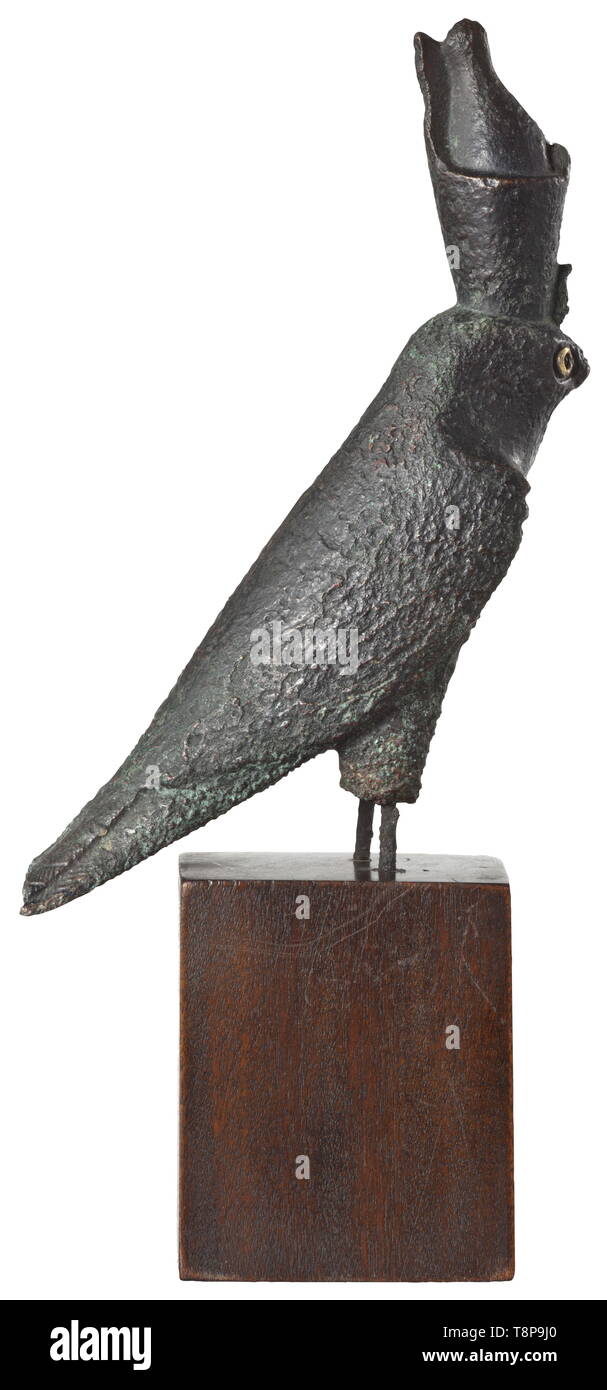 An ancient Egyptian statuette of the Horus falcon, Late Period, mid- to 2nd half of the 1st millennium BC Bronze falcon with double crown. The circular gold inlay of the right eye has been preserved. The surface slightly corroded, therein visible the lines of the former chiselling to depict the plumage. The talons and the lower parts of the legs are broken off. On a modern wooden base. Height without base 15 cm. Appealing, expressive small-scale sculpture. Provenance: 1970s private collection from the Munich areas. historic, historical, ancient w, Additional-Rights-Clearance-Info-Not-Available Stock Photohttps://www.alamy.com/image-license-details/?v=1https://www.alamy.com/an-ancient-egyptian-statuette-of-the-horus-falcon-late-period-mid-to-2nd-half-of-the-1st-millennium-bc-bronze-falcon-with-double-crown-the-circular-gold-inlay-of-the-right-eye-has-been-preserved-the-surface-slightly-corroded-therein-visible-the-lines-of-the-former-chiselling-to-depict-the-plumage-the-talons-and-the-lower-parts-of-the-legs-are-broken-off-on-a-modern-wooden-base-height-without-base-15-cm-appealing-expressive-small-scale-sculpture-provenance-1970s-private-collection-from-the-munich-areas-historic-historical-ancient-w-additional-rights-clearance-info-not-available-image246352904.html
An ancient Egyptian statuette of the Horus falcon, Late Period, mid- to 2nd half of the 1st millennium BC Bronze falcon with double crown. The circular gold inlay of the right eye has been preserved. The surface slightly corroded, therein visible the lines of the former chiselling to depict the plumage. The talons and the lower parts of the legs are broken off. On a modern wooden base. Height without base 15 cm. Appealing, expressive small-scale sculpture. Provenance: 1970s private collection from the Munich areas. historic, historical, ancient w, Additional-Rights-Clearance-Info-Not-Available Stock Photohttps://www.alamy.com/image-license-details/?v=1https://www.alamy.com/an-ancient-egyptian-statuette-of-the-horus-falcon-late-period-mid-to-2nd-half-of-the-1st-millennium-bc-bronze-falcon-with-double-crown-the-circular-gold-inlay-of-the-right-eye-has-been-preserved-the-surface-slightly-corroded-therein-visible-the-lines-of-the-former-chiselling-to-depict-the-plumage-the-talons-and-the-lower-parts-of-the-legs-are-broken-off-on-a-modern-wooden-base-height-without-base-15-cm-appealing-expressive-small-scale-sculpture-provenance-1970s-private-collection-from-the-munich-areas-historic-historical-ancient-w-additional-rights-clearance-info-not-available-image246352904.htmlRMT8P9J0–An ancient Egyptian statuette of the Horus falcon, Late Period, mid- to 2nd half of the 1st millennium BC Bronze falcon with double crown. The circular gold inlay of the right eye has been preserved. The surface slightly corroded, therein visible the lines of the former chiselling to depict the plumage. The talons and the lower parts of the legs are broken off. On a modern wooden base. Height without base 15 cm. Appealing, expressive small-scale sculpture. Provenance: 1970s private collection from the Munich areas. historic, historical, ancient w, Additional-Rights-Clearance-Info-Not-Available
 Inspired by Spindle Whorl, Ceramic, 1000-1532, Late Horizon or Late Intermediate Period, Reimagined by Artotop. Classic art reinvented with a modern twist. Design of warm cheerful glowing of brightness and light ray radiance. Photography inspired by surrealism and futurism, embracing dynamic energy of modern technology, movement, speed and revolutionize culture Stock Photohttps://www.alamy.com/image-license-details/?v=1https://www.alamy.com/inspired-by-spindle-whorl-ceramic-1000-1532-late-horizon-or-late-intermediate-period-reimagined-by-artotop-classic-art-reinvented-with-a-modern-twist-design-of-warm-cheerful-glowing-of-brightness-and-light-ray-radiance-photography-inspired-by-surrealism-and-futurism-embracing-dynamic-energy-of-modern-technology-movement-speed-and-revolutionize-culture-image459265811.html
Inspired by Spindle Whorl, Ceramic, 1000-1532, Late Horizon or Late Intermediate Period, Reimagined by Artotop. Classic art reinvented with a modern twist. Design of warm cheerful glowing of brightness and light ray radiance. Photography inspired by surrealism and futurism, embracing dynamic energy of modern technology, movement, speed and revolutionize culture Stock Photohttps://www.alamy.com/image-license-details/?v=1https://www.alamy.com/inspired-by-spindle-whorl-ceramic-1000-1532-late-horizon-or-late-intermediate-period-reimagined-by-artotop-classic-art-reinvented-with-a-modern-twist-design-of-warm-cheerful-glowing-of-brightness-and-light-ray-radiance-photography-inspired-by-surrealism-and-futurism-embracing-dynamic-energy-of-modern-technology-movement-speed-and-revolutionize-culture-image459265811.htmlRF2HK5A6B–Inspired by Spindle Whorl, Ceramic, 1000-1532, Late Horizon or Late Intermediate Period, Reimagined by Artotop. Classic art reinvented with a modern twist. Design of warm cheerful glowing of brightness and light ray radiance. Photography inspired by surrealism and futurism, embracing dynamic energy of modern technology, movement, speed and revolutionize culture
 Photograph of Jean Sibelius (1865-1957) a Finnish composer and violinist of the late-Romantic and early-modern period. Dated 20th Century Stock Photohttps://www.alamy.com/image-license-details/?v=1https://www.alamy.com/stock-image-photograph-of-jean-sibelius-1865-1957-a-finnish-composer-and-violinist-162593301.html
Photograph of Jean Sibelius (1865-1957) a Finnish composer and violinist of the late-Romantic and early-modern period. Dated 20th Century Stock Photohttps://www.alamy.com/image-license-details/?v=1https://www.alamy.com/stock-image-photograph-of-jean-sibelius-1865-1957-a-finnish-composer-and-violinist-162593301.htmlRMKCENBH–Photograph of Jean Sibelius (1865-1957) a Finnish composer and violinist of the late-Romantic and early-modern period. Dated 20th Century
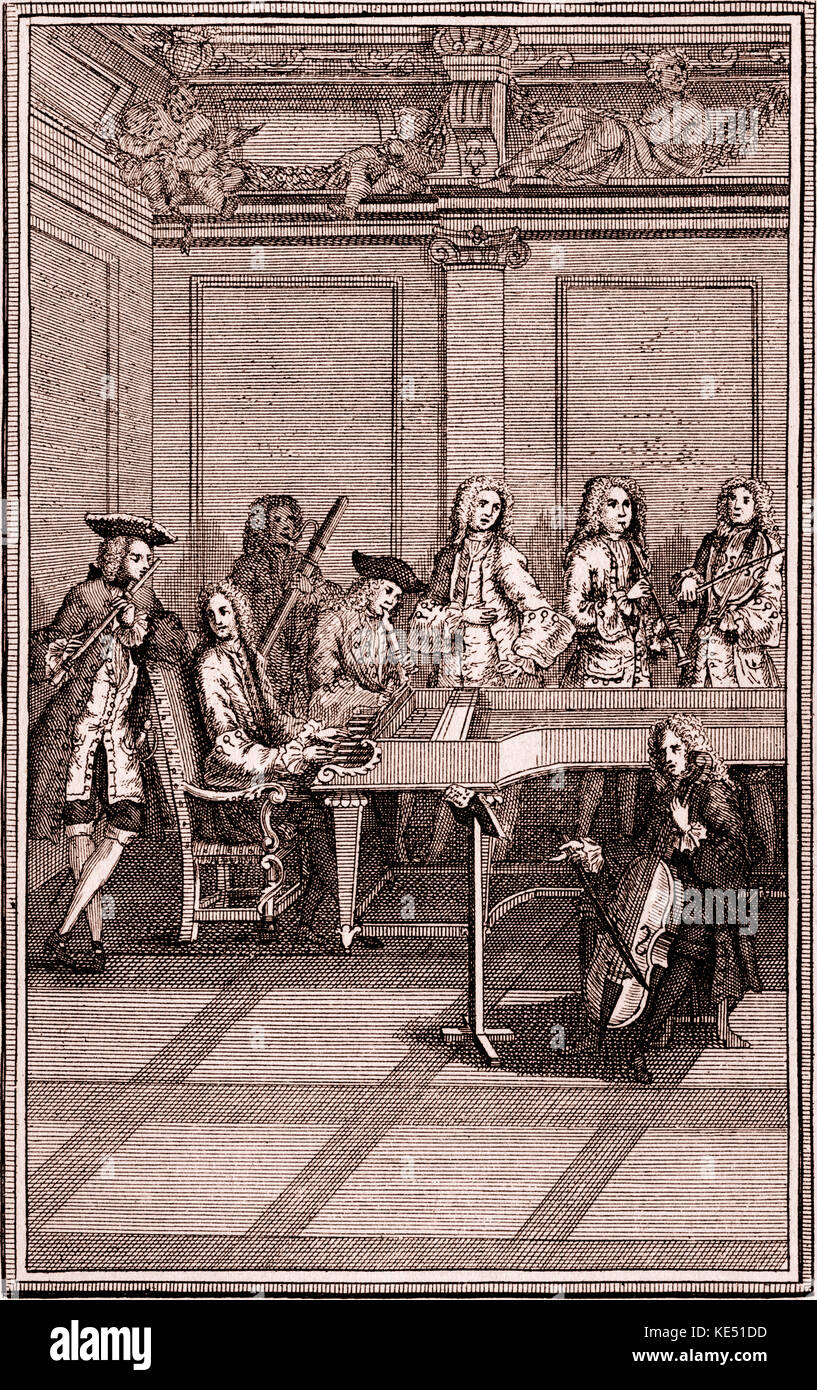 Chamber music ensemble - early 18th century (l-r) flute, harpsichord, bassoon, singer, hautboy/hautbois/oboe, viola da gamba and violin. From the book The Modern Musick-Master or The Universal Musician, published in London, 1731. Stock Photohttps://www.alamy.com/image-license-details/?v=1https://www.alamy.com/stock-image-chamber-music-ensemble-early-18th-century-l-r-flute-harpsichord-bassoon-163609417.html
Chamber music ensemble - early 18th century (l-r) flute, harpsichord, bassoon, singer, hautboy/hautbois/oboe, viola da gamba and violin. From the book The Modern Musick-Master or The Universal Musician, published in London, 1731. Stock Photohttps://www.alamy.com/image-license-details/?v=1https://www.alamy.com/stock-image-chamber-music-ensemble-early-18th-century-l-r-flute-harpsichord-bassoon-163609417.htmlRMKE51DD–Chamber music ensemble - early 18th century (l-r) flute, harpsichord, bassoon, singer, hautboy/hautbois/oboe, viola da gamba and violin. From the book The Modern Musick-Master or The Universal Musician, published in London, 1731.
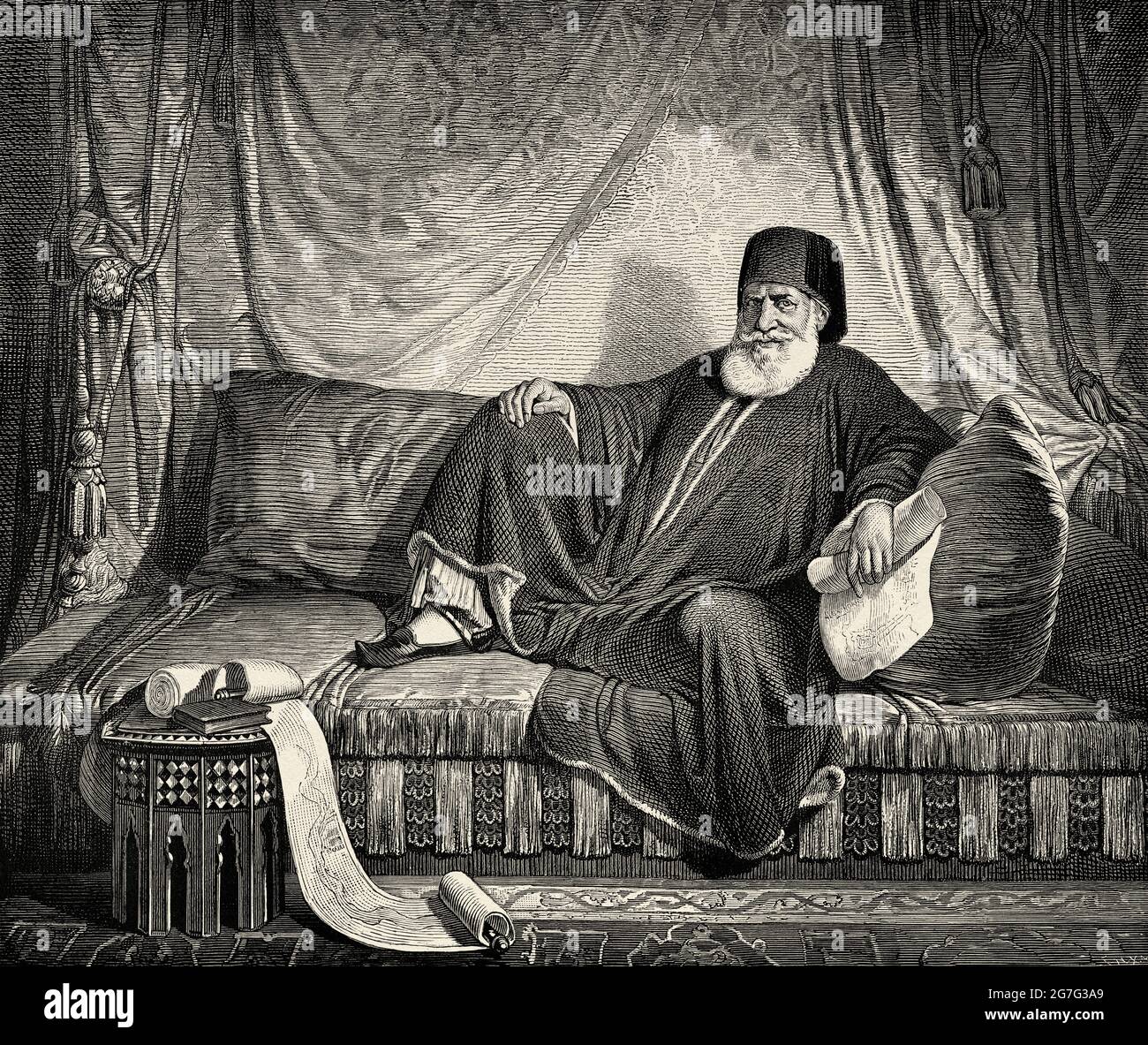 Portrait of Mehemet Ali or Muhammad Ali Pasha al-Mas'ud ibn Agha (Kavala 1769 - Alexandria 1849) governor and later King of Egypt. Creator of modern Egypt, North Africa. Old 19th century engraved illustration from El Mundo Ilustrado 1880 Stock Photohttps://www.alamy.com/image-license-details/?v=1https://www.alamy.com/portrait-of-mehemet-ali-or-muhammad-ali-pasha-al-masud-ibn-agha-kavala-1769-alexandria-1849-governor-and-later-king-of-egypt-creator-of-modern-egypt-north-africa-old-19th-century-engraved-illustration-from-el-mundo-ilustrado-1880-image434915665.html
Portrait of Mehemet Ali or Muhammad Ali Pasha al-Mas'ud ibn Agha (Kavala 1769 - Alexandria 1849) governor and later King of Egypt. Creator of modern Egypt, North Africa. Old 19th century engraved illustration from El Mundo Ilustrado 1880 Stock Photohttps://www.alamy.com/image-license-details/?v=1https://www.alamy.com/portrait-of-mehemet-ali-or-muhammad-ali-pasha-al-masud-ibn-agha-kavala-1769-alexandria-1849-governor-and-later-king-of-egypt-creator-of-modern-egypt-north-africa-old-19th-century-engraved-illustration-from-el-mundo-ilustrado-1880-image434915665.htmlRM2G7G3A9–Portrait of Mehemet Ali or Muhammad Ali Pasha al-Mas'ud ibn Agha (Kavala 1769 - Alexandria 1849) governor and later King of Egypt. Creator of modern Egypt, North Africa. Old 19th century engraved illustration from El Mundo Ilustrado 1880
 Figurine of Seated Lion with Turned Head, Late Roman Period-early Islamic Period (400-800 CE) or modern. Stock Photohttps://www.alamy.com/image-license-details/?v=1https://www.alamy.com/figurine-of-seated-lion-with-turned-head-late-roman-period-early-islamic-period-400-800-ce-or-modern-image568865490.html
Figurine of Seated Lion with Turned Head, Late Roman Period-early Islamic Period (400-800 CE) or modern. Stock Photohttps://www.alamy.com/image-license-details/?v=1https://www.alamy.com/figurine-of-seated-lion-with-turned-head-late-roman-period-early-islamic-period-400-800-ce-or-modern-image568865490.htmlRM2T1E1MJ–Figurine of Seated Lion with Turned Head, Late Roman Period-early Islamic Period (400-800 CE) or modern.
 String of 12 Eye Beads. Dimensions: L. 10.5 cm (4 1/8 in.). Date: 600-200 BC. Mosaic glass beads had long been popular in Egypt. The period of large intercontinental empires beginning about 500 BC initiated a period of widespread trade of these small items. These are all modern stringings; most ancient stringing patterns are lost as the string decays. Museum: Metropolitan Museum of Art, New York, USA. Stock Photohttps://www.alamy.com/image-license-details/?v=1https://www.alamy.com/string-of-12-eye-beads-dimensions-l-105-cm-4-18-in-date-600-200-bc-mosaic-glass-beads-had-long-been-popular-in-egypt-the-period-of-large-intercontinental-empires-beginning-about-500-bc-initiated-a-period-of-widespread-trade-of-these-small-items-these-are-all-modern-stringings-most-ancient-stringing-patterns-are-lost-as-the-string-decays-museum-metropolitan-museum-of-art-new-york-usa-image213113036.html
String of 12 Eye Beads. Dimensions: L. 10.5 cm (4 1/8 in.). Date: 600-200 BC. Mosaic glass beads had long been popular in Egypt. The period of large intercontinental empires beginning about 500 BC initiated a period of widespread trade of these small items. These are all modern stringings; most ancient stringing patterns are lost as the string decays. Museum: Metropolitan Museum of Art, New York, USA. Stock Photohttps://www.alamy.com/image-license-details/?v=1https://www.alamy.com/string-of-12-eye-beads-dimensions-l-105-cm-4-18-in-date-600-200-bc-mosaic-glass-beads-had-long-been-popular-in-egypt-the-period-of-large-intercontinental-empires-beginning-about-500-bc-initiated-a-period-of-widespread-trade-of-these-small-items-these-are-all-modern-stringings-most-ancient-stringing-patterns-are-lost-as-the-string-decays-museum-metropolitan-museum-of-art-new-york-usa-image213113036.htmlRMPAM3RT–String of 12 Eye Beads. Dimensions: L. 10.5 cm (4 1/8 in.). Date: 600-200 BC. Mosaic glass beads had long been popular in Egypt. The period of large intercontinental empires beginning about 500 BC initiated a period of widespread trade of these small items. These are all modern stringings; most ancient stringing patterns are lost as the string decays. Museum: Metropolitan Museum of Art, New York, USA.
 The Palace of the Late Nabob of Arcot. A Brief History Of Ancient & Modern India, from the Earliest Period In Antiquity To The Termination Of The Late Mahratta War. London, Edward Orme, 1805. Source: X 768, plate 1. Author: Blagdon, Francis William. Ward, Francis Swain: Orme, William. Stock Photohttps://www.alamy.com/image-license-details/?v=1https://www.alamy.com/the-palace-of-the-late-nabob-of-arcot-a-brief-history-of-ancient-modern-india-from-the-earliest-period-in-antiquity-to-the-termination-of-the-late-mahratta-war-london-edward-orme-1805-source-x-768-plate-1-author-blagdon-francis-william-ward-francis-swain-orme-william-image227161637.html
The Palace of the Late Nabob of Arcot. A Brief History Of Ancient & Modern India, from the Earliest Period In Antiquity To The Termination Of The Late Mahratta War. London, Edward Orme, 1805. Source: X 768, plate 1. Author: Blagdon, Francis William. Ward, Francis Swain: Orme, William. Stock Photohttps://www.alamy.com/image-license-details/?v=1https://www.alamy.com/the-palace-of-the-late-nabob-of-arcot-a-brief-history-of-ancient-modern-india-from-the-earliest-period-in-antiquity-to-the-termination-of-the-late-mahratta-war-london-edward-orme-1805-source-x-768-plate-1-author-blagdon-francis-william-ward-francis-swain-orme-william-image227161637.htmlRMR5G2YH–The Palace of the Late Nabob of Arcot. A Brief History Of Ancient & Modern India, from the Earliest Period In Antiquity To The Termination Of The Late Mahratta War. London, Edward Orme, 1805. Source: X 768, plate 1. Author: Blagdon, Francis William. Ward, Francis Swain: Orme, William.
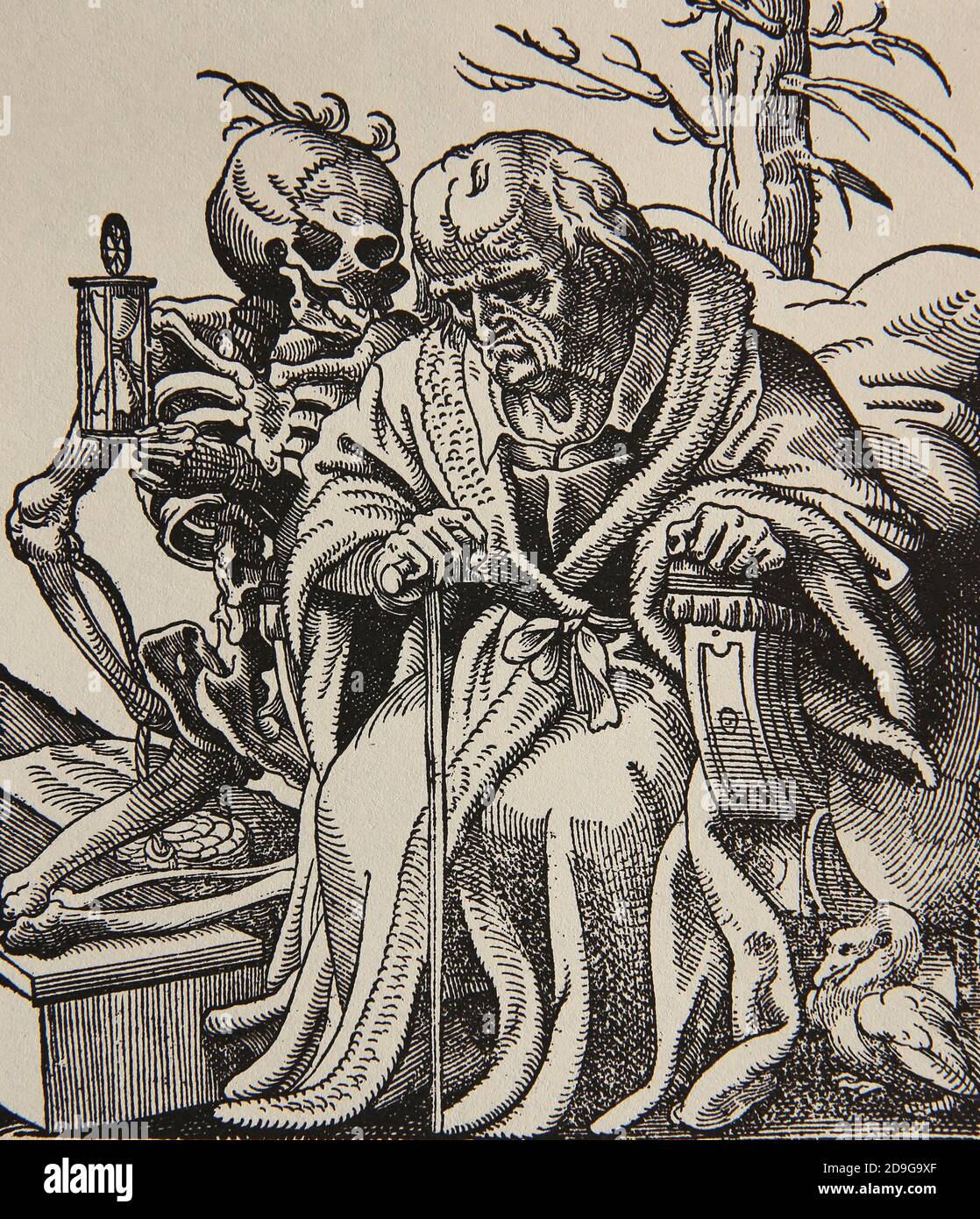 Old man and Death. Engraving by Jost Amman, 1599. Modern period. Europe. Stock Photohttps://www.alamy.com/image-license-details/?v=1https://www.alamy.com/old-man-and-death-engraving-by-jost-amman-1599-modern-period-europe-image384519031.html
Old man and Death. Engraving by Jost Amman, 1599. Modern period. Europe. Stock Photohttps://www.alamy.com/image-license-details/?v=1https://www.alamy.com/old-man-and-death-engraving-by-jost-amman-1599-modern-period-europe-image384519031.htmlRM2D9G9XF–Old man and Death. Engraving by Jost Amman, 1599. Modern period. Europe.
 Log house, Marshal Zhukov Street #95 (around 1900), foreground, and in the background is a typical modern apartment building of the post Soviet period (late 1990s), Omsk, Russia. Brumfield photograph collection. Log buildings,Russia Federation,1990-2000. , Apartment houses,Russia Federation,1990-2000. , Russia Federation,Omskaia oblast ,Omsk. Stock Photohttps://www.alamy.com/image-license-details/?v=1https://www.alamy.com/log-house-marshal-zhukov-street-95-around-1900-foreground-and-in-the-background-is-a-typical-modern-apartment-building-of-the-post-soviet-period-late-1990s-omsk-russia-brumfield-photograph-collection-log-buildingsrussia-federation1990-2000-apartment-housesrussia-federation1990-2000-russia-federationomskaia-oblast-omsk-image528607759.html
Log house, Marshal Zhukov Street #95 (around 1900), foreground, and in the background is a typical modern apartment building of the post Soviet period (late 1990s), Omsk, Russia. Brumfield photograph collection. Log buildings,Russia Federation,1990-2000. , Apartment houses,Russia Federation,1990-2000. , Russia Federation,Omskaia oblast ,Omsk. Stock Photohttps://www.alamy.com/image-license-details/?v=1https://www.alamy.com/log-house-marshal-zhukov-street-95-around-1900-foreground-and-in-the-background-is-a-typical-modern-apartment-building-of-the-post-soviet-period-late-1990s-omsk-russia-brumfield-photograph-collection-log-buildingsrussia-federation1990-2000-apartment-housesrussia-federation1990-2000-russia-federationomskaia-oblast-omsk-image528607759.htmlRM2NM04GF–Log house, Marshal Zhukov Street #95 (around 1900), foreground, and in the background is a typical modern apartment building of the post Soviet period (late 1990s), Omsk, Russia. Brumfield photograph collection. Log buildings,Russia Federation,1990-2000. , Apartment houses,Russia Federation,1990-2000. , Russia Federation,Omskaia oblast ,Omsk.
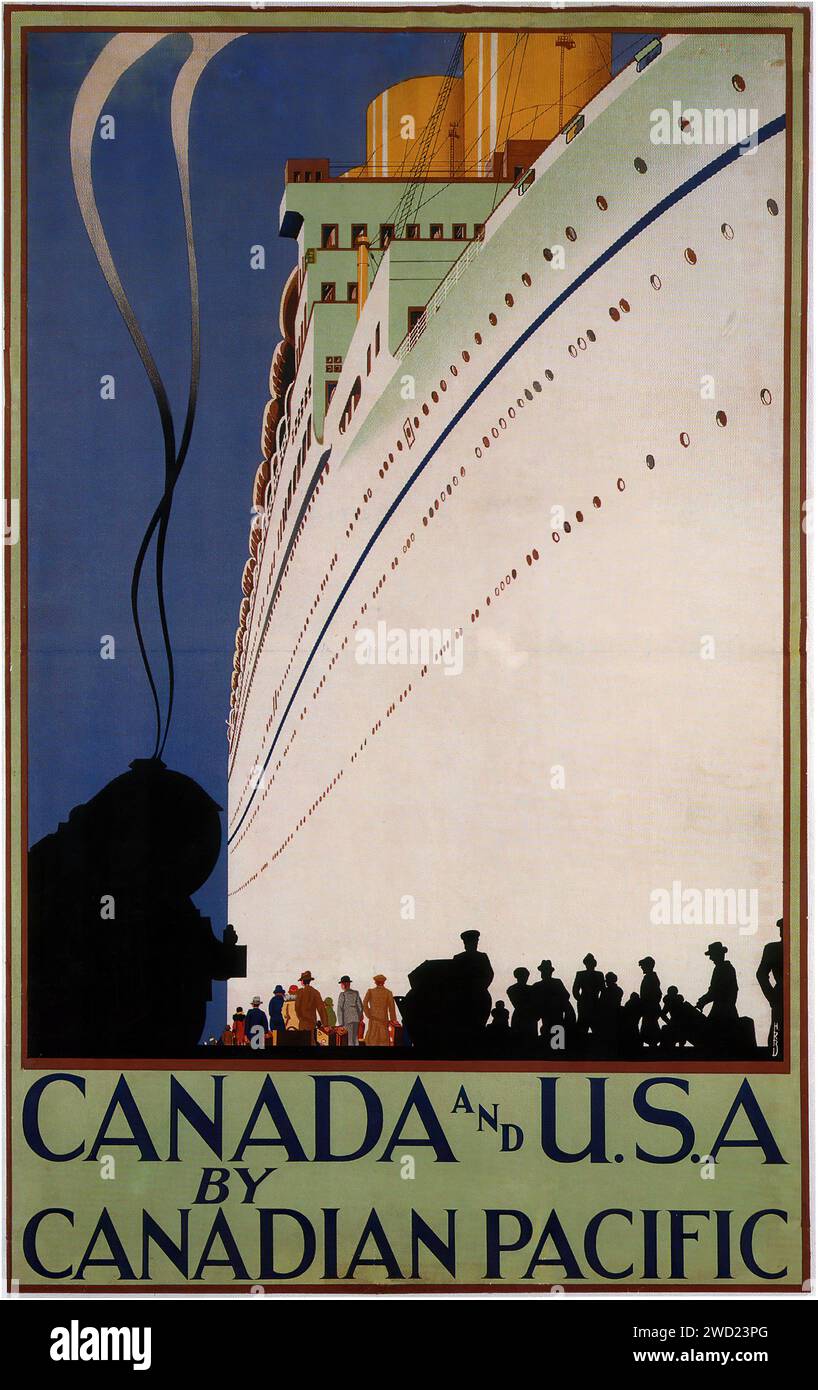 The 1931 Canadian Pacific poster depicts a grand ocean liner with its funnels releasing smoke, signifying its readiness for voyage. In the foreground, a group of silhouetted figures stands, suggesting passengers awaiting embarkation. The poster communicates luxury and the promise of adventure between Canada and the USA. This poster features a streamlined design typical of the late Art Deco period, with emphasis on the sleekness of modern machinery and the elegance of travel. Stock Photohttps://www.alamy.com/image-license-details/?v=1https://www.alamy.com/the-1931-canadian-pacific-poster-depicts-a-grand-ocean-liner-with-its-funnels-releasing-smoke-signifying-its-readiness-for-voyage-in-the-foreground-a-group-of-silhouetted-figures-stands-suggesting-passengers-awaiting-embarkation-the-poster-communicates-luxury-and-the-promise-of-adventure-between-canada-and-the-usa-this-poster-features-a-streamlined-design-typical-of-the-late-art-deco-period-with-emphasis-on-the-sleekness-of-modern-machinery-and-the-elegance-of-travel-image593189928.html
The 1931 Canadian Pacific poster depicts a grand ocean liner with its funnels releasing smoke, signifying its readiness for voyage. In the foreground, a group of silhouetted figures stands, suggesting passengers awaiting embarkation. The poster communicates luxury and the promise of adventure between Canada and the USA. This poster features a streamlined design typical of the late Art Deco period, with emphasis on the sleekness of modern machinery and the elegance of travel. Stock Photohttps://www.alamy.com/image-license-details/?v=1https://www.alamy.com/the-1931-canadian-pacific-poster-depicts-a-grand-ocean-liner-with-its-funnels-releasing-smoke-signifying-its-readiness-for-voyage-in-the-foreground-a-group-of-silhouetted-figures-stands-suggesting-passengers-awaiting-embarkation-the-poster-communicates-luxury-and-the-promise-of-adventure-between-canada-and-the-usa-this-poster-features-a-streamlined-design-typical-of-the-late-art-deco-period-with-emphasis-on-the-sleekness-of-modern-machinery-and-the-elegance-of-travel-image593189928.htmlRM2WD23PG–The 1931 Canadian Pacific poster depicts a grand ocean liner with its funnels releasing smoke, signifying its readiness for voyage. In the foreground, a group of silhouetted figures stands, suggesting passengers awaiting embarkation. The poster communicates luxury and the promise of adventure between Canada and the USA. This poster features a streamlined design typical of the late Art Deco period, with emphasis on the sleekness of modern machinery and the elegance of travel.
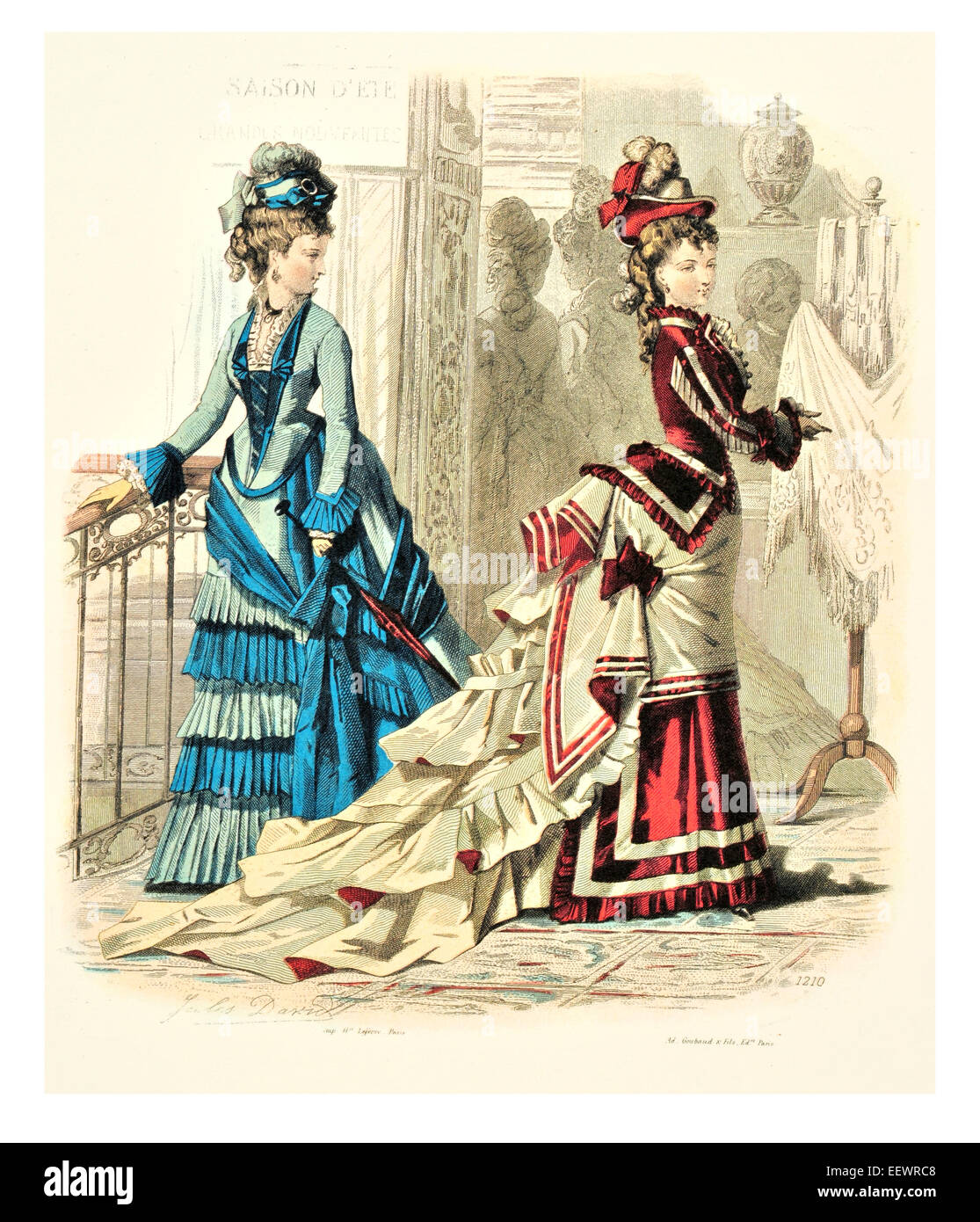 La Mode Illustree Victorian era period costume fashion dress gown gowns skirt veil cuff frills muslin cap embroidery embroidered Stock Photohttps://www.alamy.com/image-license-details/?v=1https://www.alamy.com/stock-photo-la-mode-illustree-victorian-era-period-costume-fashion-dress-gown-78013832.html
La Mode Illustree Victorian era period costume fashion dress gown gowns skirt veil cuff frills muslin cap embroidery embroidered Stock Photohttps://www.alamy.com/image-license-details/?v=1https://www.alamy.com/stock-photo-la-mode-illustree-victorian-era-period-costume-fashion-dress-gown-78013832.htmlRMEEWRC8–La Mode Illustree Victorian era period costume fashion dress gown gowns skirt veil cuff frills muslin cap embroidery embroidered
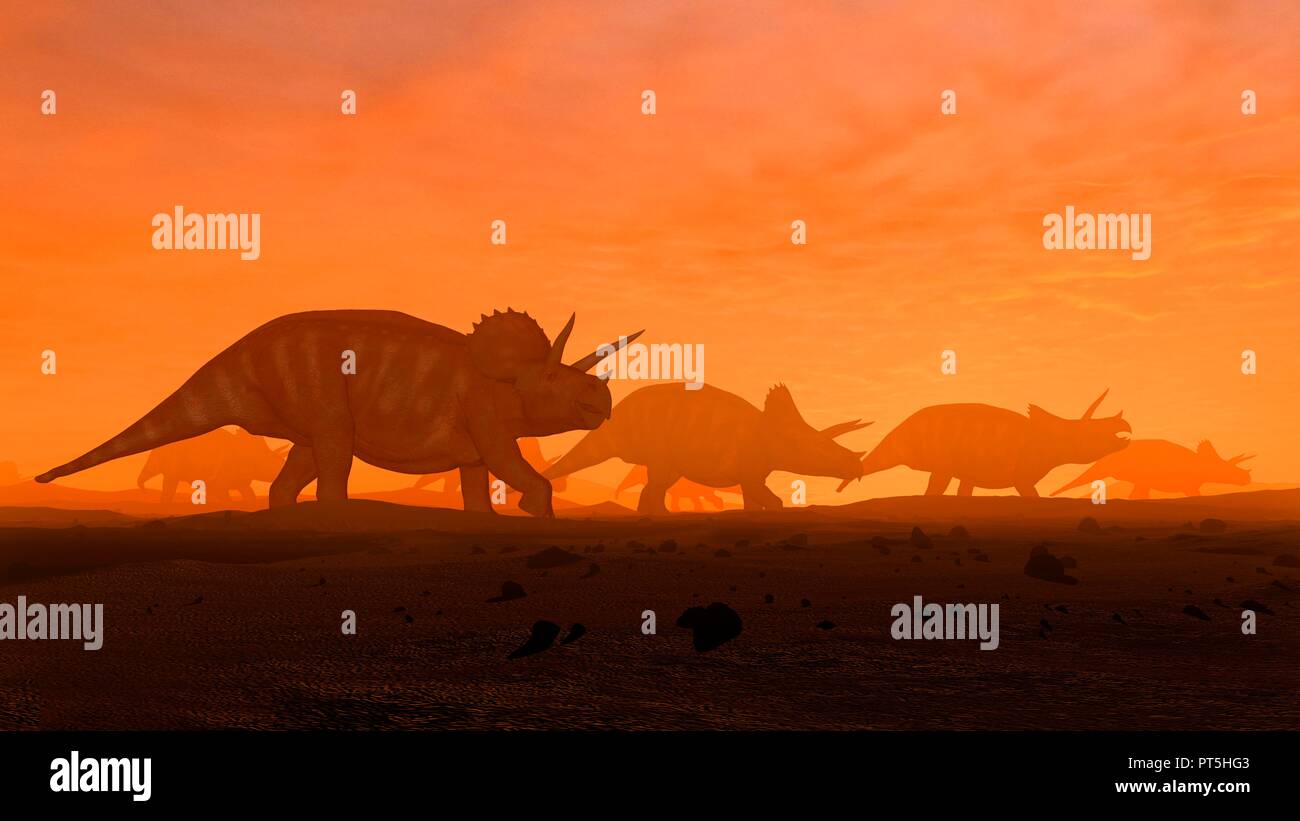 Illustration of a herd of triceratops dinosaurs. These animals were common in the late Cretaceous period, from around 70 million years ago until the extinction of the dinosaurs some 65 million years ago. Triceratops was a herbivorous dinosaur that could reach a length of up to nine metres. It used its horns and its neck shield to defend itself against attack. Like modern plains animals, they may have lived in herds, in what is now North America. Stock Photohttps://www.alamy.com/image-license-details/?v=1https://www.alamy.com/illustration-of-a-herd-of-triceratops-dinosaurs-these-animals-were-common-in-the-late-cretaceous-period-from-around-70-million-years-ago-until-the-extinction-of-the-dinosaurs-some-65-million-years-ago-triceratops-was-a-herbivorous-dinosaur-that-could-reach-a-length-of-up-to-nine-metres-it-used-its-horns-and-its-neck-shield-to-defend-itself-against-attack-like-modern-plains-animals-they-may-have-lived-in-herds-in-what-is-now-north-america-image221399699.html
Illustration of a herd of triceratops dinosaurs. These animals were common in the late Cretaceous period, from around 70 million years ago until the extinction of the dinosaurs some 65 million years ago. Triceratops was a herbivorous dinosaur that could reach a length of up to nine metres. It used its horns and its neck shield to defend itself against attack. Like modern plains animals, they may have lived in herds, in what is now North America. Stock Photohttps://www.alamy.com/image-license-details/?v=1https://www.alamy.com/illustration-of-a-herd-of-triceratops-dinosaurs-these-animals-were-common-in-the-late-cretaceous-period-from-around-70-million-years-ago-until-the-extinction-of-the-dinosaurs-some-65-million-years-ago-triceratops-was-a-herbivorous-dinosaur-that-could-reach-a-length-of-up-to-nine-metres-it-used-its-horns-and-its-neck-shield-to-defend-itself-against-attack-like-modern-plains-animals-they-may-have-lived-in-herds-in-what-is-now-north-america-image221399699.htmlRFPT5HG3–Illustration of a herd of triceratops dinosaurs. These animals were common in the late Cretaceous period, from around 70 million years ago until the extinction of the dinosaurs some 65 million years ago. Triceratops was a herbivorous dinosaur that could reach a length of up to nine metres. It used its horns and its neck shield to defend itself against attack. Like modern plains animals, they may have lived in herds, in what is now North America.
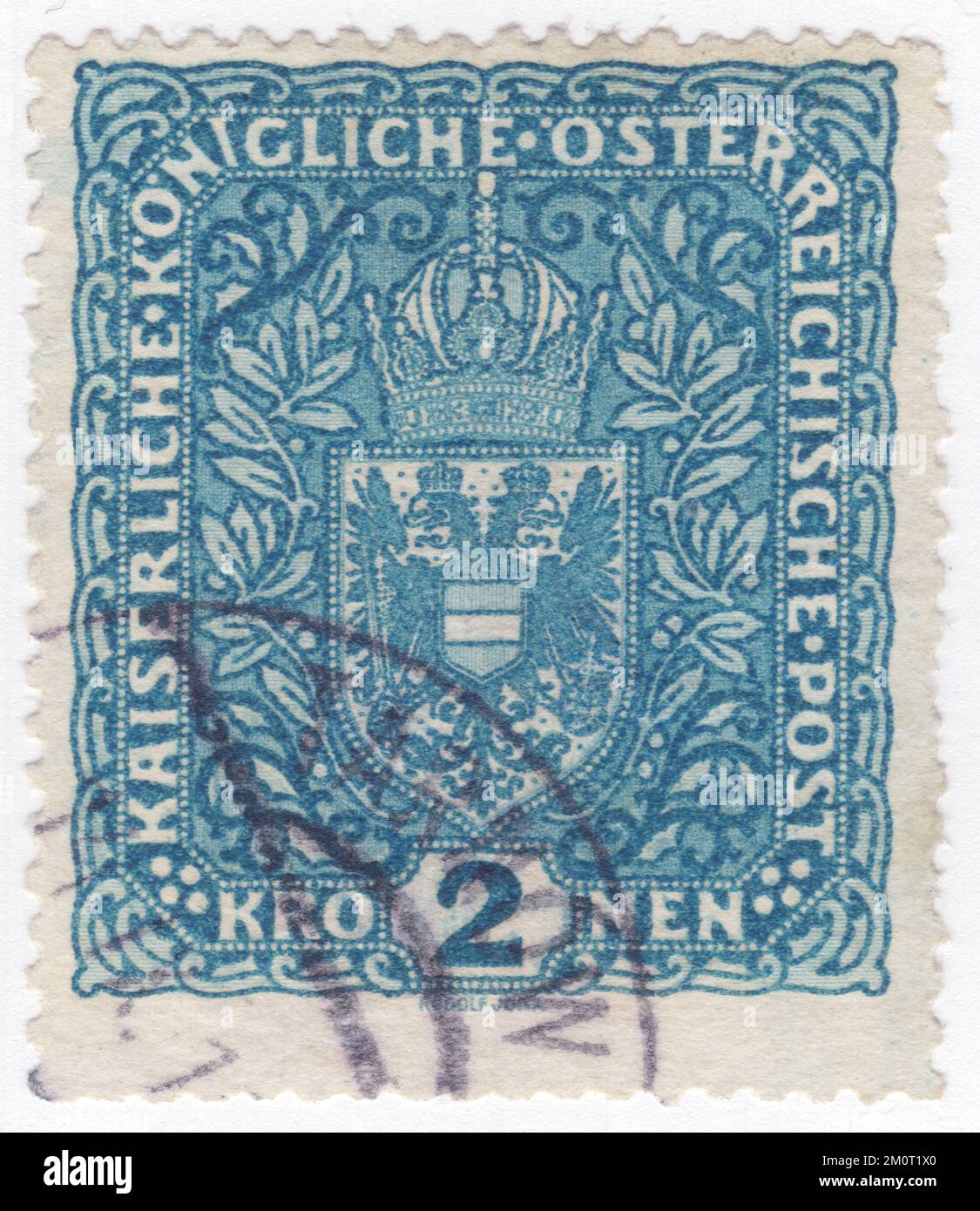 AUSTRIA — 1916: An 2 krone dark blue postage stamp depicting Coat of Arms of the Austrian monarchy. The double-headed eagle of the ruling House of Habsburg-Lorraine was used by the common Imperial and Royal (k. u. k.) institutions of Austria-Hungary or the dual monarchy. double-headed eagle (or double-eagle) is a charge associated with the concept of Empire. Most modern uses of the symbol are directly or indirectly associated with its use by the late Byzantine Empire, originally a dynastic emblem of the Palaiologoi. It was adopted during the Late Medieval to Early Modern period Stock Photohttps://www.alamy.com/image-license-details/?v=1https://www.alamy.com/austria-1916-an-2-krone-dark-blue-postage-stamp-depicting-coat-of-arms-of-the-austrian-monarchy-the-double-headed-eagle-of-the-ruling-house-of-habsburg-lorraine-was-used-by-the-common-imperial-and-royal-k-u-k-institutions-of-austria-hungary-or-the-dual-monarchy-double-headed-eagle-or-double-eagle-is-a-charge-associated-with-the-concept-of-empire-most-modern-uses-of-the-symbol-are-directly-or-indirectly-associated-with-its-use-by-the-late-byzantine-empire-originally-a-dynastic-emblem-of-the-palaiologoi-it-was-adopted-during-the-late-medieval-to-early-modern-period-image499629032.html
AUSTRIA — 1916: An 2 krone dark blue postage stamp depicting Coat of Arms of the Austrian monarchy. The double-headed eagle of the ruling House of Habsburg-Lorraine was used by the common Imperial and Royal (k. u. k.) institutions of Austria-Hungary or the dual monarchy. double-headed eagle (or double-eagle) is a charge associated with the concept of Empire. Most modern uses of the symbol are directly or indirectly associated with its use by the late Byzantine Empire, originally a dynastic emblem of the Palaiologoi. It was adopted during the Late Medieval to Early Modern period Stock Photohttps://www.alamy.com/image-license-details/?v=1https://www.alamy.com/austria-1916-an-2-krone-dark-blue-postage-stamp-depicting-coat-of-arms-of-the-austrian-monarchy-the-double-headed-eagle-of-the-ruling-house-of-habsburg-lorraine-was-used-by-the-common-imperial-and-royal-k-u-k-institutions-of-austria-hungary-or-the-dual-monarchy-double-headed-eagle-or-double-eagle-is-a-charge-associated-with-the-concept-of-empire-most-modern-uses-of-the-symbol-are-directly-or-indirectly-associated-with-its-use-by-the-late-byzantine-empire-originally-a-dynastic-emblem-of-the-palaiologoi-it-was-adopted-during-the-late-medieval-to-early-modern-period-image499629032.htmlRF2M0T1X0–AUSTRIA — 1916: An 2 krone dark blue postage stamp depicting Coat of Arms of the Austrian monarchy. The double-headed eagle of the ruling House of Habsburg-Lorraine was used by the common Imperial and Royal (k. u. k.) institutions of Austria-Hungary or the dual monarchy. double-headed eagle (or double-eagle) is a charge associated with the concept of Empire. Most modern uses of the symbol are directly or indirectly associated with its use by the late Byzantine Empire, originally a dynastic emblem of the Palaiologoi. It was adopted during the Late Medieval to Early Modern period
 Heart Scarab. Egypt, New Kingdom - Late Period (1569 - 525 BCE) or modern. Sculpture. Sandstone Stock Photohttps://www.alamy.com/image-license-details/?v=1https://www.alamy.com/heart-scarab-egypt-new-kingdom-late-period-1569-525-bce-or-modern-sculpture-sandstone-image464669624.html
Heart Scarab. Egypt, New Kingdom - Late Period (1569 - 525 BCE) or modern. Sculpture. Sandstone Stock Photohttps://www.alamy.com/image-license-details/?v=1https://www.alamy.com/heart-scarab-egypt-new-kingdom-late-period-1569-525-bce-or-modern-sculpture-sandstone-image464669624.htmlRM2HYYERM–Heart Scarab. Egypt, New Kingdom - Late Period (1569 - 525 BCE) or modern. Sculpture. Sandstone
 Romford Essex England. Photographed July 1970 but scans made in 2017 Small market town to the east of London embraces modern architecture from the late 1960's to 1970. Stock Photohttps://www.alamy.com/image-license-details/?v=1https://www.alamy.com/stock-image-romford-essex-england-photographed-july-1970-but-scans-made-in-2017-168547271.html
Romford Essex England. Photographed July 1970 but scans made in 2017 Small market town to the east of London embraces modern architecture from the late 1960's to 1970. Stock Photohttps://www.alamy.com/image-license-details/?v=1https://www.alamy.com/stock-image-romford-essex-england-photographed-july-1970-but-scans-made-in-2017-168547271.htmlRMKP5YNB–Romford Essex England. Photographed July 1970 but scans made in 2017 Small market town to the east of London embraces modern architecture from the late 1960's to 1970.
RFGP898J–Red clock icon over a blue bokeh background. Time concept illustration
 Giacomo Antonio Domenico Michele Secondo Maria Puccini (December 22, 1858 - November 29, 1924) was an Italian composer whose operas are among the important operas played as standards. His career extended from the end of the Romantic period into the modern Stock Photohttps://www.alamy.com/image-license-details/?v=1https://www.alamy.com/stock-photo-giacomo-antonio-domenico-michele-secondo-maria-puccini-december-22-104020055.html
Giacomo Antonio Domenico Michele Secondo Maria Puccini (December 22, 1858 - November 29, 1924) was an Italian composer whose operas are among the important operas played as standards. His career extended from the end of the Romantic period into the modern Stock Photohttps://www.alamy.com/image-license-details/?v=1https://www.alamy.com/stock-photo-giacomo-antonio-domenico-michele-secondo-maria-puccini-december-22-104020055.htmlRMG16EHY–Giacomo Antonio Domenico Michele Secondo Maria Puccini (December 22, 1858 - November 29, 1924) was an Italian composer whose operas are among the important operas played as standards. His career extended from the end of the Romantic period into the modern
 String of 12 Eye Beads, Late Period–Ptolemaic Period, 6th–3rd century BC, From Egypt, Glass, L. 22.2 cm (8 3/4 in.), Mosaic Stock Photohttps://www.alamy.com/image-license-details/?v=1https://www.alamy.com/stock-image-string-of-12-eye-beads-late-periodptolemaic-period-6th3rd-century-162326924.html
String of 12 Eye Beads, Late Period–Ptolemaic Period, 6th–3rd century BC, From Egypt, Glass, L. 22.2 cm (8 3/4 in.), Mosaic Stock Photohttps://www.alamy.com/image-license-details/?v=1https://www.alamy.com/stock-image-string-of-12-eye-beads-late-periodptolemaic-period-6th3rd-century-162326924.htmlRMKC2HJ4–String of 12 Eye Beads, Late Period–Ptolemaic Period, 6th–3rd century BC, From Egypt, Glass, L. 22.2 cm (8 3/4 in.), Mosaic
 An ancient Egyptian statuette of the Horus falcon, Late Period, mid- to 2nd half of the 1st millennium BC Bronze falcon with double crown. The circular gold inlay of the right eye has been preserved. The surface slightly corroded, therein visible the lines of the former chiselling to depict the plumage. The talons and the lower parts of the legs are broken off. On a modern wooden base. Height without base 15 cm. Appealing, expressive small-scale sculpture. Provenance: 1970s private collection from the Munich areas. historic, historical, ancient w, Additional-Rights-Clearance-Info-Not-Available Stock Photohttps://www.alamy.com/image-license-details/?v=1https://www.alamy.com/an-ancient-egyptian-statuette-of-the-horus-falcon-late-period-mid-to-2nd-half-of-the-1st-millennium-bc-bronze-falcon-with-double-crown-the-circular-gold-inlay-of-the-right-eye-has-been-preserved-the-surface-slightly-corroded-therein-visible-the-lines-of-the-former-chiselling-to-depict-the-plumage-the-talons-and-the-lower-parts-of-the-legs-are-broken-off-on-a-modern-wooden-base-height-without-base-15-cm-appealing-expressive-small-scale-sculpture-provenance-1970s-private-collection-from-the-munich-areas-historic-historical-ancient-w-additional-rights-clearance-info-not-available-image246352805.html
An ancient Egyptian statuette of the Horus falcon, Late Period, mid- to 2nd half of the 1st millennium BC Bronze falcon with double crown. The circular gold inlay of the right eye has been preserved. The surface slightly corroded, therein visible the lines of the former chiselling to depict the plumage. The talons and the lower parts of the legs are broken off. On a modern wooden base. Height without base 15 cm. Appealing, expressive small-scale sculpture. Provenance: 1970s private collection from the Munich areas. historic, historical, ancient w, Additional-Rights-Clearance-Info-Not-Available Stock Photohttps://www.alamy.com/image-license-details/?v=1https://www.alamy.com/an-ancient-egyptian-statuette-of-the-horus-falcon-late-period-mid-to-2nd-half-of-the-1st-millennium-bc-bronze-falcon-with-double-crown-the-circular-gold-inlay-of-the-right-eye-has-been-preserved-the-surface-slightly-corroded-therein-visible-the-lines-of-the-former-chiselling-to-depict-the-plumage-the-talons-and-the-lower-parts-of-the-legs-are-broken-off-on-a-modern-wooden-base-height-without-base-15-cm-appealing-expressive-small-scale-sculpture-provenance-1970s-private-collection-from-the-munich-areas-historic-historical-ancient-w-additional-rights-clearance-info-not-available-image246352805.htmlRMT8P9ED–An ancient Egyptian statuette of the Horus falcon, Late Period, mid- to 2nd half of the 1st millennium BC Bronze falcon with double crown. The circular gold inlay of the right eye has been preserved. The surface slightly corroded, therein visible the lines of the former chiselling to depict the plumage. The talons and the lower parts of the legs are broken off. On a modern wooden base. Height without base 15 cm. Appealing, expressive small-scale sculpture. Provenance: 1970s private collection from the Munich areas. historic, historical, ancient w, Additional-Rights-Clearance-Info-Not-Available
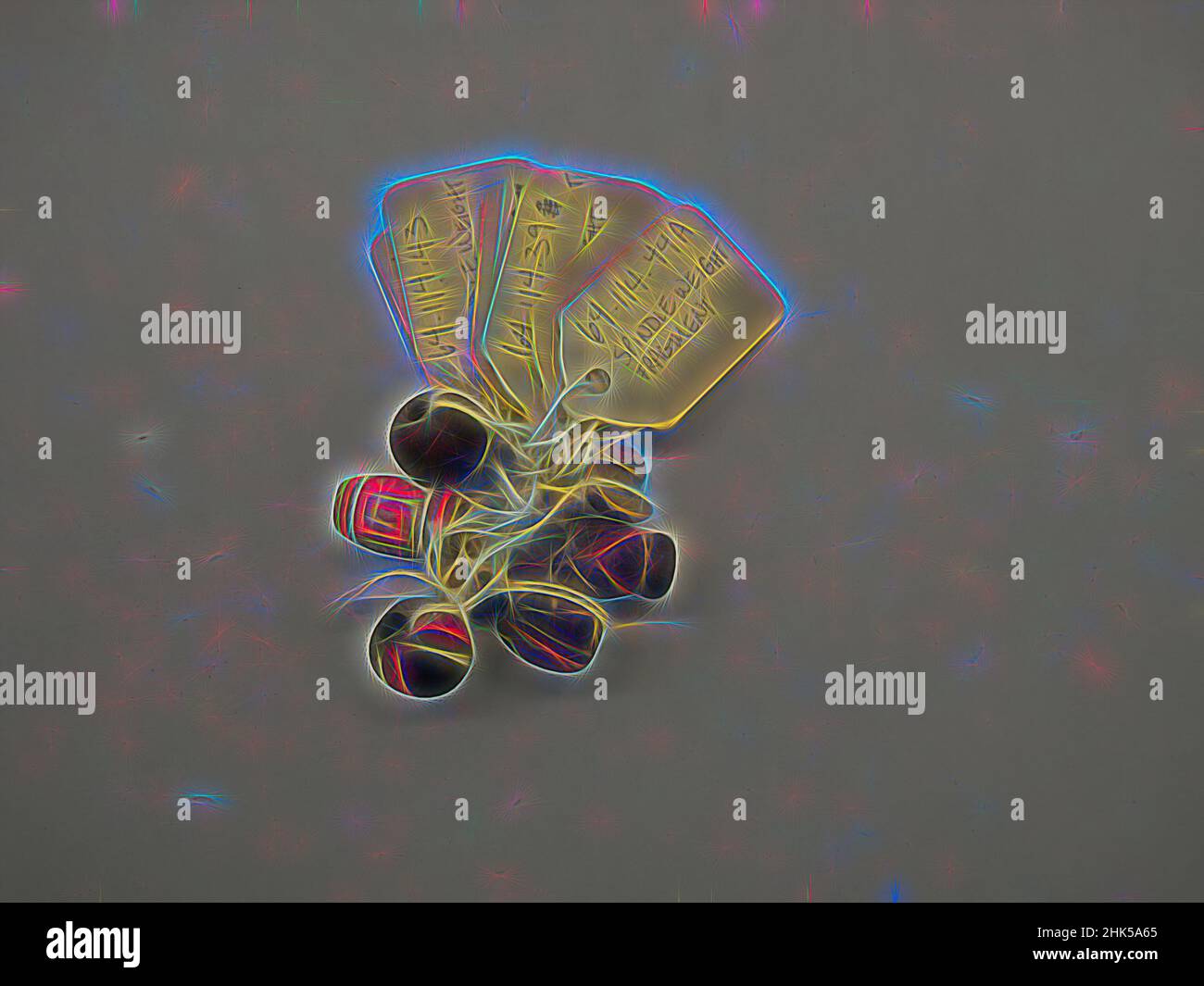 Inspired by Spindle Whorl, Ceramic, 1000-1532, Late Horizon or Late Intermediate Period, Reimagined by Artotop. Classic art reinvented with a modern twist. Design of warm cheerful glowing of brightness and light ray radiance. Photography inspired by surrealism and futurism, embracing dynamic energy of modern technology, movement, speed and revolutionize culture Stock Photohttps://www.alamy.com/image-license-details/?v=1https://www.alamy.com/inspired-by-spindle-whorl-ceramic-1000-1532-late-horizon-or-late-intermediate-period-reimagined-by-artotop-classic-art-reinvented-with-a-modern-twist-design-of-warm-cheerful-glowing-of-brightness-and-light-ray-radiance-photography-inspired-by-surrealism-and-futurism-embracing-dynamic-energy-of-modern-technology-movement-speed-and-revolutionize-culture-image459265805.html
Inspired by Spindle Whorl, Ceramic, 1000-1532, Late Horizon or Late Intermediate Period, Reimagined by Artotop. Classic art reinvented with a modern twist. Design of warm cheerful glowing of brightness and light ray radiance. Photography inspired by surrealism and futurism, embracing dynamic energy of modern technology, movement, speed and revolutionize culture Stock Photohttps://www.alamy.com/image-license-details/?v=1https://www.alamy.com/inspired-by-spindle-whorl-ceramic-1000-1532-late-horizon-or-late-intermediate-period-reimagined-by-artotop-classic-art-reinvented-with-a-modern-twist-design-of-warm-cheerful-glowing-of-brightness-and-light-ray-radiance-photography-inspired-by-surrealism-and-futurism-embracing-dynamic-energy-of-modern-technology-movement-speed-and-revolutionize-culture-image459265805.htmlRF2HK5A65–Inspired by Spindle Whorl, Ceramic, 1000-1532, Late Horizon or Late Intermediate Period, Reimagined by Artotop. Classic art reinvented with a modern twist. Design of warm cheerful glowing of brightness and light ray radiance. Photography inspired by surrealism and futurism, embracing dynamic energy of modern technology, movement, speed and revolutionize culture
 Modern payrus depicting the Dendera zodiac (or Denderah zodiac), an Egyptian bas-relief from the ceiling of the pronaos (or portico) of a chapel dedicated to Osiris in the Hathor temple at Dendera, containing images of Taurus (the bull) and Libra (the scales). This chapel was begun in the late Ptolemaic period; its pronaos was added by the emperor Tiberius. 2nd century AD Stock Photohttps://www.alamy.com/image-license-details/?v=1https://www.alamy.com/modern-payrus-depicting-the-dendera-zodiac-or-denderah-zodiac-an-egyptian-bas-relief-from-the-ceiling-of-the-pronaos-or-portico-of-a-chapel-dedicated-to-osiris-in-the-hathor-temple-at-dendera-containing-images-of-taurus-the-bull-and-libra-the-scales-this-chapel-was-begun-in-the-late-ptolemaic-period-its-pronaos-was-added-by-the-emperor-tiberius-2nd-century-ad-image634139526.html
Modern payrus depicting the Dendera zodiac (or Denderah zodiac), an Egyptian bas-relief from the ceiling of the pronaos (or portico) of a chapel dedicated to Osiris in the Hathor temple at Dendera, containing images of Taurus (the bull) and Libra (the scales). This chapel was begun in the late Ptolemaic period; its pronaos was added by the emperor Tiberius. 2nd century AD Stock Photohttps://www.alamy.com/image-license-details/?v=1https://www.alamy.com/modern-payrus-depicting-the-dendera-zodiac-or-denderah-zodiac-an-egyptian-bas-relief-from-the-ceiling-of-the-pronaos-or-portico-of-a-chapel-dedicated-to-osiris-in-the-hathor-temple-at-dendera-containing-images-of-taurus-the-bull-and-libra-the-scales-this-chapel-was-begun-in-the-late-ptolemaic-period-its-pronaos-was-added-by-the-emperor-tiberius-2nd-century-ad-image634139526.htmlRM2YRKFC6–Modern payrus depicting the Dendera zodiac (or Denderah zodiac), an Egyptian bas-relief from the ceiling of the pronaos (or portico) of a chapel dedicated to Osiris in the Hathor temple at Dendera, containing images of Taurus (the bull) and Libra (the scales). This chapel was begun in the late Ptolemaic period; its pronaos was added by the emperor Tiberius. 2nd century AD